




S ince April is the last edition of the newspaper the current seniors work on, this will be my final column in The ReMarker . It’s so sad I have to finish at such a dramatic and tense political moment.
Can’t you just feel the suspense in the air? The big players have already announced their Presidential campaigns: Marianne Williamson, Robert F. Kennedy Jr. (the anti-vax Kennedy, not one of the dead ones or the one QAnon says is alive) and Asa Hutchinson. There’s even a weeklong news cycle about a potential Donald Trump mugshot! Personally, I’m dying to finally see what his face looks like.
But despite today’s excitement, it’s time to look into the future. It’s time for a prediction for 2023 and beyond. I’ll just go with an obvious one: Joe Biden will be President of the United States of America in the year of our Lord 2029. This is made up of a bunch of other predictions. First of all, Trump is going to win the 2024 primary.
It’s really funny that the Wall Street Journal and National Review types still think they have any control over their own party. It’s even funnier that they think their secret weapon to finally restore the Grand Old Party to the grand old cause of low corporate taxes and gassing Iraqi villages or a soft-spoken Yale man from the home of Marco Rubio and Jeb Bush. To them, I offer two words: “Meatball Ron.”
I really thought Trump had lost his nickname power when he tried to make “DeSanctimonious” happen. But thinking of “Meatball Ron” is the comeback of the year. How will DeSantis recover from this? Here’s a preview of the Republican primary:
Ron: “I’m the candidate in this primary not under multiple criminal investigations.” Don: “The Deep State doesn’t even care enough to go after MEATBALL RON!”
Ron: “I didn’t lead a mob to overthrow the U.S. government.” Don: “MEATBALL RON is too lost in the spaghetti sauce to lead a QAnon rally!” (Don proceeds to win 78% of the Republicans in Iowa).
And in the political equivalent of Golden State and Cleveland in the NBA Finals, you already know what’s going to happen in Biden vs. Trump 2: They’re Even Less Coherent Now. We truly live in a country.
With the school year coming to a close, many seniors have started to ease up on their school work. We examined why they should keep on fighting.
See coverage, page 7
LITERARY FESTIVAL Sophomore

Lukas Palys will be the Literary Festival student chair next year, and sophomores Gavin Bowles and Aidan Moran will serve as the cochairs. The faculty sponsor is Victor F. White Master Teacher and English instructor David Brown. The Literary Festival takes place every January, and four or five accredited people with professions in a literary field visit classes, give lectures and speak in front of the Upper School in a panel discussion lasting an hour. This year, the Literary Festival student chair was junior Grayson Redmond, and the co-chairs were juniors John Ma and Sid Bidare.
YOUNG AMERICAN TALENT
Nine Marksmen’s art pieces were accepted into Young American Talent, a North Texas regional art competition and exhibition hosted by the Booker T. Washington High School for the Performing and Visual Arts. Several students
in the Photography, Ceramics and Drawing and Painting classes submitted pieces to be considered for the competition. Young American Talent is considered to be highly selective, as only 159 pieces were chosen out of over 1,400 submissions. All accepted art pieces will be showcased at the Booker T. Washington High School on May 18.
SENIOR PARENT DINNER
The Senior Parent Dinner took place April 3 at 6:30 p.m. This dinner included parents, advisors and teachers, and was set up and managed by the Parents Association. The point of this dinner was to inform parents about important dates for seniors later this year such as Graduation, Marksmen Ball and Commencement.
SIXTH GRADE CAMPOUT The annual sixth grade campout took place east of Dallas at Mill Creek
Breaking down this month’s hot topics.
What happened: TikTok CEO Shou Zi Chew testifies before Congress.
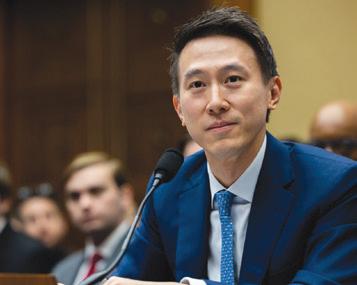
When: March 23
Farm from March 30-31. Unlike other camping trips, students did not do any backpacking. Instead, they focused on building basic outdoors skills. Students participated in a variety of outdoor activities like fishing, outdoor cooking, orienteering, knot tying and shelter construction. This trip was the grade's first collective camping experience as they begin preparing for the iconic Pecos trip.
NATIONAL SPANISH EXAM The National Spanish Exam (NSE) is a standarized test that is administered to Marksmen taking Spanish I and up. The test comes with the opportunity to earn prizes and awards depending on how students perform compared to a national percentile. The test has six levels, and all students in either AP or Honors courses are required to take it. It will be administered to students in a one-week window towards the end of the school year.
The ins and outs of the school’s financial aid system.


How St. Mark’s transforms boys into better fathers, brothers and men.
A follow-up from last issue’s coverage on the nation’s most dangerous drug.
Importance and relevance: The massive media company, accused of having links to the Chinese government, is put on trial.
What happened: A shooting at The Covenant School in Tennessee
When: March 27
Importance and relevance: Twenty-eight year old Aiden Hale shot and killed six people at random, including Head of School Katherine Koonce.
What happened: Finland joins NATO as the 31st member.

When: April 4
Importance and relevance: Finnish, Nordic and NATO security will be strenghtened by this alliance, in light of Putin's attempts to undermine the organization.
What happened: Former U.S. President Donald Trump indicted for multiple instances of business fraud.

When: March 30
Importance and relevance: The 45th President was formally accused by a Manhattan grand jury for his role in attempting to cover up payments made to multiple different adult film stars. The scheme stems from Trump’s actions prior to the 2016 presidential election.
The school is focused on providing opportunities to every young man who deserves a spot on campus, and financial aid is an integral part of making that happen.
Committed to diversity in the socioeconomic backgrounds of its students, St. Mark’s seeks to offer an extensive financial aid program that allows all qualified applicants to get a St. Mark’s education, whatever their financial situation may be.
Emblazoned on the walls of Graduate Hall are the names of thousands of Marksmen who have passed through 10600 Preston Road. They all had a part to play in the story of the school: SPC winners, set designers, Student Council representatives, gifted piano players and some students who left no apparent legacy whose kindness and effort helped to make a class of young men into a brotherhood helped mold the school into the institution it is today.
Today, students whose names will be engraved into the wall one day still define the campus atmosphere. They mill about on the quad at all hours of the day. They listen attentively to Father Arbogast in chapel services each week. They are easily recognizable in their white shirts and grey shorts – never the long variety –and seniors especially so being all decked out in blue.
And yet, for many boys integral to our community, none of this would be their reality if not for one of the school’s key initiatives. Without financial aid, their contributions to campus would be missed, they would never cross the stage at Commencement and their names would never adorn those wooden panels in Graduate Hall.
The financial aid program, now such an integral part of St. Mark’s, did not always exist. Rather, according to Director of Development Tim Crouch, the school’s program can be traced back several decades to the generous gifts of two of the school’s most influential donors.
“In many ways, we stand on the shoulders of giants here,” Crouch said. “Two of those in our history are Eugene McDermott and Dr. Cecil Green, who over the course of three decades, starting in the 1950s, gave St. Mark’s $50 million
collectively, not adjusted for inflation. They set up the first financial aid endowment on campus and positioned us for success, and we enjoy that to this very day and we will for the rest of our history – neither of them had a boy attend the school.”
This endowment has only grown since these first donations years ago, leading to more resources being available for the financial aid program.
“Our total endowment, which is a moving figure, is determined by the markets, which are inherently volatile,” Assistant Headmaster for External Affairs Scott Jolly said. “In June 2022, it was around 150 million, and about 50 million of it is restricted for financial aid support. So tuition dollars aren’t used for financial aid, which isn’t like most schools which are tuition-driven and use those dollars for financial aid.”

According to Jolly, revenue from tuition and fees supports 75 percent of the operating budget exclusive of financial aid. It is these philanthropic sources, such as the St. Mark’s Fund and endowment funds established through major gifts, which make up that other 25 percent.

The financial aid program seeks to achieve two main goals: to provide the best prospective students a place on campus regardless of their financial situation and to ensure every admitted student is able to take full advantage of their time here. For example, many students may not be able to have full access to technology, hire tutoring services or attend school trips with their classmates due to their financial situation. These are all classified as “ancillary expenses” and are yet another factor the school seeks to tackle through financial aid.
“We think about ancillary expenses as key components like technology, tutoring and transportation,” Crouch said. “A lot of boys here are working late in the journalism suite or getting an early start first thing in the morning to come to work out. What does that look like if you’re coming from East Dallas or South Dallas? And if both parents are working during pick-up or drop-off without flexibility with work
hours, how does that limit their options? We try to keep a lot of these things in mind.”
In terms of admissions, the committee sets aside a student’s financial situation until later on in order to solely focus on identifying the best possible candidates for a spot at St. Mark’s.
“The admission committee is unaware of a family’s request for financial aid while reading and reviewing individual student applications,” Senior Associate Director of Admission and Financial Aid Anna Crouch said, “allowing them to solely focus on the boys and whether they would be a good fit for the St. Mark’s community. Fortunately, the financial aid budget usually covers the financial needs of the boys who are accepted.”
With this great resource available for applying families, the school has developed a new focus in recent years: ensuring that communities all around the city are aware of St. Mark’s and the opportunities it presents its students, whether they are on financial aid or not.
“That takes a little bit more creativity than just telling people to apply,” Anna Crouch said. “We have to make sure that families and whole communities that may not know about St. Mark’s are aware of all the opportunities that exist here.”
T
he Office of Development and Alumni Relations released the spring edition of The Pride magazine March 7. The biannual magazine, covering campus life, alumni news and student accomplishments, gets sent to the entire school community.
Under the leadership of Director of Communications and editr Ray Westbrook, the magazine underwent a major redesign for the first time in over ten years.
“It was much more than just choosing a new typeface,” Westbrook said. “We added new sections and rearranged others. We tried to keep the elements that were important to the magazine because we wanted to be respectful of what the community expects. However, at the same time, we tried to freshen it up a bit and give a whole new look to the magazine.”
The Pride Editorial Staff also innovated the way they created content for everyone in the community to enjoy.
“We added a new section called Conversations, which is all conversations held in first person,” Westbrook said. “There is a feature called Alumni Around the World where we interviewed three alums who went from 10600 Preston Road to wild places. There’s also a section in the magazine called 300 Words, where we took four people on campus that the average reader may or may not know and wrote a personality profile about them. One of them is one of the cafeteria managers who served tea to Queen Elizabeth. We’ve tried to bring in stories that interest alumni, but we also want the magazine to be read by students too.”
Additionally, the staff writes intriguing stories through staying in touch with the community.
“We have a fairly good pulse on what's happening on campus because just about any event or activity eventually comes through the Communications Office,” Westbrook said. “Personally, having taught in the classroom, I still remember the trajectory of the year and all the important things that go on at St. Mark’s.”
It was an extensive group effort to compose and publish the magazine in six months.
“The magazine is produced by the four of us on the communications team: Scott Moore, Dave Carden, Alex Hughes and me,” Westbrook said. “A lot of folks in the Development and Alumni Relations office also have input on the production. For example, the people working in alumni relations compile the class notes because they’re well-connected to the alumni base. Nearly everyone in the Development Office works on it in some way.”
The sophomores sat slumped over. With a bag of chips in hand, one of them stretched and yawned in his cushy Decherd chair as his other peers rushed in — late.
It was yet another assembly. One of more than five about the poor performance of the sophomore class. What did we do wrong this time?
These seven words echoed throughout — exchanged in whispers among friend groups.
Together, they were unified in annoyance.
Annoyance at their peers for lacking maturity.
Annoyance at their class leadership for making them lose their free community time.
Most just wanted to go. But they had to sit there.
And many left the assembly unchanged. Unfazed. The one sophomore, his hunger satiated, left the empty chip bag crumpled under his seat.
As for their Thursday community times, some student leaders of the Telos program see them as more of an opportunity to get Chicken Minis and less of an opportunity to passionately share their experiences with middle schoolers.
For some of those middle schoolers, leadership loops aren’t questions or projects to be thought about carefully. Just more boxes to be checked.
But still, many Marksmen graduate feeling they’ve been shaped into men of great character.
Feeling like the school has made a difference — a difference that will help them make an impact.
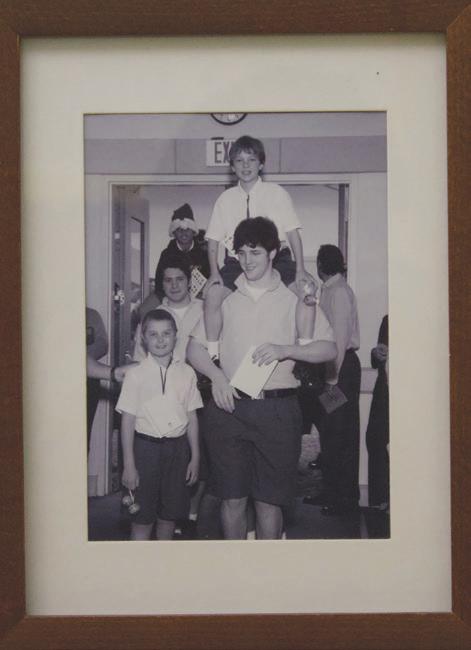
For 12-year Marksman and English instructor
Cameron Hillier ‘13, reading books assigned in class and discussing them began to help him understand and verbalize things he’s felt and experienced in life.
The character and leadership program had just started when he was an upperclassman. Joining the new Telos program as a senior, Hillier said there wasn’t much of a curriculum.
“It was more just like, ‘Hey, here's a senior hanging out with some sixth graders,” Hillier said. “Just be a good influence.’ That was really the extent of it.”
Hillier believes everyone can relate to and learn from each story he teaches.
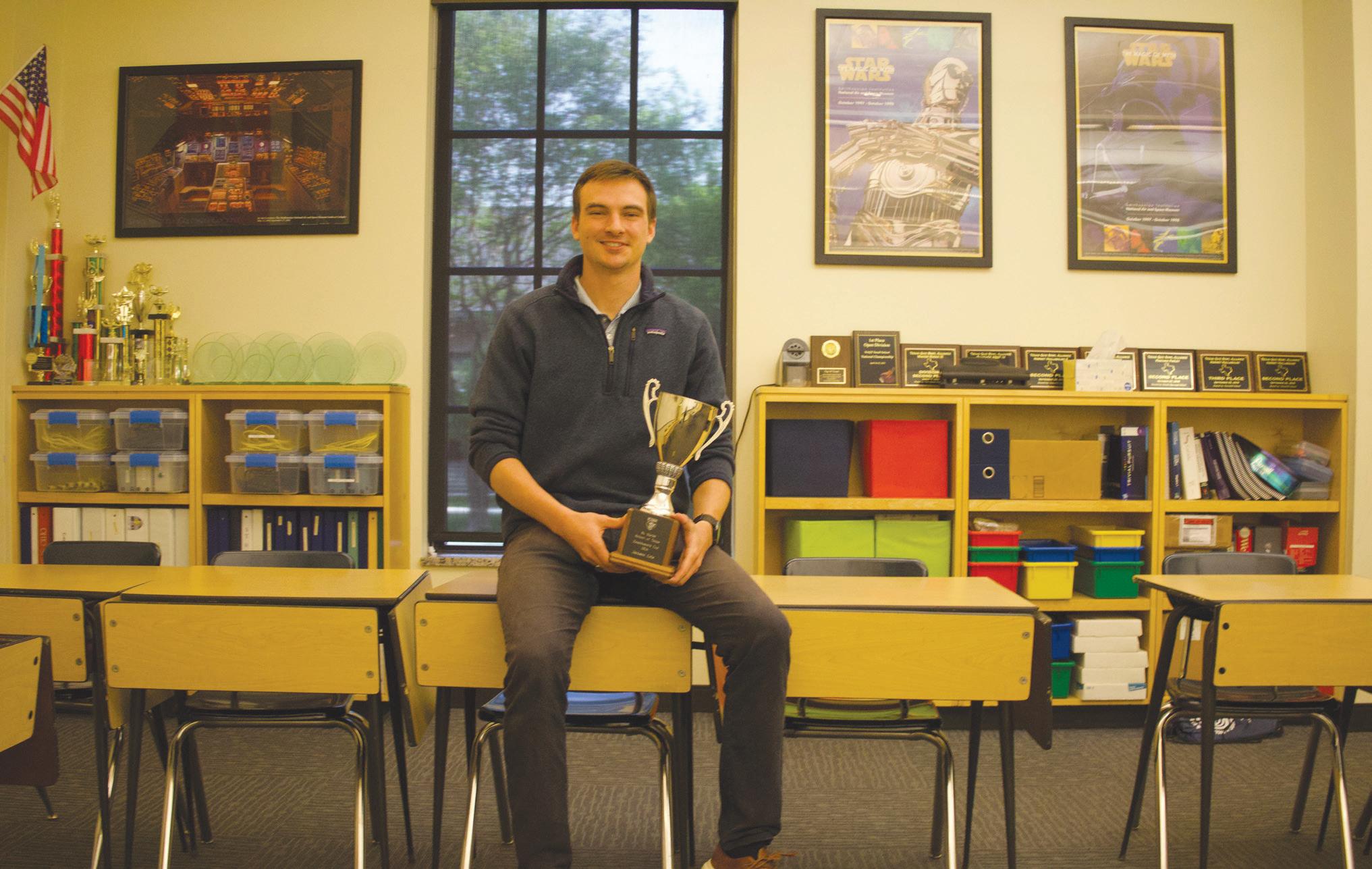
“Most of these characters are going to be extremes,” Hillier said. “But that's the point of fiction — you can push those characters to be on the far ends of the spectrum, to raise that point and to make it more evident.”
With all the books he’s read, Hillier can point out the different traits of good men.
“A good man, first and foremost is committed,” Hillier said. “He’s committed to the people around him. He’s committed to his communities and his
family. He doesn’t flake. He doesn't bail. He’s there. A good man knows himself and knows what he stands for. He needs to be confident in his identity. A good man ought to be incredibly self-sacrificial and constantly put others before himself. We live in a culture that's very much self-centered, the good man gives without counting the cost, and can just do it.”
At first, David Brown, Victor F. White Master Teacher, was not a big proponent of the character and leadership program. However, after some encouragement from founder Dr. Martin Stegmoeller, he decided to fully commit.

“I was actually a little resistant to [the program] at first,” Brown said. “But once I understood the vision and have it integrated with our existing curriculum, I was sold on it.”
However, Brown fully began believing in the program only when he started to teach it: namely, during the iconic family history paper all sophomores are required to write.
“When we go about the family history project, my requirement is that the boys not only think about the heritage that’s been handed down to them, but if they want to either continue or change it some way for themselves,” Brown said. “I also asked them to project into the future. ‘What do you want to do down the road? What are the virtues that would specifically develop you into a man of character, or someone that others could look to and learn from, and live more fulfilled lives?”
From these questions emerged the character and leadership vocabulary, which Brown still teaches to this day.
“We identify the most important virtues and discuss how we can apply them to our lives and how we can influence others with them,” Brown said. “We go through three terms a week, and each term is a virtue essential to being a good man. For example, we discuss ‘What does devotion mean? What does nobility mean? What does it mean to have fortitude, perseverance and stability? We look for these virtues in the characters we read about and discuss how we can apply them to our lives.”
Brown credits one man to have taken his information to heart: Jackson Cole ‘16. Having taught him throughout his high school career, Brown watched as Cole flourished into someone who found his place.
“Jackson came into my classroom as someone who hadn’t applied himself as much as he ought to,” Brown said. “However, with the character and leadership program that I and others encouraged him toward, he grew. It was amazing to watch him transform who he was at the beginning of his 10th grade year to who he was as a senior.”
Prior to his sophomore year, Cole wasn’t a bad student. However, though he accomplished everything he was asked to do, his problem was his mindset.
“I was a pretty typical student,” Cole said. “I had good grades, but my mindset was more of a scorer rather than a learner. I knew that getting good grades would make my parents happy and that it was just a good thing to do.”
Instead of focusing on the growth of his character, Cole was geared towards completing assignments one at a time. Instead of taking lessons to heart, Cole found it easier to not think too much.
“I didn’t think too critically as to what I was going to get out of my St. Mark’s education,” said Cole. “I didn’t think as to why my parents sacrificed so much for me to be here at St. Mark’s and why they thought that was a good thing. I was just a normal student, trying to do the best that I could, not too worried about the ultimate goal.”
Participating in classes wasn’t an opportunity for Cole, but rather a requirement.
“My mentality was that if my grades are fine, why should I care if I goof off or don’t participate as much?” Cole said. “If I needed to speak in order to get participation points, sure, I would talk in order to get those points. That’s what I was looking for. I was trying to check boxes rather than actively pursue getting the most I could get out of each class. For me, there wasn’t any point in pursuing anything further than just the bare minimum.”
Cole’s teachers also saw the same thing: a student who got his work done, but wasn’t an overachiever. They saw a student whose mind was sharp, but wasn’t curious for knowledge.
“The way some of my teachers described me is exactly how I would describe my previous self,” Cole said. “They said, ‘He seems to be doing the bare minimum and then quitting right after that’ and ‘He seems to be participating well, just well enough to earn him a good grade. But it doesn’t seem like there is an inquisitive mind.’”
However, even if his teachers criticized him for not going above and beyond, they still recognized his enormous potential it just had to be fulfilled.
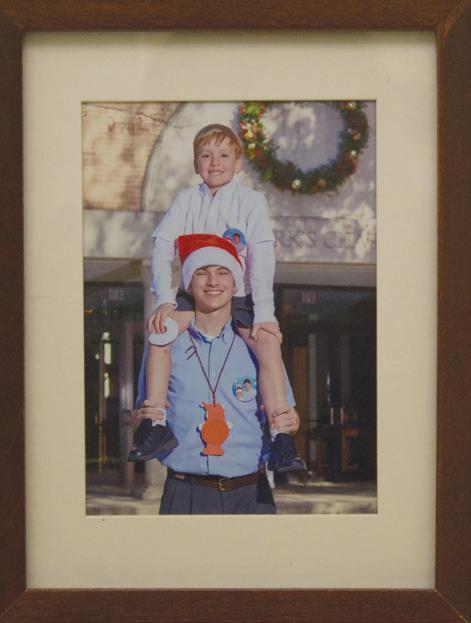
“I remember that all my teachers had said ‘Jackson could accomplish so much more if he dedicated himself to it,” Cole said. “They said that I was very much gunning for a certain number, and once I accomplished a task, I would immediately put on the brakes and lay off, just because I did what I was supposed to.”
In a state of academic limbo, Cole would receive
In the school s “About Us” section at the bottom of every page of its website are the following words: “St. Mark’s aims to prepare young men to assume leadership and responsibility in a competitive and changing world.” Since the beginning, the school’s purpose has been to cultivate men from boys in preparation for them to make an impact on the world. Is it working? We talked with alumni and teachers to find out.TO BECOME A MAN DAVID BROWN Victor F. White Master Teacher HISTORY Cole sits proudly with the Headmaster's Cup (left), an award he won in 2016. The award is one most prestigious given out by the school. Cole sits atop his senior buddy (top right). Cole carries his own senior buddy, Hank Vig '26. (bottom right). The tradition stretches beyond generations. PHOTOS / DAWSON YAO
a spark of motivation from a talk with nowretired science instructor Stephanie Barta.
“When I was a ninth grader, I was getting good grades in Ms. Barta’s class,” Cole said. “However, she kept encouraging me to do more with her class and its material. So one day, I went to her after class, and I said that I had heard that Dr. Perryman had spoken about leadership and ethics. So I told her that I might be interested in that if you know where I should start.”
With a student she liked approaching her about character, Barta was more than willing to help Cole.
“She was a teacher I trusted,” Cole said. “It could not have gone better; she she was so excited that I had expressed interest in anything other than just doing the bare minimum and just checking boxes. Next thing I knew, I was enrolled in the Telos program and was connected with Dr. Stegemoeller and told to go to philosophy club meetings. At that point, there was no going back.”
Just like that, his life had changed. Just like that, he was roped into a whole new world. Just like that, his future now looked completely different. Now, the process of checking boxes was going to get much harder.
“I remember that meeting with Ms. Barta vividly, knowing that things were going to change,” Cole said. “I don’t know how, but she really has pushed me into and helped me see new opportunities.”
Stegemoeller was a major part in his growth as well, as his club helped Cole to ask
himself difficult questions: ones that forced him to go above and beyond.
“[Dr. Stegemoeller’s Philosophy club] and I would have long conversations about what it meant to be a good man, a good student and learner,” Cole said. “About what it means to be focused on thriving, and not just on success in checking boxes as they come up? And I was able to see that there truly was a different way of being, and a thriving way of learning.”
In the end, Cole obviously chose the thriving path.
“I decided that I would have more fun if I went with the thriving option,” Cole said. “At some point, I started saying, ‘You know what, what if I actually went beyond the homework they gave us? What if I examined the problems I was confused about just a little bit more? I found that by doing that, I actually understood the homework more, and for the first time, I actually enjoyed doing it more.”
Now, instead of doing things just for the grade, Cole instead exceeded expectations. Cole didn’t just check the boxes: he made them himself.
“I was able to participate in my classes in new, more meaningful ways,” Cole said. “Instead of just raising my hand to make sure I got my participation, I actually had something to say, and in turn had all my questions answered.”
However, achieving this type of academic nirvana wasn’t easy. Along the way, Cole was aided and assisted by a plethora of different mentors: including advisors, teachers and friends.
“Mr. [Paul] Mlakar was my advisor late in high school, and I’m so grateful for the interactions I had with him and the ways that he taught me,” Cole said. “Mr. [John] Hunter was my advisor for the first half, and the same
LIKE FATHER, LIKE SON
One of the schools missions is to foster and cultivate men to become better fathers.
PERSONAL COLUMNgoes for him.”
Cole also had a close relationship with his teachers, who played an instrumental role in his growth.
“Mr. Brown was someone who I saw every day in class, and he helped me realized that instead of being a box checker, I could really be a better version of myself instead,” Cole said. “I learned from his passion for literature and about the way it can show us who we are and who we ought to be.”
Dr. Stegemoeller was also among this group of teachers, as he mentored Cole through the Philosophy Club and the Leadership and Ethics Program.
“Dr. Stegemoeller was someone who I really turned to, in so many ways, to help guide me and help me ask thoughtful questions that I would then have to answer myself,” Cole said. “Even though he never taught me in class, he was still a great mentor to me.”
In addition to the relationships with many of his teachers, with the new change, Cole’s friendships also developed and evolved.
“I found that most of my best friends in high school were the people I brought into this character and leadership stuff,” Cole said. “We were asking each other the same questions I had discussed with Dr. Stegemoeller, and that allowed us to take off as a friend group. Those are some of the people I still text and talk to today.”
After his graduation from St. Mark’s, Cole went on to attend Yale University and work for the Teach for America organization. However, even after all his experience, Cole still attributes his success to his mentors: “Ms. Barta, Dr. Stegemoeller, Mr. Brown” and many, many others.

“My biggest piece of advice would be to come to your teachers with a question,” Cole said. “The teachers here are experts, not only in their contents, but in educating young men, and they want to help so much. Every single teacher here cares so deeply for their students and just wishes the students would come up and say, ‘Hey, I want to be more involved. How can I do that?’ I promise, every teacher would be so excited to hear that.”
MORGAN CHOW Managing Editor
Hardworking. Stubborn. Laughs easily. He speaks to others with an air around him that invites comfort, openness, vulnerability. I’ve always been able to tell him my thoughts, even if he forgets the details later. I even call him “dude,” “bro,” “boss.”
Always show respect. Be an honest man. Never take advantage of others. Connect with your peers. I’m proud of you.
I love you.
Despite not having his own father figure, my dad is a loving man forged in the fire of arduous labor. Taking constant low-paying jobs. Leading as the man of the house from the age of 12. Skipping school to support his mom and younger brother. I will never even come close to fully understanding these sacrifices he made to make it to the top.
Rightfully so, his entire being is defined by his achievements, accomplishments, everything he had to overcome to make it out. He’s not perfect; he makes mistakes, says the wrong things, commits to the wrong actions. But he never lets that deter him, always prevailing with his head held high.
But last year, in a heated argument, a trusted someone attacked his hard-earned pride, downplaying his accomplishments with sharp insults and blame. A wedge of insecurity straight into his most vulnerable spot, his core identity.
He yelled as they walked away, trying to mask his breaking facade with a pointing finger and piercing words. But as his booming voice cracked and his breath choked, his body slackened in defeat.
He turned to me. Arm still held high, his body persisted in indignation, but his face betrayed his emotion. The glistening eyes and furrowed brow broke my heart. It was shocking.
All I could do was hug him and succumb to the full weight of his body and pain, and as I felt him shuddering with each sob, my body began to, as well.
At the end of 9th grade, freshmen go on the Pecos trip. 9 10 12
The Family History Paper is assigned to every sophomore.
Graduation signifies the completion of the program.
Lower School Middle School Upper School
To introduce fundamental concepts, habits, and skills that form a solid foundation for growth through shared vocabulary and values.
To review essential concepts, habits and skills learned in Lower School to nurture the development of character and a capacity for leadership
To continue to review previous ideas while also introducing new ones, and to allow boys to be able to demonstrate mastery of the topics and skills required for thriving.

My father wasn’t weak when he cried to me that day, and he isn’t weak when he’s angry, nervous, or irrational any other day.
He has taught me that emotion is important, that it makes us human, that we’re not perfect. It’s an outlook on life that allows me to healthily process my own feelings, and I’m grateful to have learned it.
I’m lucky to have a father who can cry in front of me.
“Dude,” “Bro,” “Boss” — the father I’m lucky to have
“
I’m developing closer relationships with my peers and teachers, and because of that, I’m learning more and more in that thriving mentality. Every step I took from there just made me enjoy my St. Mark’s experience more.
JACKSON COLE '16 Interim mathematics instructor
JACKSONCOLE ‘16 Interim mathematics instructor GRAPHIC / DAWSON YAO JOHN DALLAS HOUSING CRISIS
Rising housing prices in Dallas have created a formidable challenge for those in the market, especially first-time buyers. With this in mind, how and when will we see much-needed improvement in the market?
STORY Akash Manickam, Joseph SunThere’s no place like home.
After a rough day at school or a grueling sports practice, students can rest assured knowing that home is just a car ride away.
But the privilege of having a home is no longer as guaranteed as it used to be. To many in Dallas, there is no home to go back to.
While the acceptable ratio between house price and annual salary is 2:1 in America, that ratio is nearly 6:1 for the median Dallas household.
Deep-rooted problems with Dallas’ housing policies and growing economic instability have produced a serious housing crisis in the Metroplex.
Underprivileged communities feel the brunt of the impact, but no one is left unscathed.
Director of Civic Responsibility and history instructor Dr. John Perryman believes the housing environment has changed drastically since he was a first-time buyer.
“When I first started renting an apartment 25 years ago, everything was much more affordable,” Perryman said. “There has been so much new construction, which, from one point of view, is great, but it’s much more costly than the older stuff.”
According to History and Social Sciences Department Chair and economics instructor David Fisher, despite its complicated repercussions, the root cause of the crisis is fairly simple and clearly explained through basic economic principles.
“It’s a supply-side problem more than it is a demand-side problem,” Fisher said. “People have money to pay for housing, but there just aren’t enough houses or apartments available in the Dallas area for people to use. The shortage of houses means that whatever is available costs an enormous amount. And that affects the poorest in society, who often have to live very, very far away to be able to have some shelter at all.”
Despite being able to afford housing, the people affected most by the crisis are bombarded by other costs, such as education and transportation. Fisher believes that city leadership is obligated to step in and correct the problem.
Hollow, and if somebody has the bright idea of setting up a 20-story apartment building and offering it to low-income renters, it won’t happen. There are laws that prevent that from happening.”
These laws, known as NIMBY (Not In My Back Yard) laws, were conceptualized in the 1970s when local residents were opposed to hazardous waste developments. These residents were satisfied when this waste moved elsewhere, to another community, and this sentiment was carried on through NIMBY.
DAVID FISHER History and Social Sciences Department Chair

“We recognize these laws: if anyone lived in a nice suburb and they hear that somebody is planning to set up a 20-story building right next to them, they would probably protest,” Fisher said. “They would make sure the next mayor is going to fight to make sure that 20-story apartment block doesn’t get built. It’s understandable from an individual point of view. But from a societal point of view, it’s terrible.”
“If the private industry doesn’t get the right signals to build more houses, then the only agency that is there to handle this is the government,” Fisher said. “The government can do things like build houses themselves and encourage companies to build houses. The government will buy construction products, and sell them cheaply to the housing contractors and so forth. There are various ways to do it.”
Unfortunately, a lack of affordable housing has been an issue since the city’s inception. Because this problem is multifaceted, there hasn’t been a clear-cut solution. In fact, Fisher believes the problem lives within society itself.
“It depends on what the city culture is and what the laws are in a particular area as to whether or not the government can do this,” Fisher said. “So many of us live in these very nice leafy suburbs here around Preston
However, the future may not be all that bleak. Several non-profit organizations have long been trying to alleviate the pressures of housing on the underprivileged community in Dallas.
“The Habitat for Humanity project has built around a dozen houses in Dallas,” Perryman said. “While it is only doing a small part in addressing this issue, it is a very powerful and meaningful part in a solution. Supporting organizations, such as CitySquare, which is the largest provider of low income housing units inDallas, it is the right step to addressing this problem.”
CitySquare alone has supplied the South Dallas community with over $20.2 million to provide basic needs such as healthcare, housing, and food. However, these resources are making just a small dent in the
problem.
“Unfortunately, CitySquare just acts as a bandaid, and I don't know if it’s going to have a deep and major impact on our housing situation,” Fisher said. “These issues have to be fixed with new laws and major decisions made by politicians. Ultimately, we have to be willing to support those politicians and those policies.”
The task of righting the injustice of the current housing crisis is daunting, but Marksmen can do their part to begin the process of equalizing the housing market.
“Find a cause you're passionate about, learn about it and see how you can advocate for issues there,” Perryman said. “When you do get the opportunity to vote, make sure you do to try and address these issues.”
$380k
$196 $467k
From March 24-27, eight Marksmen debated in the National Debates Coaches Association (NDCA) National Championships, the last and most important debate tournament of the year.
Qualifying for this tournament is no easy feat. Out of the thousands of debate teams in the NDCA, only 59 are invited to compete.
Debating in teams of two, juniors Sid Bidare and Anish Guddati, Liam Seaward and Harry Wang, Ahsan Tahirkeli and Ashrit Manduva and sophomores Andrew Jin and Samuel Posten flew to California to debate against the best teams in the United States.
After three days of nonstop competition, three of the four teams qualified for the elimination rounds, consisting of 32 teams. Bidare and Guddati made
it the furthest out of all four teams by reaching the quarterfinals.
Each debater competing in the tournament, spent a long period of time preparing for it.
“I spent almost every waking moment before the tournament working on debate,” Jin said. “I'm really interested in debate because it's an intellectual pursuit that gives me an excuse to learn about all kinds of cool stuff. I think it’s great.”
In preparation, Jin has invested hours before debates looking for the perfect piece of evidence that will help him win. He has found more sources than everyone on the rest of the debate team combined — and he believes all this work is worth it in the end.
“In debate, the real legwork of what’s going to happen in the actual debate occurs before the debate,” Jin said. “All of the work that you put in before — gathering new evidence, getting to know your arguments, making specific strategies — all of that work culminates in a three-hour debate where you put all your
average sales price for single-family homes
median price of single-family homes average price per square foot for singlefamily homes
evidence out there and all the preparation you’ve done comes to fruition. The preparation and research aspect of debate, I would argue, is almost as important, if not more important, than what you do in the debate itself.”
Their research paid off as Jin and Posten qualified for the elimination rounds. But, due to unfortunate seeding, they were matched up against another St. Mark’s team — Bidare and Guddati. Due to a debate rule that says that schools from the same team can’t play each other, Jin and Posten had to let Bidare and Guddati automatically advance to the octafinals, or round of 16. There was great camaraderie between all the debaters, and near the end, the whole team came together to support Bidare and Guddati.
“The entire team actually got on board to help Anish and Sid prepare for their octafinals debates,” Jin said. “While Sid and Anish were debating in the octafinals, Liam and I sat in the library, making new arguments and finding evidence and strategies against the arguments of all the teams they could meet in the quarterfinals.”
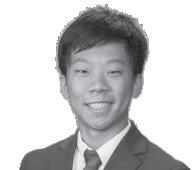
CONTINUED FROM PAGE 2
As the end of the school year approaches, many seniors begin to focus their attention on the future and lose sight of the importance of their last several weeks here.
effects on students in the long run.
CHAINED DOWN
A student fails to realize his potential during his final days in high school as senioritis weighs him down, preventing him from thriving.
After an exhausting week of school work, senior Stice Neuhoff sat down at his desk to prepare for yet another grueling week of long nights spent studying for exams and writing essays.
In contention for Cum Laude recognition, Neuhoff knew that this next week was just as important as any he had experienced throughout his time at St. Mark’s, with one poor performance or grade potentially costing him one of the 20 Cum Laude spots.
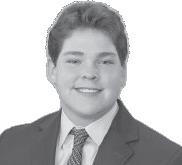
But looking at his classmates, many of whom had already set their sights on college, it was hard to stay focused on finishing out the school year strong.
In years past, the final deadline for grades of Cum Laude contenders to be submitted would have passed over a month ago.
But not this year.
Due to a policy change, students now have to fight through the tail end of their final year as Marksmen to earn the prestigious academic recognition.
As many grapple with the effects of “senioritis,” it can be all the more difficult to stay engaged in the classroom through the final weeks of the school year–even with Cum Laude on the line.

Moving the Cum Laude deadline is something Neuhoff believes will have both positive and negative
“I definitely think Cum Laude will keep students engaged throughout the rest of the year, as much as it's not fun,” Neuhoff. “The people who have gotten good grades all of high school are in the running, and they’re going to have to stay [engaged]. I think some people are not going to care and senioritis is going to take over like it does every year, but it will [help] some people.”
Knowing second semester grades count towards the decision process, Neuhoff knows some students will have additional anxiety until school ends.
“It also adds a little bit more pressure for those people who are in the running,” Neuhoff said. “But for those who don't really care about [Cum Laude], which is a really large portion of the Upper School, it's not really going to have an effect.”
English teacher GayMarie Vaughan knows that senioritis is something that affects students nationwide, but is sure that the decision to move the Cum Laude decision date was not solely based on mitigating senioritis.

“Cum Laude did not have anything to do with senioritis,” Vaughan said, “but it does have a nice collateral benefit. The main reason was that we would have a full picture. If we are selecting the top 20 percent of the senior class, we need to do it based on all of their grades.
Though senioritis had little effect on the administration’s decision, Vaughan still understands it is an issue many seniors are faced with.
“Once students have an idea where they will be going for college, their eyes start looking forward instead of staying in the present,” Vaughan said. “As an AP teacher, the trick was to keep them thinking about
the AP exam. Now that I am not teaching an AP class but doing some elective courses, the trick is to choose books seniors want to read and that will keep them engaged.”
Having already decided to attend the University of Notre Dame, Neuhoff can attest to the relief that finishing the college application process has on students.
“I think college decisions will definitely have an effect on people who get in,” Neuhoff said. “But I think most people, if they’re going to check out, they have already done it. Since they've got all their applications in, some people let their grades drop a little bit, and other people just don’t care.”
Most importantly, Vaughan hopes that students understand how precious each and every day is here at 10600 Preston Road, and that once the senior class graduates, all those memories they have spent years making will be just that: memories.
“Don’t forget that you love this place,” Vaughan said. “This place has been important to you for your entire Upper School experience, some of you for much longer than that. Don’t be in such a hurry to go, because the minute you do, your eyes look back with a sense of nostalgia. Take advantage of classes that you like and subjects that you’re interested in and continue to learn, bcause you don’t peak in high school.”
Ali Rowghani ‘91 will be this year’s Commencement speaker, the school recently announced after a long decision process.
Rowghani will join an elite company of past speakers, which includes school legends such as Victor Vescovo ‘84, who delivered the address in 2019, and Samuel Acho ‘07, who spoke in 2015, and St. Mark’s parent and billionaire H. Ross Perot, who spoke in 2011, a list Rowghani is very proud to become a member of.
“It was both a surprise and a tremendous honor to be asked by Headmaster Dini to serve as the 2023 Commencement speaker,” Rowghani said. “I love coming back to the St. Mark's campus, and to do so as the Commencement speaker is something I never imagined. I look forward to taking part in the Commencement activities and meeting as many Marksmen as I can."
Headmaster David Dini is similarly excited about Rowghani’s return to campus.
“He speaks with real passion and conviction about what the school means to him and how the education he received here and the sacrifices his parents made for him to be here have influenced his life,” Dini said.
“I was certainly moved by his remarks when he was here before to speak during Alumni Weekend. I also spent time talking to him privately on a one-on-one basis too, and I know how important his relationship is with the school.”
Following his education at St. Mark’s and Stanford University, Rowghani has served in many important roles at large companies, including the CFO position at Pixar and the CFO and COO at Twitter. He now works as a managing partner at the startup accelerator Y Combinator based near San Francisco, California.
“He's obviously had a really robust and expansive professional career, which has influenced his life as
well,” Dini said. “He has a lot of diverse experiences to bring to the table, but, again, he also has that deep personal connection with what it means to be a Marksman.”
While advancing his impressive professional career, though, Rowghani has never forgotten his alma mater and continues to be involved in campus affairs.
“He's somebody that cares deeply about access and affordability for the school and making sure that financial barriers to attendance at St. Mark's are removed to the greatest extent possible,” Dini said. “He’s certainly one of our alumni that make it a priority to remain closely connected to their alma mater in a lot of different ways.”
This year, Commencement ceremony will take place on May 25 at 8 p.m. at the Green Commencement Theater. However, the festivities will begin with Baccalaureate, an intimate chapel service with faculty members, seniors and their parents at 7:30 p.m. on May 23.
STORY Dillon Wyatt, Hilton Sampson STICE NEUHOFF SeniorACCESS AND AVAILABILITY
With an increasing number of deaths caused by fentanyl, Narcan’ s increased availability signals a shift in the fight against overdoses.
After long deliberation, the school has made the decision to introduce Narcan, or in its common form, naloxone, on campus. With staff training beginning this summer, the school promises to be equipped with a potentially life-saving resource for community members and visitors.

Band-Aids. Tylenol. Scissors. Gauze. Tweezers. All of the above are everyday items found in the average first-aid kit. While they are helpful enough in the case of minor scrapes or aches, they are certainly not adequate to care for someone on the brink of death. No item in such a kit is.
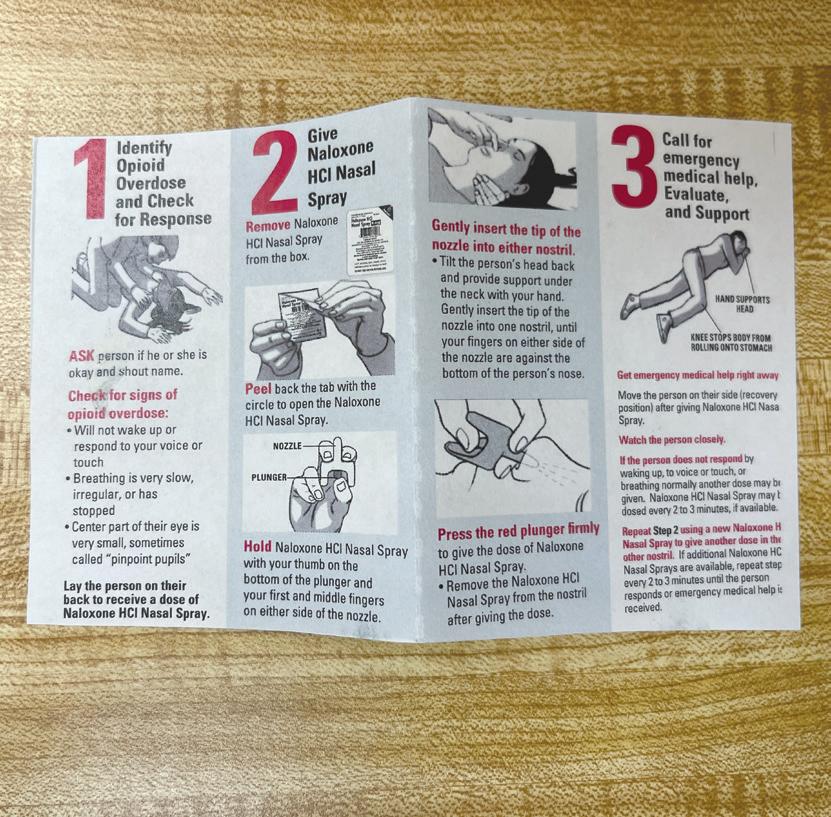
At least, until now.
The Food and Drug Administration (FDA) approved the medication naloxone, commonly known by its brand name Narcan, for over-the-counter sale on March 29, a move which will get this life-saving remedy in the hands of many more people across the nation and which could mean the difference between life or death for millions of overdose victims.
Now, a life-saving remedy can be a staple.
While health officials seek to invent new ways to make medications like Narcan more available to the public, law enforcement continues to pursue the source of the opioid crisis: drug dealers.
However, a student who chose to remain anonymous posits that drug dealers aren’t actually out to harm their customers for a very practical reason: they want them to keep coming back to purchase more.
“At the end of the day, it’s a job for them, and they need repeat business to stay afloat,” the student said. “And if their customers are dying, then they’re not making it. The problem begins when the supply chain gets too long. Your average dealer is not going to buy a pound of cocaine or a crate of opiates. He doesn’t need it. But, it’s easy for a big-time dealer to get a lot of something, and they think they can make their product into a lot more of it by cutting it with cheap stuff like fentanyl. That makes the profit margins just increase and increase as they go down the chain, but it also makes the casualties and the people affected increase as well.”
These customers would likely not think about coming back to purchase more of these products if they were not so addictive. According to Upper School Counselor Dr. Mary Bonsu, most drugs on the street target specific areas of the brain to hook their user.
“Fentanyl and these other pills we’re seeing are opioids, which means they operate on opioid receptors, which are responsible for pleasure, happiness, and pain relief, and are used to treat pain after surgery or
trauma,” Bonsu said. “They’re to be used strictly under the guidance of a physician because they are easily addictive. They get into dangerous territory when one recognizes feeling pain-free or numb and thinks that they should be feeling like that all the time. Tolerance to opioids, when the brain gets used to a certain amount of them causing the person to need more to get the same effect, is also a serious issue.”
Moreover, the student recognizes that there are misconceptions surrounding the demographics of addiction, beliefs that particularly apply to the St. Mark’s community.
“The stereotype is that inner city schools and lower-income neighborhoods are more intertwined with drugs, but private schools are just the same,” the student said. “If you look at a public school where students are living in apartments and their parents are working two jobs, it’s easy to say ‘Oh, it’s because they didn’t have the resources in place to keep them off of drugs.’ But if a private-school kid wants to find a way, it’s not hard. There are so many stores that sell nicotine, tobacco products, and alcohol to kids; they don’t even think twice. It’s just availability: the fact that it’s out there means somebody can get it, which means that somebody else is going to want it.”
This echoes a statement put out by the DEA Dallas Special Agent in charge, Eduardo Chávez, following the fentanyl overdoses at R.L. Turner High School in Carrollton.
“Fentanyl does not discriminate by age, race, gender, or socio-economic status,” Chávez said. “Its addictive properties cannot be compared to anything else on the streets today. The overdose and poisoning margin of error between life or death is microscopic. We all have a role in this fight, because it is a fight. It is a fight for our families, it is a fight to curb substance abuse, and it is a fight to hold criminal drug networks accountable for their actions.”
But what if you can’t stop the drug until it’s already been taken? Until your friend or family member is already on the ground unresponsive?
Well, with the right preparation and materials, even that moment isn’t too late.
Narcan, although not perfect, is an incredibly effective tool in combating opioid overdoses, and it will be available not only in many pharmacies and grocery stores across the nation by this summer, but also in many locations around campus next school year.
While the decision to install naloxone has occurred in light of recent fentanyl incidents at local high schools, the school’s discussions on overdose prevention have stretched back for years.
“At St. Mark’s, we don’t do anything in a knee-jerk fashion,” school nurse Julie Doerge said. “We study, figure out what’s going to be best for the school and make sure we have all our ducks in a row before we do something. We began the discussion to introduce
naloxone five years ago. So, it is not just because of the incident that happened in Carrollton. It’s been within our medical committee as a conversation for a while.”
The medical committee is an advisory body, giving the administration guidance on a wide variety of issues, but they don’t set policy. The ultimate decision to install naloxone on campus was determined by Doerge and Headmaster David Dini.
“The conclusion that we came to was that, while fentanyl and opioids are not present in our community right now, we’re foolish to think they will never be,” Doerge said. “We know an incident can happen here and, just like having EpiPens, why would we not be prepared? We have large gatherings here on campus, like athletic events, where we bring in tens of schools to campus, and I think it’s foolish of us if we really weren’t prepared for an emergency.”
Then, the administration went into action, selecting locations for installation and developing a plan to train staff.
“Narcan will be housed next year in the clinic, counseling office, athletic training office and on the security carts,” Doerge said. “The faculty will be trained on it in the fall, and it can be used by any person. So, the training is to know when somebody’s down and out, just like we do for CPR.”
While the administration hopes that the medication will never have to be used, it pays to be prepared. The addition of Narcan will serve as one more protective measure on campus so that nobody will ever be truly down and out at St. Mark’s.
Editor’s note: This is the second of a two-part series on substance use and overdose prevention. Part one appeared in the March issue of The ReMarker.
NARCAN ON CAMPUS STORY Keshav Krishna, Grayson RedmondThe overdose and poisoning margin of error between life and death is microscopic. We all have a role in this fight, because it is a fight.
EDUARDO CHAVEZ
DEA Dallas Special AgentONE, TWO, THREE As displayed in the nurse’s office, the process to administer Narcan includes three steps: identifying an overdose, responding my giving the spray and finally calling emergency services for help. PHOTO / GRAYSON REDMOND
PHYSICS OLYMPIAD
Seniors Alex Wang, Henry Baxter and sophomore Surya Dinesh took the United States Physics Olympiad on April 4. To qualify for this test, students have to score in the top 400 nationwide on the previous F=MA examination. This calculus-based test was taken in two 90 minute sections. The top 20 scores in the USAPhO qualify students for the national physics team, where they recieve intensive training and prepare to compete internationally.
FISH TANKS
The fish in the science building fish tanks are winding down on yet another successful school year, largely driven by their careful monitoring courtesy of science instructor Dan Northcut. The three tanks, containing freshwater, chyclids and saltwater fish, are checked on multiple times a day by Northcut and maintained by an off campus organization.
CRYPTOCURRENCY SCAMS
Cryptocurrency scammers have gained a new trick to steal money with. Aided by the popularity of AI chatbots, these scammers are able to automate the generation and running of fake cryptocurrencies. By creating a cryptocurrency with a name mirroring the popular chatbots, the scammers are able to create a pump-and-dump scheme. By quickly inflating the price of a cryptocurrency, other people buy in expecting profit. At this point, the scammers sell off all their shares, and they crash the value of the currency.
TORNADO TROUBLE
Over the course of the last two months, several tornado warnings have led to the cancellation of various athletic events. This tornado season has been one of the worst in recent history, with alarms around campus sounding off nearly once every week. Due to factors such as
The ReMarker metereologist Akash Munshi breaks down the upcoming forecasts in Dallas.
Tomorrow There will be a high of 92 degrees, low of 63 degrees, anticipate clear skies and medium pollen for most of the day.
Sunday The high will 93, and it will have a low of 67. The weather will be sunny, with some scattered clouds in the morning.
Monday Monday will be cooler, with a high of 84 degrees and a low of 58. It will be mostly cloudy, with low chance of rain.
Starting April 16, expect to see some wacky weather patterns that will have you scratching your head. You might wake up to sunny skies in the morning, only to be greeted by a thunderstorm in the afternoon. Or maybe you’ll experience a sudden cold snap, followed by a heatwave that’ll have you shedding your layers faster than a snake sheds its skin. At least there will not be any snow or tornados this month.
global warming, the frequency of natural disasters such as tornados, can be expected to increase.
SEASONAL ALLERGIES
Seasonal allergies in Texas are among the worst the in the nation. "Cedar fever," caused by the Ashe juniper trees found in Central Texas is a large part of this problem. Annually, the tree releases its pollen into the air, causing allergic reactions such as sneezing, coughing and itchy eyes. To manage seasonal allergies, steps can be taken to reduce exposure to pollen, such as staying indoors during peak pollen times, using air filters in their homes and wearing masks while outside.
Over-the-counter antihistamines and nasal sprays can also provide relief for mild to moderate allergy symptoms. Allergies can be expected to continue well throughout the rest of spring and into summer.
Length of drought
Intensity of drought

Amount of rain
Hazard level

People affected
Casualties
Three years
90 percent of California
Two to three inches
Level four flashflood
At least 7 million
At least 12 people

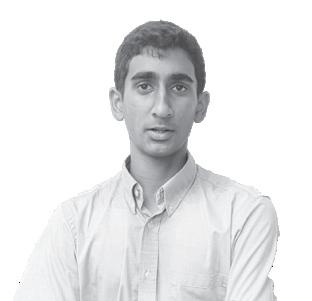
Continue. Play Again. Find Match. I can’t end on a loss, I think to myself, justifying the wasted time spent in queues for matches I was never invested in to begin with. Everything I’m feeling at the moment — frustration, anger, excitement, resentment — is part of a behavior pattern video game companies strive to instill among their player bases. In a market inundated with high quality games, developers need to find ways to keep users engaged through gameplay and community. Though fullscale video game addiction is rare, an MPower Wellness article warns that the demographic most at risk — men between the ages of 18 and 24 — can see video game addiction rates as high as 4%. That’s one in 25. Though I can’t speak for the general public, I know dozens of people who play video games often, and in that group are plenty of people who I think of whenever I hear of the warning signs: skipping meals, work or other responsibilities to play matches they likely won’t remember in a few days’ time.
But why should we care?
Should it really matter how people choose to have fun? Well, to some extent, yes. Let’s get back to that League of Legends postgame lobby, complete with a ranked rewards page, a leaderboard to compare my rank with friends, and that fateful “Find Match” button. Three years ago, I would be pressing that button over a dozen times a day, constantly trapped in a loop of game after meaningless game. The summers were especially bad: 14 hour sprees of ranked games without a meal, rarely leaving my room for meals or to, you know, go outside. Though I still queue up for the occasional game, I’m more aware of the negative cycles it can bring me into.
I’m not here to convince you that video game addiction is some dangerous epidemic that threatens to ruin your life — consult the statistics if you wish. What I would like to encourage, however, is an increased awareness of the ways we like to spend our time. Take a few seconds to think about if what you’re doing is worthwhile. If after actually thinking about what you are getting yourself into, you won’t find yourself like I did, wasting weeks at a time “enjoying” myself. At the end of the day I’ll still queue up for that ranked game, and you should too (if you really want to); just make it count.
science instructor Zach Smith sits down with The ReMarker to share his experiences with conducting glacier geology research in the Arctic and Antarctic and what he has learned from it.
Nikhil Dattatreya: What got you interested in glacier geology?

Zach Smith: I grew up in the Appalachian mountains in Pennsylvania, and back then, there was snow all the time. We had cross-country skiers that we don’t have anymore nowadays because of climate change. I was a big National Geographics fan when I was a kid, and there are lots of spectacular places to go. I thought it would be pretty cool to go to places like the Arctic or the Antarctic.
ND: What was the process of finding research opportunities like?
ZS: I was lucky enough to ski across the Juneau icefield in Alaska for two months. I've been to Antarctica twice, and to lots of other glaciated, big mountain places. So I ended up doing that as a portion of my undergraduate, and a big portion of my graduate work was on glaciers. Then I got involved with a lot of research programs that did that.
ND: Had you ever been to Arctic-like environments before conducting research there?
ZS: This was a long time ago, and we didn't have money to travel, so we never went on vacation if you couldn't put six kids in a car and drive somewhere. When I was in high school, I went to Vermont to ski, and that was a huge deal at the time living in Pennsylvania. We had never gone to any spectacular, cool places — Alaska, the Arctic, the Antarctic — nothing like that. Nobody ever went abroad
back where I grew up.
ND: Were the people you met to conduct research also traveling long-distance for the first time?
ZS: After I was out of undergraduate and in graduate school, someone proposed the theory of the Himalayas as a giant block to climate change and [how] the monsoon season in Asia affected climate around the world. A lot of that stuff is really new information. A lot of research about Antarctic circulations or El Niño oscillation in the South Pacific is relatively new stuff. At the time I was doing research, a lot of those things were being proposed, you couldn’t use the level of instrumentation or do the type of work necessary for that research. We did work on stratigraphy, geology, stuff like that. We did the stuff that was close to home that was still really important, but easy access. That was the extent of most people I knew at the time.
ND: What did research in Alaska and Antarctica look like?
ZS: When I went to the near Arctic in Alaska to work on the Juneau icefield, I had just started teaching. I read an article about this research program. As far as I know, it’s still the longest running research field research program in the United States. And these guys were researching the
Computer Science Instructor Kurt Tholking has been named the new department chair of the Computer Science Department, the school recently announced.
After a long hiatus of an official department chair, Tholking accepted the job with hopes of changing and solidifying the Computer Science Department as its own, self-standing group.

“I'll be the department chair going forward,” Tholking said. “It has been an informal department, but we will make the department more formalized. We just haven't had a formal department chair since Mr. Barrett retired nine years ago.”
Having long served on the faculty as a computer science instructor, the choice was logical for administrators to promote him.
“I have been a computer science teacher for a long time teaching seventh through 12th grade,” Tholking said. “But when the schedule changed, I couldn't teach seven through 12 and so I now just teach eighth through 12.”
To help manage the Lower and Middle school programs, computer science instructors Kendall
Murphy, Aimee Whitaker and Stewart Mayer all teach classes.
“Mr. Mayer teaches seventh grade computer, and while he is in the science department, his work in the Makerspace also falls under the computer science domain,” Tholking said. “If you look in the directory, Mrs. Murphy and I are listed as computer science teachers, and then Mrs. Whitaker is for Lower School.”
However, for such an important topic in the modern world, these four teachers serve as the core members of the computer science department. But Tholking has plans to change this as department chair, bringing a plethora of new ideas to expand the program.
“I already added an Intro to AI course for next year in the catalog,” Tholking said. “The addition of more faculty could also bring more engagement in courses like the info engineering course that is taught by Mr. Rummel and Mr. Mayer over two semesters.”
The benefit of the expansion of the program would be enormous as students graduate and join an
recession of the Juneau icefield. I had luckily been to Alaska once, and I gave him a call and just said, “If you're looking for a research assistant, I'm the guy you're looking for.” I went up there for two summers and skied across that glacier and did work up there on the melting of the glacier.
ND: What would you say you have learned from traveling aside from research-related discoveries?
ZS: Traveling is really good for everybody. There's different kinds of travel but if you travel, get connected with the people. It's cool to see the Sistine Chapel; it's exciting, but if you're not talking to Italians and learning a bit from them when you're there, you miss out. When I travel, I like to make sure I've got a lot of friends, people I can just call and say, “Hey, I'm coming down to Nepal” or “I’m going to Ghana. Let's get together.” Thanks to [St. Mark’s], I’ll be going to New Zealand and Australia, and I have a friend who is going to dive in the Barrier Reef.
When we travel, we want to see the food, we want to taste the food, we want to see the way people dress but that's not really culture. Culture really is: How do you work as a family? How do you work with your neighbors? How do you vote? How do you boycott your democracy or your government? How do you rely on other people? For me, these are the aspects of culture that I learned from other people. Now I understand why people do this or do that because of their connections. It has nothing to do with food and dress and that kind of touristy culture.
increasingly tech reliant work.
“It doesn't matter what your major is but people are starting to see that you need to have computer science background,” Tholking said. Whether you are either in in medical science, biotechnology, finance or data science, it all takes computer science.”
In order to have students develop a base knowledge of computer science, Tholking also wants to have more Upper School engagement by having a type of computer science requirement to graduate.
“Possibly down the road we have looked at graduation requirements,” Tholking said. “This would require adding more classes in the Upper School, because if every student needs to have a semester of computer science, the school need to have more offerings.”
Ultimately, Tholking hopes his appointment brings a formality that allows the department to continue to grow.
“We're always expanding and adapting,” Tholking said, “and hopefully we'll get to the point where we have more offerings as a department and more versatility in what we do. We are well on our way.”
Seventh grade“
I gave him a call and just said, “If you’re looking for a research assistant, I'm the guy you’re looking for.”
ZACH SMITH Sixth grade science instructorKURT THOLKING Newly named Computer Science Department Chair PHOTO / COURTESY ZACH SMITH NEW HEIGHTS Smith conquers Kilimanjaro, showcasing a St. Mark’s pennant.
Chris Lee ‘96 has been connected to the school from the time he was a first grader, learning how to read, to the time he spends organizing alumni events in New York. He also has served on the Board of Trustees and seeks to promote economic diversity within the school.
real estate. We’ve been doing that at KKR real estate today for the last 11 years.”
“You want to be able to also attract people who can’t pay tuition,” Lee said. “So that was an area that I spent a lot of time on.”
Chris Lee ‘96 stepped onto Wall Street with a sense of purpose. He is well-equipped, with nearly two decades of schooling preparing him for this moment.
He thinks of his friends, some of whom he’s known his entire life. He thinks of his family, of his younger brother Julian Lee ‘98.
He was ready for this moment, but being one of the first Black men on Wall Street was never going to be easy.
A few years before, he would never have considered even applying for the role he found himself in, but with the help of an organization aimed at promoting diversity on Wall Street, he found his passion.
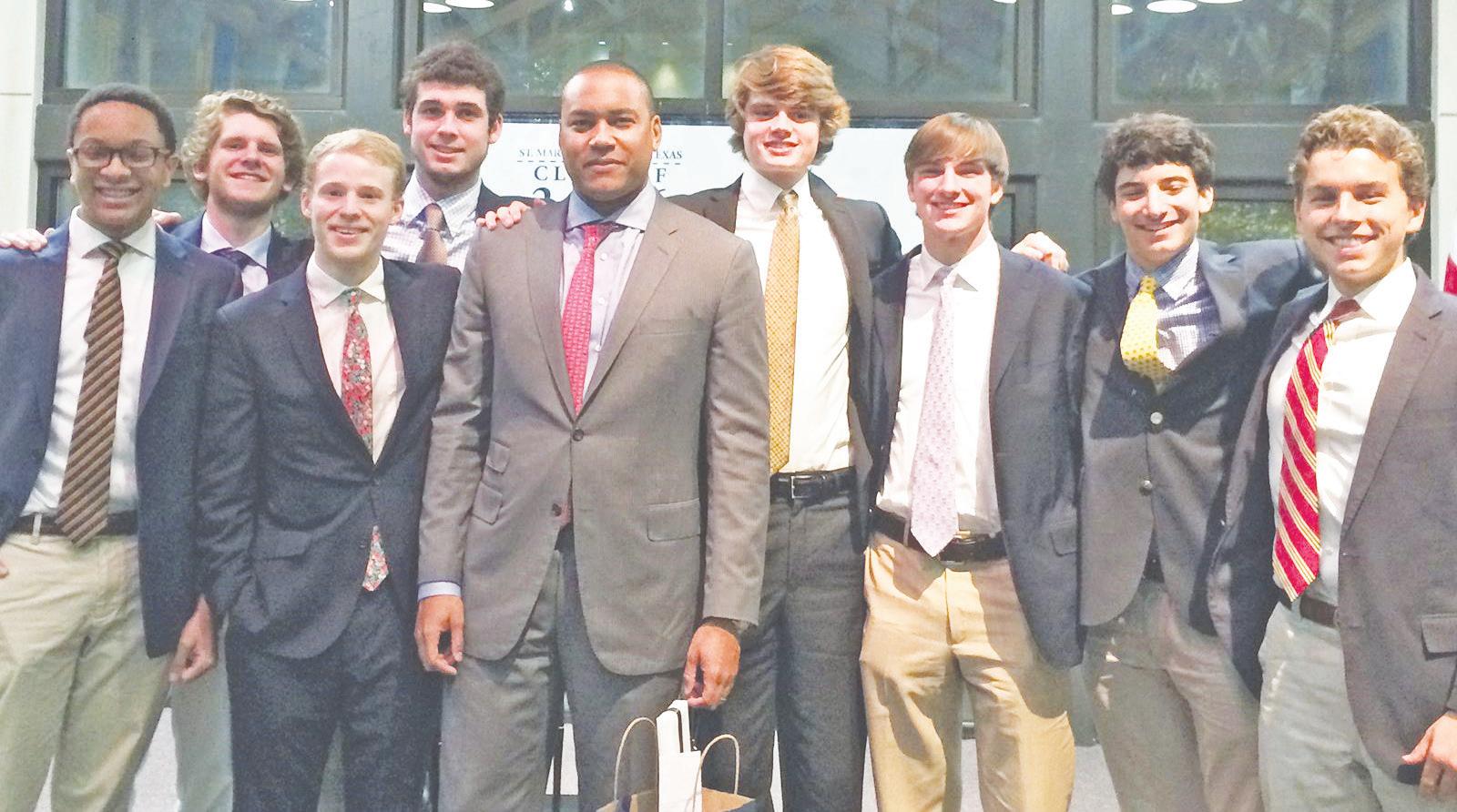
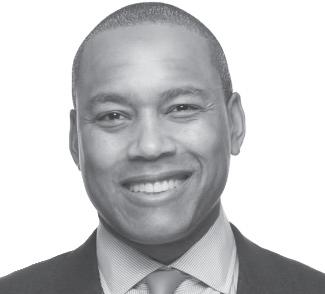
“I ended up applying for this internship through this organization called, ‘Sponsors for Educational Opportunity,’” Lee said. “So I actually joined Chase Securities in the summer of ‘98, and I had no idea what Wall Street really did.”
After joining the industry, Lee quickly fell in love.
“I went back to Chase summer of ’99 and then ended up turning that into an opportunity to work at Goldman Sachs and a real estate banking group coming out of college in 2000,” Lee said.
Upon joining Wall Street, Lee quickly found his niche.
“I started out in banking,” he said. “I realized I wanted to be on the investing side of business and also
Lee’s love for math, and by extension his most important tool, began at the school.
“[Former master teaching chair J.T.] Sutcliffe taught me math in Middle School,” Lee said. “But in Middle School, I competed on the math team. It was always a big deal in my house to be strong in math outside of regular schoolwork and sports. We did a lot of extra math and Ms. Sutcliffe was always one of those people that really encouraged me. She believed in me and it really encouraged me to take math competitively.”
The Sponsors for Educational Opportunity inspired Lee to help promote diversity on campus.
“One of the main things that I focused on [on the Board of Trustees] was affordability and accessibility,” Lee said. “Several committees were very focused on how we can make the school accessible to a wide range of people as the tuition has continued to rise.”
With rising costs and inflation, tuition has steadily gone up nearly every year. These increases have made it harder and harder for students to attend.
“25 years ago, you could be in many different professions and pay for a St. Mark’s education,” Lee said. “The school has gotten to a point where it is quite expensive, and it really became pretty narrow in terms of who could afford to be a full payer.”
The expense has particularly made it harder for students from diverse backgrounds to apply to the school.
In addition to working to make the school more accessible, Lee also started a scholarship in the name of his parent.
Lee credits the school for providing him with a group of lifelong friends, an excellent education and teaching him the value of work.
“I think St. Mark’s is a special place,” Lee said. “I started there in 1984, and I really liked many things. I was there for 12 years, but I’d say number one, I got a fantastic education that just made things a lot easier going to go into college.”
Lee stays involved with his friends, some of which he’s known since first grade, by helping lead alumni events in New York.
“I started getting more involved after I moved to New York in 2000,” Lee said, “and got involved with the New York Alumni Board. I then stayed involved through some of the activities we’re doing up in New York, but then after I came back from business school in 2006, I got even more involved.”
Aside from helping make the school more affordable, Lee also worked with the SEARCH committee to find now current headmaster David Dini.
“There’s no more important decision than who leads an organization,” Lee said. “So I think after two decades under [former Headmaster Arnie Holtberg’s] leadership it was a great full committee decision.”
While students were outside enjoying a snow day, junior Alex Pan sat at his computer, taking the National Biology Olympiad Exam. Although only AP Biology students are required to participate in the competition, Pan also participated in the preliminary round of the competition Feb. 2.

He was one of nine students who advanced to the semifinal round that was held March 2.
“Biology Olympiad is a national competition for high schoolers where they take a series of tests relating to biology,” Pan said. “There’s an open exam that is available to anyone. If you score inside the top 10 percent of participants, you go on to the semifinal round. Then the top 20 scores go to the national finals. In the final round, students are asked not only to take a test, but also to participate in labs and other examinations to
determine placement.”
This is his third year participating in the competition and his first year reaching the semifinals.
“It felt very rewarding after missing the cut my freshmen and sophomore years,” Pan said. “When I found out I got a top 15 score on the opening exam, my hard work felt like it had paid off.”
Hours of studying helped Pan achieve high marks on the first exam.
“Last summer, I spent two hours every weekday studying,” Pan said. “Around the start of the school year, my study time became less consistent. However, when the test date got closer and closer, I began to study very frequently again.”
Although he is uncertain about his future in the competition, he continues to study due to his passion for Biology.
“I originally learned about the national competition because a friend who knew I was interested in biology told me about it. I love learning about biology because so much is happening in your body and the world,” Pan said. It’s really interesting to learn about everything going on inside. It helps you get a deeper understanding of how living things function.”
Additionally, he has used the Biology Club to share his passion for the subject.
“Even though the club works as a group to study for the National Biology Olympiad Exam, we also want to inspire younger students who don’t like biology to take a chance on it,” Pan said. “At first, it may seem like you’re just memorizing stuff, but at the end of the day, it’s about learning about the world around you.”
MARKSMAN IN FINANCE“ You want to be able to also attract people who can’t pay tuition.CHRIS LEE Former Board of Trustees member
Entire
created that generate money by taking user data, and using it to manipulate users into generating online interactions.

As our world becomes more and more digital, our sources of information become more targeted. These algorthims lead to the creation of online echo-chambers, online communities that unite around a shared belief and validate each other.
STORYMindlessly scrolling through the short, 30-second videos, many get lost in the trance created by TikTok. We’ve all been there: what started as a tenminute break dragged into an hour-long venture, down the winding road of seemingly endless videos.
TikTok is an addictive app, designed to promote ads and profit of revenue, and also hides the malicious side which inadvertently promotes misinformation. With billions of people on social media and streaming platforms, private companies have gained the ability to manipulate what information goes out.
Social media websites such as TikTok have long been adapting their algorithms to entice their audience to gain more screen time.
or push more products, and they’ve gotten very good at tuning things too.”
However, TikTok isn’t the only social media platform that has utilized malicious algorithms to hook in newer audiences.
“Facebook, Twitter, any of those have divisions dedicated to how can to design the most addictive app. They focus on, you know, eliciting your emotional responses to post,” Eckel said. “Whether that’s angry, happy, or sad, it keeps that desire to come back and to continue to scroll, read, and consume that content.”
With all the addiction and new users on social media platforms, it has allowed people with various intents to post and spread misinformation.
KEVIN BOONE Senior Technology Specialist“A single TikTok video is only around 30 seconds, trying to give you as much information as possible,” Boone said. “There is very little elaboration on certain topics because these videos are trying to pack as much information as possible. Some people aren’t going to go look beyond the video, but rather they take it at face value, as opposed to really researching to verify what has been presented.”
was a code of honor, with investigative reporters that made sure they reported facts. But now there is a lot of political influence on media, whether it’s social media or mainstream outlets, and people only get a sliver of the truth.”
Along with malicious users on social media, some proprietors of these huge social media platforms have also been known for pushing their own viewpoints. “We’ve given these companies a lot of power in terms of their control over the flow of information,” Boone said. “It comes down to who’s running the company. These people set the policy of what information can make it out and spread and what information is not. That includes cutting people off from those platforms which causes a lot of controversies and a lot of conflict in our society.”
Despite all the controversy, false information, and even propaganda projected onto social media, it could easily be combated with a simple solution.
THOMAS ECKEL Chief Technology Officer

“TikTok has been the interest of late. Their algorithms depend on what the user clicks on. something, it starts taking you down that particular trail. It keeps taking down that trail over and over and over,” said Chief Technology Officer Thomas Eckel. “Say, if you looked at something on dogs, it would keep refreshing in taking you to displays that are only associated with that topic.”
These algorithms have been specially designed to not only get users to watch specific and addictive videos but also to push the user to buy products.
“When the user keeps watching and consuming content, you keep seeing the ads they want you to see, and it, therefore, makes them more money,” Senior Technology Specialist Kevin Boone said. “These platforms always look to tailor the content to the user so they can show more ads
W
While it does create an environment where users with similar interests can interact with each other, it can also create division between two opposing communities.
“Misinformation can spread quickly to other people who believe the same thing and it just grows exponentially,” Boone said. “It’s easier now in this day of age, to feed false information, because there are fewer and fewer people trying to verify it with multiple sources. People are also not going to get a lot of opposing views or content the algorithm deems as noninteractive.”

Anyone, including people with the specific malicious intent of feeding misinformation, can join and post on the website.
“There’s no barrier to entry: as long as someone has a phone or computer can have a TikTok account and upload whatever they want to it,” Eckel said. “ A hundred years ago, the newspapers controlled how things spread, but there
AARON AUGUSTINE Environment & STEM Editor
Today’s teens are reportedly more isolated and friendless than any time in the past. Instead of encouraging human interaction, we are bombarded with an endless scroll of content. Infinite sounds and colors flashing across screens to numb our minds against the ever-growing lonliness.
We lose hours upon hours in mindless consumerism of non-stimulating content. Not only does social media
directly cause this lack of social interaction, it attempts to mirror healthy human interaction with an imperfect imitation. The image of Ryan Gosling reaching out to his digital companion in the desperate search for connection becomes less and less of a fantasy.
hile social media has revolutionized the way we can communicate and socialize, it has also led to an ever increasing problem of social alientaion.Social media algorithms aim for one thing: interactions. Every click, view or scroll gives the company a means to make more money. When you combine algorthims that are programmed to maximize these interactions with an increasingly alienated population, you give rise to parasocial online communities.
While intially appearing as a fun way to meet people online, these parasocial communites offer themselves as the solution to the friendless, alienated teen. They present themselves as a chance to make friends and connections online, but they are a pale imitation of either.
In fact, some of these communities directly profit
120
KEVIN BOONE Senior Technology Specialist“Even if they tell people what they want them to hear, having the ability to dig deeper and read about opposing views is very healthy,” Boone said. “Ultimately, it comes down to the individual. We individually are responsible for taking that information and making sure it’s valid. Knowing which channels of information you’re drawing from is important to help formulate your own opinion.”
billion dollars are generated by social media companies annually.
of teens use at least one form of social media that utilizes targeted content.
90% 22% THE REMARKER APRIL 14, 2023 12 STEM ENVIRONMENT
from the alientation of their members. For instance, there are online forums where you have to pay a few dollars every month to access the forum. These forums directly benefit from the parasocial relationships formed between members, because once a member becomes invested in the community, suddenly the forum has a steady source of revenue.
I’m not aruguing that all social media is bad; it can be used as a great tool to remain in touch with people who you can no longer see in your everyday life, but so long as the incentives of social media companies drive towards social alienation, social media serves as an acid seeping into the ground of our generation, posioning us from being able to create meaningful connections.
It is grotesque how we can sit for hours on our devices endlessly scrolling through bright sounds and colors and starve ourselves of social interactions.
“
It’s easier now in this day of age, to feed false information, because there are fewer and fewer people trying to verify it with multiple sources.
With military enlistment declining nationwide, have Marksmen also strayed away from serving? The question of why a Marksman would even consider serving in the armed forces is answered through the eyes of both those who have and those who will.
10600 IN BRIEF
ADMISSION WELCOME EVENTS
Admission welcome events have recently kicked off to showcase the St. Mark’s experience. One of these events, the Lower School ice cream social event, occurred April 13 and is an opportunity for newly admitted students and their families to gain insight into life on campus. With ice cream, beverages and other refreshments being offered, participants have the opportunity to talk with school administrators, teachers and current students to gain a better understanding of school life.
FOURTH GRADE FIELD TRIP
On March 23, the fourth grade departed at 7 a.m. for a field trip to Austin, Texas. After touring the State Capitol and enjoying lunch on the lawn near the Bob Bullock Texas State Museum, they explored the museum in small groups and had time to shop for souvenirs.
The
JANETLIN
Chinese Instructor
The highlight of the day was the interactive movie, “The Star of Destiny,” which included a surprise appearance from a toy rattlesnake below each boy’s seat. The trip was wrapped up with Chick-fil-A in Waco before returning to campus.
FINAL COMMUNITY SERVICE DEADLINE The final five of the total 15 community service hours were due Apr. 10. The hours are required to be logged in to MobileServe, the new community service hours tracker. Hours from old accounts from X2VOL have all been transferred to the new MobileServe accounts, and offers students four different ways to verify hours.
NATIONAL LANGUAGE EXAMS
The Upper School and Middle School students began taking the National Spanish Exam and National Latin Exam, a project that the Foreign Language Department
Quotes overheard around campus
DANIEL WEINSTEIN Junior

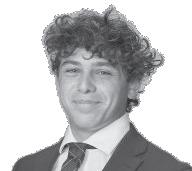
has been working to prepare for all March. The tests entail two sections that students will take across multiple days, beginning on April 3. The results of the tests can qualify students for scholarships and are broken down into three medals: gold, silver and bronze.
COMMUNITY SERVICE BASKET
DRIVE UPDATE
The Community Service Board held their annual Spring Basket drive from Mar. 20 to Mar. 30 or Apr. 3, for Middle and Upper School respectively. Students in Middle and Upper School were asked to bring different items such as candy and toys to form a spring basket with an Easter theme. In total, the school community came up with 168 baskets, 40 of which went to the Genesis Women’s Shelter, 40 to the Jubilee Community Center and 88 to the West Dallas Community Center.
Over three decades ago, he started his career on campus in a position that no longer exists, in a building that doesn’t exist anymore, handling big, clunky machines that are long gone.
Over three decades ago, one of the longest-tenured faculty members on campus first started working as the print shop extraordinaire. And the textbook coordinator. And the Student Store manager. And the mail room coordinator.
At Lessons and Carols, he made sure that everyone got their programs. At the beginning of the school year, he made sure that everyone got their books.
In the print shop, which was in Davis Hall, he watched weary Marksmen of bygone generations wander into destress with chess, backgammon and dominoes. No phones or computers in sight.
Now, he’s mainly responsible for the distribution and inventory of uniforms and equipment for all athletic teams. He’s always trying to maintain some sort of order.

I could really use an Arby's double roast beef sandwich right about now.
CJ NESS Junior
I love praying, man. MATTHEW JORDAN Sophomore
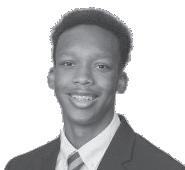
An
look into the job of one of the longest-tenured faculty.
The stories behind many of the buildings on campus.

A look into the reason AP classes are not offered earlier.
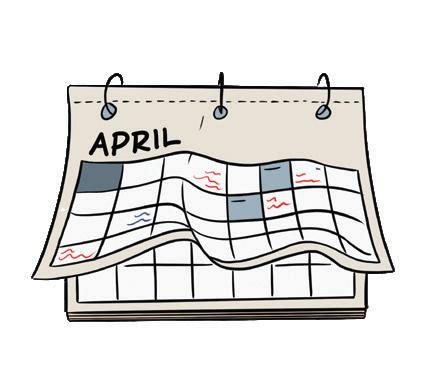
Thursday-Saturday 7 a.m. ISAS Fine Arts Festival in Fort Worth
Lower School Father/Son Breakfast and Chapel
Saturday On-campus
April
April
April
April
But his involvement in the athletic department hasn’t been confined to sorting clothes. He’s coached all levels of football, middle and high school. He’s coached JV and Middle School basketball. And right now, he’s dabbling in tennis.
And as the years went by and kids grew up, he went from coaching one generation to the next, often being able to say, “Say hi to your dad for me! I remember when he was your age.”
From coaching Lions to their cubs.
It’s these long-lasting relationships that make sorting stinking sportswear in a dark tunnel behind the locker room worth it. Relationships spurred by a Saturday detention, having to help him sort out the lost and found. And relationships that make guys come back 15, 20 or even 25 years after walking across the commencement stage to say, “hello.”
And these relationships are why Ron Turner is still around 35 years later.
Jiminy crickets, I'm so silly!
dragon is a made up animal, it never existed. Just like the dinosaur.
Throughout the course of the year, the Upper School quizbowl team has dominated in various competitions, having not lost a single local tournament. However as the team looks abroad, they now face three upcoming national tournaments.
The most important of all the tournaments is SSNCT (Small School National Championship Tournament), which will be in Chicago on the last weekend in April. The quizbowl team looks to secure a three-peat, having won the tournament the past two years.
“It would be a three-peat with all juniors, which means if they win it, they’d be favored to win it again as seniors,” Mlakar said. “But they've got some tough competition to play against in April.”
On Memorial Day weekend, the quizbowl team will travel to Atlanta to compete in the HSNCT (High School National Championship Tournament). The tournament is open to all schools across the country, so there is an abundance of competition.
“It'll be a really hard tournament,” Mlakar said. “I think St. Mark's has never done better than like 13th or 14th. We haven't played in that tournament for a couple of years now, and we're hoping to do the best St. Mark's has ever done.”
From June 9-10, the team will be back in Chicago for the PACE National Championship Tournament. Only the top teams from around the country are invited.
“It’s probably the most challenging tournament – the questions are really hard,” Mlakar said. “And the format’ s slightly different. As a school we ’ve only played PACE one other time, and we took second or third place.”
In order to prepare for these competitions, team members need to practice and study rigorously.
“We practice as often as we can,” Mlakar said. “A lot of the guys will meet during the day if they have concurrent off periods to just read packets and play matches. We do that almost daily, and then on Wednesdays we practice after school.”
After a history of strong quizbowl teams, Mlakar is hopeful for good performances again this year.
“I think it s just as promising as previous year,” Mlakar said.
“Obviously all of these guys are experienced players, but sometimes you just get lucky or you get unlucky. If the packet favors one team, sometimes you just can't overcome that. But these guys are really good – no doubt about it. And they’ re a really well rounded team.”
CAMPUS
With such an expansive and beautiful campus, nearly every building is named in honor of a distinguished alum or donor who has significantly contributed to the school and its campus.
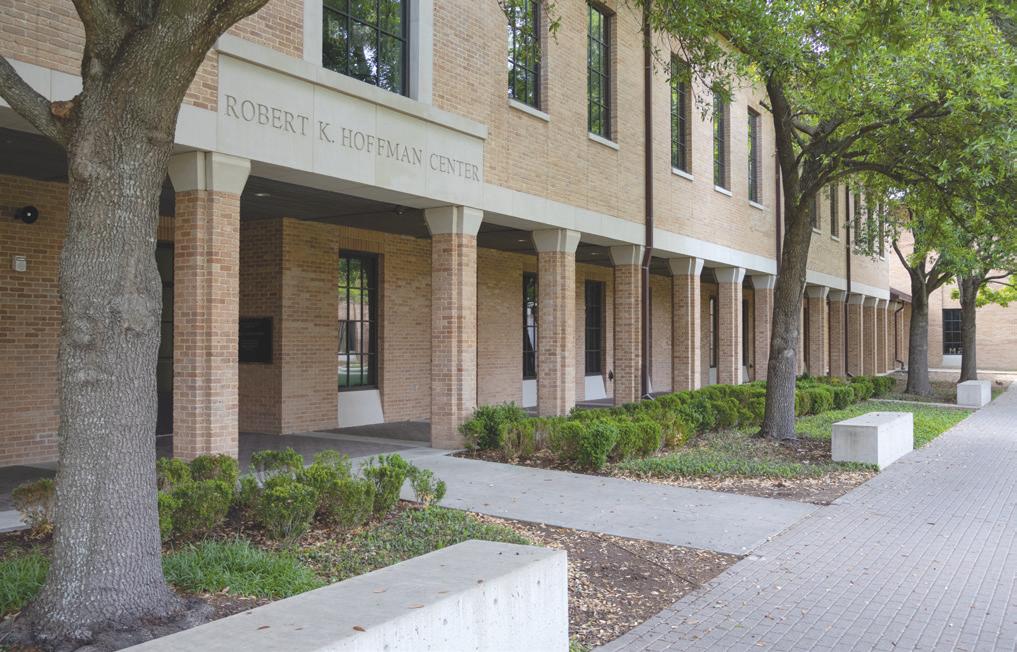
• The building was constructed in order to replace the aging Davis Hall and funded by a donation from the Crow family.
• The Crow family requested it be named after then-Headmaster Arnold Holtberg. Holtberg agreed on the condition that the building would only bear its name after he retired from the school. This agreement was eventually fulfilled in 2017, when the building was rededicated in Holtberg’s name.
• "At the top of the building’s portico, it says ‘Centennial Hall,’” Perryman said, “but if you look up right at the very top, it says ‘Arnold Holtberg Academic Center.”


• Named after Robert K. Hoffman ‘65.
• He was an editor of the Harvard Lampoon when he was a student at the university, and he went on to co-found the National Lampoon in 1970.
• “He was a great alumnus — talented, incredibly bright and incredibly generous,” Perryman said. “He served on the Board [of Trustees] and did a number of wonderful things here, but he passed away tragically young.”
• After dying of leukemia at 59 years of age, a donation was given posthumously in his name to bankroll the construction of Hoffman Hall.
• Named after Cecil and Ida Green and Eugene McDermott. Cecil and McDermott were co-founders of Texas Instruments who made several large donations to the school over the years.
• Cecil and Ida Green are also the namesake of the Green Library. The Green family has made similar contributions to academic institutions across the world, such as Stanford, the University of British Columbia and the University of Oxford.
• “[The donations were made] somewhat as a response to Sputnik,” Perryman said. “which really did inspire several generations of Marksmen to foster future great scientists and engineers.”
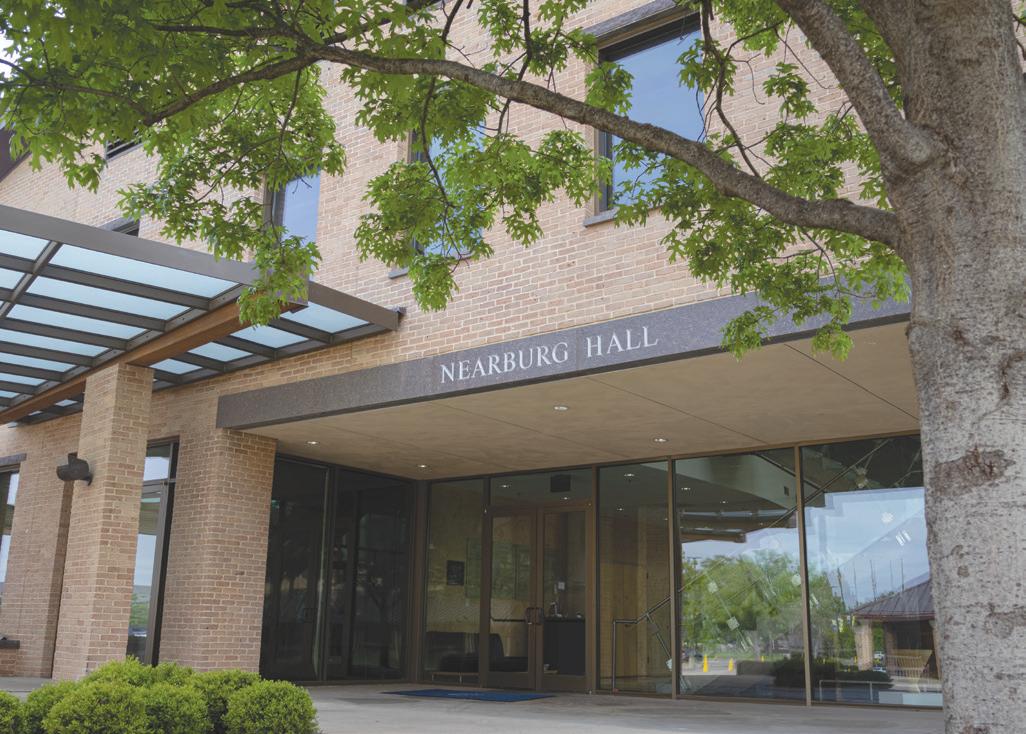
• Named after the Nearburg family and especially Charles Nearburg ‘68, who led the Campaign for St. Mark’s, which eventually ended in 2001 after raising $52 million.
• Nearburg served on the Board of Trustees for 20 years.
• Nearburg parlayed his wealth from his oil and gas exploration company into a career in race car driving, breaking the wheel-driven land speed record in 2010.
• Funding was provided by The Campaign for St. Mark’s
Never forgotten Faithfully serving for 45 years, Steve “Hollywood” Walker was an icon to students on campus, always serving meals with a smile and sharing frequent conversations. Though he retired in Spring 2021, he remained closely connected with the the community and continued to impact and inspire students here. Walker will forever remain as an image of a man who’s consistent passion changed the lives of many.
REMEMBERING STEVE “HOLLYWOOD” WALKER
“Steve Walker was a treasured colleague who devoted almost his entire adult life to the St. Mark’s community, guiding generations of Marksmen on the path to manhood. He loved life and he loved the boys who walked our halls. He leaves a lasting imprint on our community and will be dearly missed.”
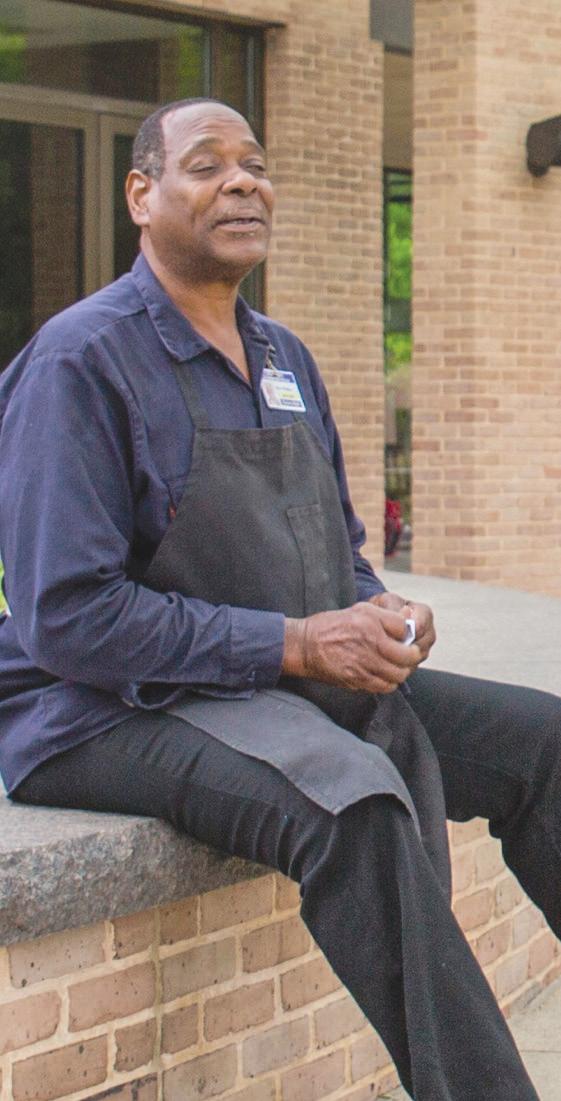
 -David Dini, Headmaster
-David Dini, Headmaster
“Steve was a very important member of our community. He cared deeply for the boys and our school.”
-Howard Stewart, Chef“Almost every day of Middle School, I passed Hollywood on my way home from school. He would smile, make me laugh and usually give me a piece of advice. He was one of the brightest spots of our community.”
-George Genender, SeniorADVANCED PLACEMENT
As underclassmen begin to consider the college application process, many wonder why most AP courses are only offered to juniors and seniors.
BUSY WORK
The average Upper Schooler has many hours of homework every night. In addition to normal schoolwork, some sophomores have an additional task: studying for the AP Modern World test.
Sophomore Ethan Zhang opens Barron’s AP World History, flips to the back of the book, and prepares to take a practice test. He starts a timer on his phone to simulate the conditions of the real AP test, and then he gets to work.
Since the school doesn’t offer an AP World History class, Zhang, along with 25 other sophomores, has been independently studying for the AP World History test. In thousands of high schools around the country, students take several AP classes during their freshman and sophomore years.
Not here.
“We want freshmen to have time to acclimate to our school,” said Paul Mlakar, Director of Academic Information Systems. “Our offered freshman classes aren't easy classes.”
Despite the rigor of the school’s normal classes, AP courses are far more challenging. Mlakar says the school’s current course progression helps freshmen and sophomores adequately prepare for the intense workload of an AP class.
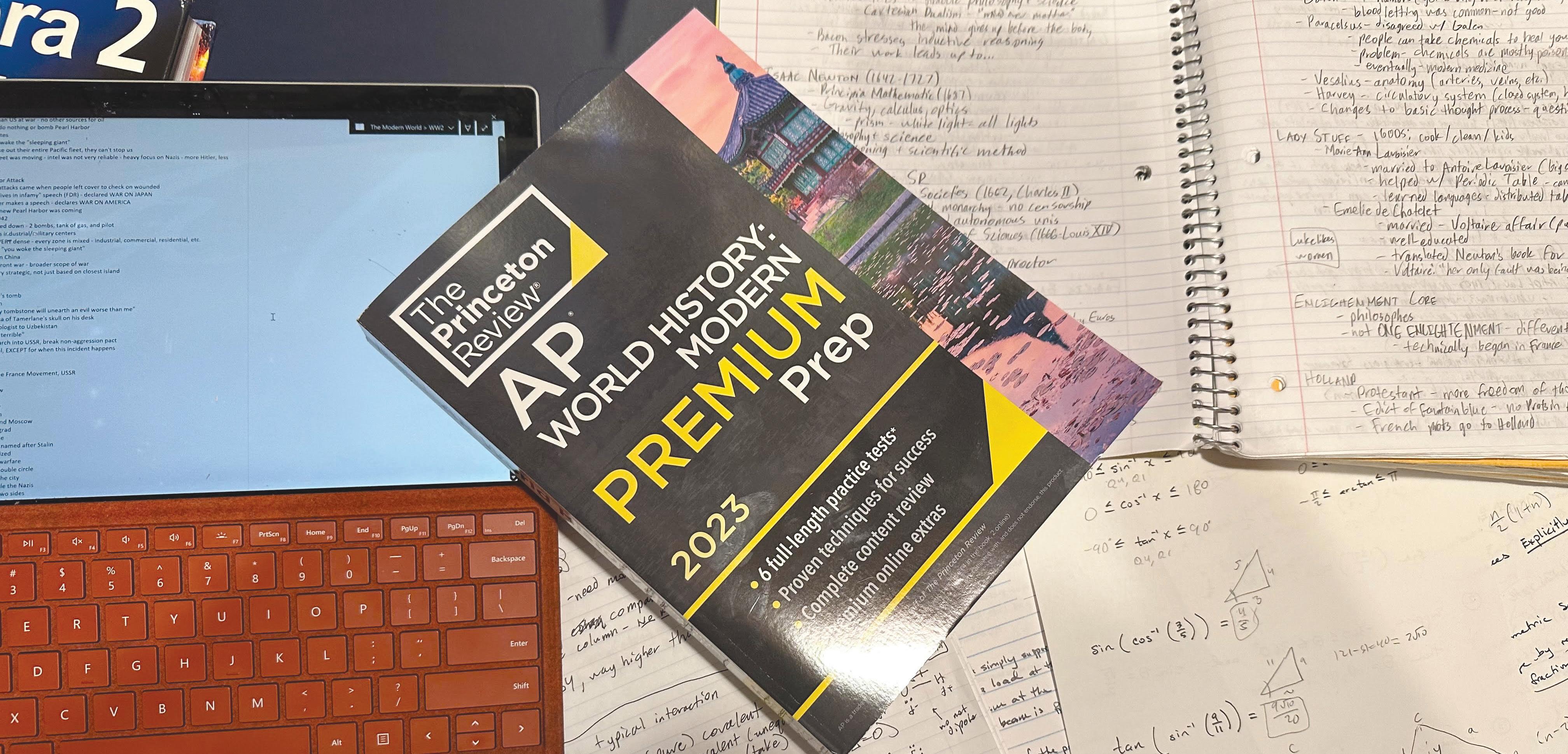
“We know that if you're going to be successful at that next level, you have to have a foundation,” Mlakar said. “For instance, in the sciences, we don't want kids taking AP Physics 1 until they've done biology and chemistry because they need to show that they’ve mastered that material and that they can handle that level of work.”
History and Social Sciences Department Chair David Fisher believes freshmen and sophomores should be more focused on learning the material than worrying about the GPA-related benefits of an AP class.
“The school does not want to put itself in a position where students are taking classes because it gives them a grade point boost,” Fisher said. “Students should
be taking classes to build up the requisite skills and knowledge so that they can perform well, appreciate good literature, become good math students, and so forth. In a sense, the grade that you get or the ranking that you achieve as a student should be immaterial.”
When it comes to AP courses, the school firmly emphasizes quality over quantity.
“From what I've observed in public schools, students end up overvaluing the letters and the credentials as opposed to the learning itself,” Fisher said. “I see public school students graduating with 16 different APs by the time they're finished. Do they really know that much more than your St. Mark’s student who may only have just a few APs under his belt? I think not.”
Fisher believes freshmen are not necessarily developed enough academically to handle the level of material taught in AP classes, and students should understand the classes' true purpose.
“These courses are meant to be equivalent to the first-year courses at university,” Fisher said. “Why on earth is a ninth-grader exposed to that material? Is that student really assimilating the information and understanding or learning just enough to get a particular grade? I have a feeling that with some of those subjects, it's the latter rather than the former.”
However, several students are worried about how not being able to take AP classes for the first two Upper School years can impact on college admissions.
“Colleges start with a scan,” Sophomore David Gershenson said. “They look at your report card. They ask, ‘What are your grades? What’s your GPA?’ They

After winning the school-wide Poetry Out Loud Competition, Sophomore Lukas Palys was selected as one of 10 state finalists to battle for a chance to compete in the national competition.
Unfortunately, Palys wasn’t able to go due to an interference, which shattered his chances of going to nationals.
“I really wanted to go and worked really hard to prepare the poems for it,” Palys said. “And since last year, it was my goal to win the national competition. So I was really excited this year when I found out that I had qualified for the state competition. Not being able to go was disappointing, but hopefully next year I'll be able to win the school competition again.”
The first step to preparing for the competition comes when it’s time to choose a poem to recite.
“Choosing a poem actually takes a pretty long time, because you need to find a poem that fits you well and that you can convey emotionally,” Palys said. “Then once you've picked the poem, you read it about 100 times every day until you understand the poem really well. Why did
the poet write the poem? What was the message behind it?”
The next step comes when it’s time to memorize the poem.
“By this point, it's not even hard to memorize because you've read it so many times,” Palys said. “What I usually do is I try to recite it emotionally in a different way every time. Two recitations are never the same, so it's more of an interpretation thing and less of a memorization.”
Palys first got involved with Poetry Out Loud in freshman year through Mr. Morris’ class, when he decided to try it out due to his background in singing and acting.
“Singing is already poetry in the first place,” Palys said. “So when you take poetry, it's just singing without music, but it's a very unique way to convey emotion through a language that no one really speaks. Poetry speaks in columns, and these columns are perfect arrangements of words that convey emotions that you don't really feel or understand.”
Palys plans to continue doing Poetry Out Loud in the future, and possibly pursue the arts later on.
“Even if I don't win, it's just a really fun thing for me,”
aren’t necessarily always able to take into account where you go to school, how hard the courses are, or if you go to a private school. They’re always going to try, but they might miss it. Say you’re a B student at St. Mark’s in classes that are a step above classes in public school. How can you trust that universities are going to always see that you go to St. Mark’s?”
Fisher responds to such claims by bringing up schools that have let go of the AP system altogether. Many schools abandoning AP classes make the claim that their school-specific course is better for students than the AP curriculum.
“Take Andover and Exeter for example, their APs are very rare,” Fisher said. “The one AP that you might be able to take is AP US History. There’s just one or two. Last I heard, Harvard routinely takes 30 graduates of Andover, so it's not a problem for them.”
In Fisher’s Microeconomics and Macroeconomics AP courses, around 90% of his students get a 5, the highest score possible, on the nationwide AP exam. Fisher still believes that AP exams can serve as a baseline for students all over the country.
“As an American school in this country, we have touchstones that link us to other parts of the country, and one of those touchstones is having an AP program,” Fisher said. “We teach an AP US History class, so does a public school down the road, and so does a school in California. It also allows us to say, ‘When our students take the AP History exam, they do really well.’ When we say we're a good school that teaches students well, we have an objective measurement.”
Palys said. “I don't really read a lot of poetry outside of competing for Poetry Out Loud, so it's good for me to read poetry and get into that genre more during that time period. It also boosts my acting versatility, since acting out poems is different from something like acting out a play. So I would definitely continue poetry in the future, or at least for these next few years. And then in college, maybe doing something musical or acting.”
$50K
total rewards for national competition winner
finalists chosen by Poetry Out Loud per state 10
first year of the competition 2005
LUKAS PALYS
“
Is the student really assimilating the information and understanding or learning just enough to get a particular grade?
DAVID FISHER History and Social Sciences Department Chair
Throw the elbow. Jab the knee. Break the grip. Take him down. Moves like these resemble those taught to protégés of the martial arts, but the students learning them at the Hockaday School aren’t training for a clean fight supervised by a referee.
Instead, these young women at the all-girls’ school prepare to fight a very real enemy: sexual assault. In a world where one in every four American women will become a victim of attempted rape, the Hockaday School has decided that self-defense is a subject deserving at least the same respect as calculus, Spanish or economics. Learning self-defense is a necessary but unfair burden put upon female students by a world that can’t respect a simple “No.” Here at an all-boys’ school, a place that sends giveor-take 100 men per year out into the world, the curriculum already includes education on the topic of consent, but — in a world where girls must learn to fight — are boys doing enough?
At St. Mark’s, education on the topic of healthy relationships consists of a general emphasis on boundaries in the Lower School, sex education courses in the Middle School and annual class assemblies featuring activists — such as rape survivor Katie Koestner — in the Upper School. According to St. Mark’s Director of Counseling Dr. Gabby Reed, consent education is part of the school’s overarching goal of producing virtuous men.
“We want our students to be respectful citizens who can form really meaningful relationships,” Reed said. “We know relationships are the backbone for happiness. If you can see somebody in a respectful way, value them and their boundaries and respect them, then you can be in a happy and healthy relationship.”
At the Hockaday School, meanwhile, students attend a semester-long mandatory self-defense class taught by selfdefense instructor Jessica Jasper, a Brazilian jiu jitsu champion and former bodyguard. In the class, Hockaday students first learn mental and social self-defense.
“We start off with an understanding of what makes a person likely to be victimized,”
Jasper said. “We call that being a hard target or an easy target, and we learn about what it takes to be a hard target. Then, we have discussions and lectures on situational awareness and verbal de-escalation tactics, which we call verbal judo.”
Another component of Jasper’s self-defense class is teaching girls how to simply, properly and effectively communicate refusal.
“I teach consent in terms of the ability for a person
to say ‘no,’” Jasper said. “Saying ‘no’ isn’t just in terms of intimate relations with others but also in all sorts of different situations, such as knowing how to say ‘no’ to pushy salespeople. Saying ‘no’ effectively means just saying ‘no’ without providing an apology, an excuse or a reason.”
Jasper stresses the importance of these deescalation tactics, but the fact is that not all attackers can be defeated by verbal judo. When verbal judo fails, Jasper instructs Hockaday students on how to move on to the real thing.
“The martial arts aspect is what we call physical defense,” Jasper said. “We learn a lot of different cool stuff like how to throw elbows, knees, how to do basic types of takedowns and how to break grips. Essentially, the goal is to build confidence in knowing what we’re all capable of.”
While Jasper believes her role in educating women is vital, she acknowledges that educating men on the topic is an equally necessary task.
“As much as I think it is proper, natural and good for women to be concerned to learn how to defend themselves, young men need to know all these things as well,” Jasper said.
To accomplish this goal of educating men, rape survivor Brenda Tracy founded the organization Set the Expectation. Tracy and her organization work with coaches, athletes, sports fans and colleges across the country in order to get men involved in the mission of ending sexual violence.

“Of course, women are disproportionately affected by this violence, and it’s perpetrated mostly by men,” Tracy said. “Ninety-eight percent of this type of stuff is perpetrated by men, and it’s interesting that [women] are seen as needing to be educated more than guys. That’s backwards.”
Tracy notes that much of current consent education targeted at men erroneously treats whole audiences of males like culprits, alienating men from being part of the solution.
“A lot of times, the education that is specifically pointed at males is like ‘We’re going to bring in a police officer or a lawyer, and, if you do something, this is what’s going to
April is Sexual Assault Awareness Month. In light of a recent visit to the school by anti-sexual assault activist Katie Koestner, St. Mark’s’ relatively light curriculum compared to its sister school Hockaday and the school’s overall mission of producing good men — we have to ask: are we doing enough?

happen to you,’” Tracy said. “It’s like people talk to you as the problem and not as the solution. I’m not here to talk to you because you’re the problem. I’m here to talk to you because I know that you’re the solution.”
Tracy asserts that the solution lies in men ostracizing rapists and ending the enabling of sexual assault.
“We all need to take care of each other,” Tracy said. “We need to figure out who the 90 percent [good-intentioned men] are and align ourselves with them, then figure out who the bad actors are and create environments where they are not safe. Offenders only take advantage of situations or places where they’re enabled.”
According to Reed, consent education at all-boys’ schools can be hampered by a lack of exposure to women in collaborative settings. She believes that part of “consent education” could be simply creating environments that facilitate respect between the sexes.
“I think one thing that we could do more of is to add additional exposure to women and girls outside of dance experiences,” Reed said. “I think a lot of consent hinges on mutual respect, and seeing the opposite sex as your equal and someone deserving of that respect. I think that’s hard when we don’t have a lot of exposure in the classroom setting or in collaborative settings.”
Reed asserts this environment of relatively low interaction with women creates a uniquely hospitable environment for misogynistic ideas from media and, by extension, rape culture to intrude. “Problematic ideas of women generally come from the culture at large, like women portrayed in pornography, in movies and on social media,” Reed said. “There are many problematic messages out there for consumption, and the school then has to combat that by creating opportunities for boys to actually see the reality.”
Ultimately, what Jasper, Tracy, Reed and so many others want is to help men and boys become part of the solution to sexual violence so that men and women can form a happier, more collaborative and more peaceful society together.
“At a very obvious level, we would never want any of our students to disrespect or harm someone else,” Reed said, “but the bigger answer is that we want people to be able to collaborate with others respectfully and to maintain healthy relationships.”
“ We believe the work of ending gender-based violence and inequality cannot rest only on the backs of those most affected by it. We believe in the power and agency of men as the solution, and it is only when we partner with men as champions for change, that we will make tangible progress toward safety and equality for every person, regardless of gender or gender identity.
In order to get a truer understanding of what Hockaday and St. Mark’s students think and feel about the issue, we gathered together two students from each school to discuss the topic in an open forum.
Shreyan Daulat: How would you evaluate the extent to which St. Mark’s has prepared you on the topic of consent?

Senior Bowden Slates: I think the school has raised us knowing how serious consent is. But I think that that the story [of Katie Koestner] itself is extremely eye-opening and extremely thought-provoking because you hear about it all the time on the news.
Senior Jacob Grossfeld: I think bringing in someone that has experienced it and gone through it made us kind of see how it affects people. We don’t get taught about it too much, but hearing from [Katie Koestner] really opened my eyes.
SD: Do you think something more than just a talk once a year — like some sort of classroom experience — might be more impactful?
JG: I think it could be. I’ve been helping out with things like the seventh grade health and wellness classes that [Director of Counseling Dr. Gabby Reed] teaches, and it seems very helpful to them. Obviously, they don’t speak about as serious topics as this, but I think, once every month or two, it would be helpful to just hear about it more frequently than just once per year.
BS: Yeah. Figuring out healthy relationships are really important, especially going to an all-boys’ school. There are guys who don’t really know how to maneuver those kinds of social situations, or how to create relationships and foster them, so I think those conversations could be really helpful, especially for the younger kids, just to put it into the air at least.
SD: Do you feel it’s unfair that St. Mark’s has a smaller curriculum on consent than Hockaday?
Senior Abby Carlisle: We take a self-defense class and learn how to protect ourselves if we’re ever in those situations, and you learn
how to prevent finding yourself in situations where you’re not able to give consent or anything like that. Among the student body and a little bit with the health faculty, there’s a bit of frustration that we have to teach ourselves to protect ourselves rather than a once-a-year class for the boys.

Senior Brie Johnson: Yes. I would say we definitely get taught more so on the defensive side of it, like always putting up your guard and putting the responsibility on us to make sure that nothing bad happens to us. I feel like it’s a little different because instead of learning about what consent is and what consent means, we’re learning about what to do if somebody doesn’t take your “no” for a “no” and how to avoid those situations given how common they are.
SD: In your families, are these conversations ever brought up at the dinner table or when y’all are together?
AC: I’m an only child and only daughter, so my parents are very protective of me. Going into high school and now going into college, they have stressed that I need to keep myself out of situations where I could get hurt. It’s not brought up a lot, but when it is, it’s usually a serious conversation.
BJ: It’s almost like a set of rules that we live by and that we get told constantly. Before I go out, it’s like, “Don’t get into an Uber alone, never be without another girl with you and don’t accept drinks from strangers.” There’s definitely a big fear factor from a lot of our parents because — as young girls who see the world a little bit more optimistically — we’re not always on the lookout for what could be a dangerous situation.
BS: One thing they talk to me about is communication and how key it is especially going into college and how, once you’re fostering these relationships, to talk to the person to make sure that you’re never making them uncomfortable.
percent of women have experienced sexual violence during their lifetime. >50
1 in 4
women have experienced completed or attempted rape in their life.
female rape survivors reported that they were first raped before age 25. 4 in 5
$122,461
SOURCE / CDC.gov
estimated lifetime cost of sexual violence per survivor, including medical costs, criminal justice and many other costs.
I think the last thing you would want to do is leave that mark on someone or do something to them that they didn’t want to do.
SD: When you hear the burden that is put on girls to not be attacked, how does that make you feel?
JG: It’s crazy to think how much they have to go through when we just don’t really have to worry about it. The fact that they have to pay attention to how they dress and what they do is just awful.
JACOB GROSSFELD Senior
BS: There’s a lot of disgusting people in the world and a lot of disgusting men who will take advantage of their size or stature, and I would hope to believe that all the men here are good men and do understand those principles. It’s important for us since we do really understand those principles to be active voices.
SD: Do you think St. Mark’s guys would be comfortable stepping in to tell a friend they’ve gone too far?
JG: The culture here has been to accept that, and I feel like a lot of people wouldn’t want to step in unless it’s really far. But seeing how it affected someone like Katie Koestner really affected me. I think it definitely affected everyone else as well — to see how it can affect you and stay with you for your entire life.

 BOWDEN SLATES Senior
BOWDEN SLATES Senior
BS: I think as a class we do really take that stuff seriously. If you ever hear that someone could have made a girl uncomfortable or something, that guy is immediately getting talked to by multiple people — like “Hey, that’s not right. Don’t ever do that again.”
NEVER ASSUME
CONSENT CAN BE WITHDRAWN REMEMBER WHAT WE’VE LEARNED BE SPECIFIC
ARE WE BOTH COMFORTABLE?
Military enlistment has been on the decline. Last year, 10% less students applied for the United States Military Academy. That begs the question — have less Marskmen been applying to service academies? What are service academies actually like? We talked with three Marksmen to find out.
Clad in polos and khakis, the basic cadets walk hurriedly under the light gray stone, their black bags and suitcases in hand. Sweat trickles down their faces amid the booming voices of the upperclassmen, yelling and urging them to move up the ramp. Faster and faster and faster.
But just a few years ago, these upperclassmen, with their stern faces and intimidating commands, were yelled at just the same, sweaty and stressed, by those who came before.
Because every cadet at the United States Air Force Academy walks up the same ramp. Under the same stone.
On that stone 10 words are spelled out. Three simple sentences. One unifying motto.
“Integrity first. Service before self. Excellence in all we do.”
Over at the United States Military Academy at West Point, it’s “Duty, Honor, Country.”
And at the United States Naval Academy, “Faith, Courage, Service true, with Honor, Over Honor, Over All,” the last line of a march written for the graduating class of 1907, carries the same tone. A tone that is echoed in our own motto, “Courage and Honor.”
With such striking similarities to the school’s moral handbook, it would only seem appropriate that Marksmen in particular wouldn’t have second thoughts about applying to the service academies.
But across the nation, military enlistment has been declining. In 2022, the Army missed its recruiting goal by a significant margin, while the other services barely met their active-duty recruiting goals.
It seems clear — Americans seem to be less enthusiastic about volunteering to serve in the armed forces.
But, in recent years, have Marksmen felt the same way? What would even motivate someone to commit the next decade of their life to the military? Are the academies even a good fit for Marksmen?
After all, in the case of the Naval Academy, the midshipmen bear blue and gold.
From a young age, the call to serve beckoned to varsity wrestling head coach Reyno Arredondo ’87, who served in the United States Army for 30 years. He grew up playing soldier with his brothers and friends. Two of his uncles had served in Vietnam. Both of his older brothers were soldiers.

For him, the military was in his family.
So after high school, Arredondo enlisted in the army with the goal of gaining admission into West Point.
“I never regret enlisting as a soldier,” Arredondo said. “It gave me an opportunity to grow and mature as a person. Then I could truly commit myself to the service academy.”
At West Point, Arredondo believes each cadet was beaten down so that their character could be reformed.
Before entering basic training, male cadets must first shave their heads and every motion the cadets make must be on point. Reprimands in the form of yelling at cadets are commonplace.
“It’s not called hazing,” Arredondo said. “It’s called developmental learning. There’s a whole training rationale behind that to ensure cadets are humble leaders.”
Upon graduation, not all of these cadets will fight in
the battlefield. Having double- majored at West Point in systems engineering and foreign languages, Arredondo himself worked in military intelligence. He had the task of befriending the former president of the Kurdistan Region, Masoud Barzani. And by doing so, he ultimately helped set up the historic meeting between Iraqi and Kurdish leaders.
“The army is like a big corporation,” Arredondo said. “You need guys who are adroit in finance and accounting, lawyers, doctors, and a whole range of people to help you run this big international corporation.”
And not all cadets have to serve in the army either.
“One of my best friends, who is now well known in the cybersecurity world, was a computer science engineer,” Reyno said. “And he wanted to go into the Air Force, because they’re the leading edge in technology. So after graduating from West Point, he went into the Air Force.”
Arredondo, however, joined the army and has made many lasting friendships there.
“You go through a lot together that you wouldn’t anywhere else,” Arredondo said.
As he rose in rank, Arredondo received the opportunity to pursue further education. And in 2003, he received his master’s degree in foreign language from the University of Texas at Austin.
“My experiences in the military and with people across the globe is an incredible life experience,” Arredondo said. “That’s what motivates me — sharing with Marksmen everything that I’ve learned as a person and drawn from my military experience.”
And, throughout his six years coaching at the school, Arredondo believes he’s had a steady stream of open ears eager to receive this experience.
“Every year, I see around two to five Marksmen that are focused towards going to one of the academies,” Arredondo said. “I haven’t really seen a decline, and it’s been pretty consistent.”
June 27, 2018.
Thirty-three days after standing at the podium as senior class president and recounting his memories as a Marksman to hundreds of people at commencement, Edward Ro ‘18 was walking up the same ramp all Air Force Academy cadets do.
And soon after walking under the “Core Values Ramp,” he was plunged into six weeks of basic training — learning everything to do with military discipline, teamwork, and mental resilience.
It was a lot of waking up quickly, standing at attention in the hallways and a lot of marching.
And everything was regimented. Even meals.
He learned to sit in the front 2/3 of his chair, to look at the 12 o’clock on the plate he would eat and to chew and swallow in less than seven bites.
He wasn’t allowed to have a phone or watch. The only way for him to talk to his parents was through letters. He remembers marking the position of the sun by putting sticky notes on his window when meal times were called to know roughly what time it was. It was a bit of shooting and leading small groups. A lot of pushups and memorizing quotes. A
bunch of adaptations.
“I was pretty used to going to bed pretty late at St. Mark’s,” Ro said. “And I was definitely not waking up at six.”
Though not as strict as basic training, cadets remain under strict guidance through freshman year.
“After classes, you still have mandatory training you have to go to,” Ro said. “You still can’t wear regular clothes. You can only wear a uniform. You can only close your doors after a certain time during the day.”
But after recognition, a three-day event at the end of freshman year, the freshmen become upper-class cadets. And Ro says after recognition, the Air Force Academy becomes a relatively normal college, with a bit of early morning military training sessions and set workout or intramural sports times.
When the academic year ends, summers at the Air Force Academy are nine weeks long. Freshmen have the first three weeks as a break, the next three as outdoor survival training, and the last three are up to them. They can choose anything from operating satellites to skydiving.
Ro put down Airmanship 490, the basic skydiving course, as his first preference. He had never skydived before.
After five days of training on the ground for 12 to 14 hours a day, Ro soon was on a UV-18B Twin Otter, with over ten other jumpers onboard. It would be his first skydive. Not a tandem. Not a static line. It was a solo.
10.7%
West Point Admission Rate via Admissions
8.4%
Naval Academy Admission Rate via Admissions

12.4%
Air Force Admission Rate via Admissions
“The scariest moment of that skydive was when the plane first took off,” Ro said. “You feel the whole plane rattling — going down the runway. And when the door opens at 4,500 feet you feel the wind rushing.”
Instructors called out “stand in the door.”
“It’s pretty emblematic of a lot of risky things you can do in life,” Ro said. “You can choose to stay in your seat and be comfortable, or you can choose to stand in the door and take that step into whatever uncharted water waters are like the free fall.”
He stood in the door. And he took that step.
“You stand in the door and then you just let go of the plane,” Ro said. “And you don’t feel a stomach drop or anything. You just gradually transition onto your belly, and your training just sort of automatically kicks in. You know how to pull the parachute. And after you pull the parachute, you do all the checks to make sure your parachute is
functioning properly. It’s a crazy experience.”
A crazy experience that he fell in love with. So, he applied for the Wings of Blue, the Air Force Academy parachuting team.
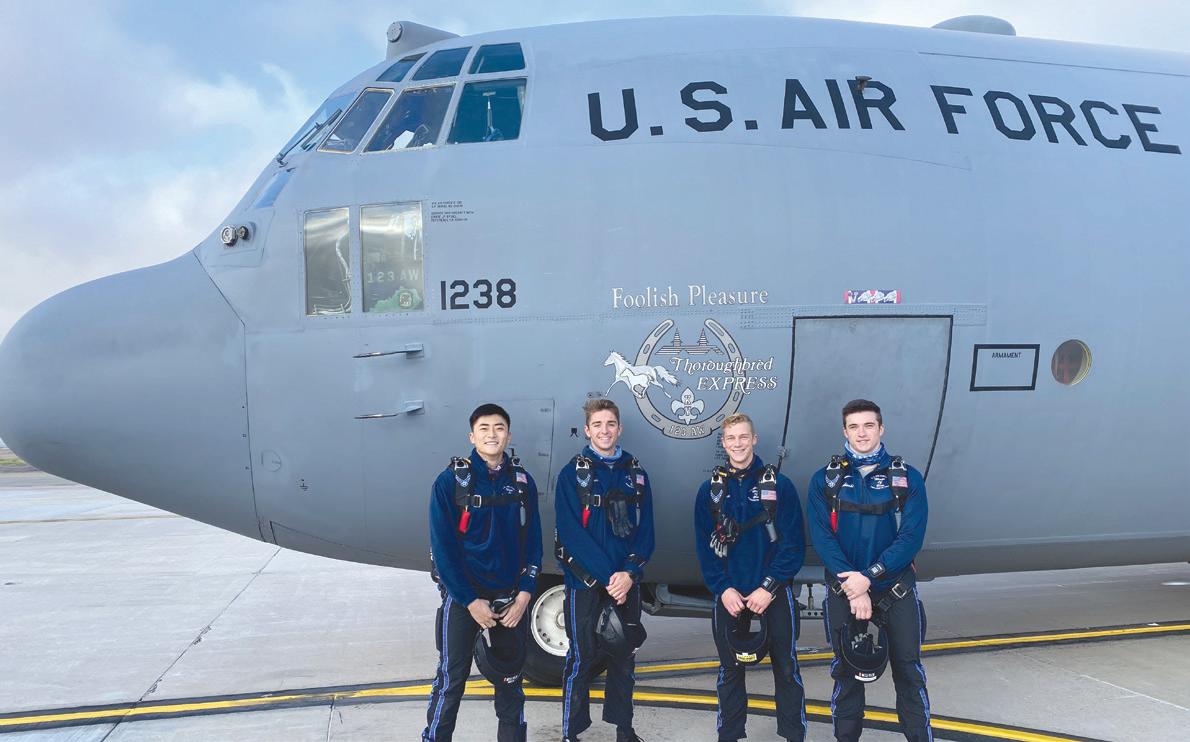
“The application process takes place over a whole day,” Ro said. “You get physically tested and mentally tested. They accept based on who they think they would be a great teammate and a great leader.”
And he was one of those 25 people who were accepted. Through Wings of Blue, Ro was able to make new friends and compete in parachuting and skydiving competitions such as the United States Parachute Association National Skydiving Championships.

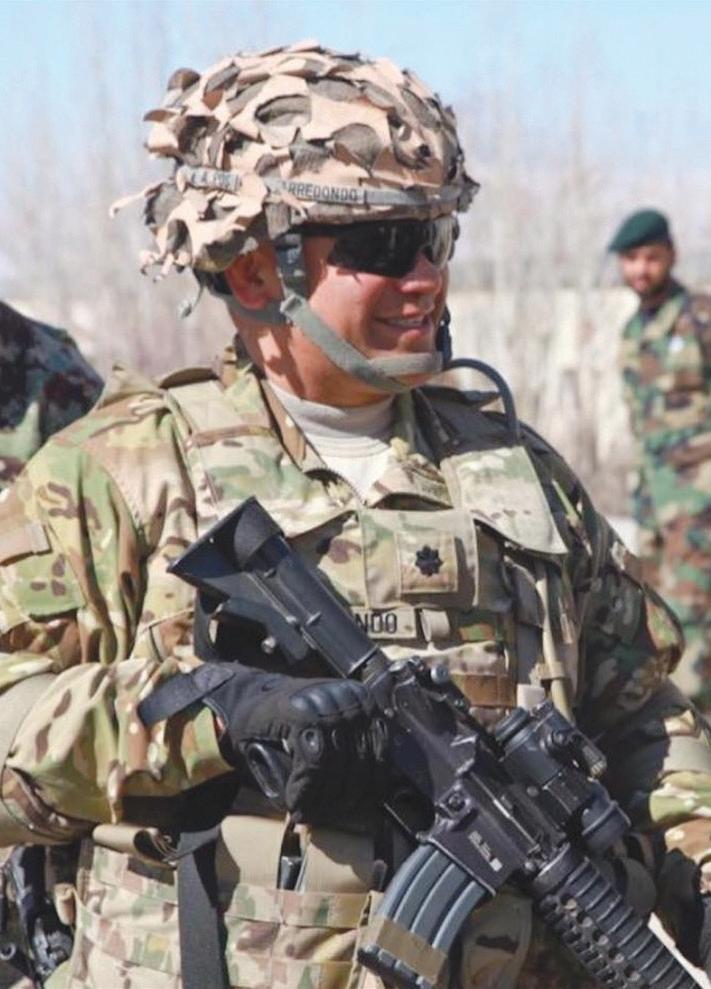
Fast forward to today, and he’s skydived over 500 times. And each time, he feels he’s built a stronger relationship with his friends.
“We sometimes did like eight to 10 jumps a day,” Ro said. “It takes a big mental and physical toll. And being able to push past that — I think that’s the kind of unspoken qualities that sort of joined us. Having a community like that was probably one of my favorite parts about skydiving.”
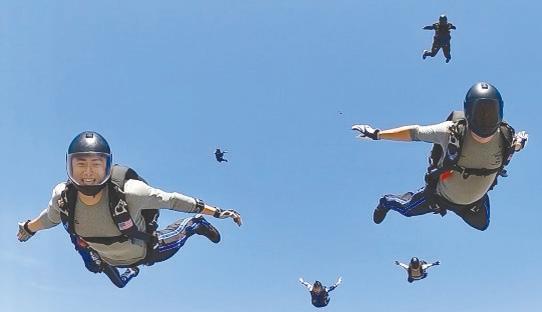
In addition to skydiving, Ro played club volleyball for the academy. With all these activities, Ro found out the hardest thing about the academy was time management.
Students at the academy are ranked based on their grade point averages, military performance averages, and athletic performance averages.

“It’s important to balance all three in the best way that you can within 24 hours, while also maintaining your social life and your wellbeing like your sleep,” Ro said.
Ro learned how to use his free time during the day. He learned how to use the small 15 to 30 minute intervals between classes to work. And they really added up.
“I think the biggest regret you have when you graduate from the academy is all the things that you didn’t get to do,” Ro said.
Even though he loves the academy, Ro was surprised at the amount of cynicism there.
“You would think that people who have worked years to get a spot at the Air Force Academy would be incredibly grateful,” Ro said. “But pretty soon, you realize that a lot of people there act like it’s the toughest thing in the world. They have
every reason to hate the place.”
For those going to the academy, Ro hopes they will recognize the hard work they had to put in to get accepted.
“Remember that feeling when you get in,” Ro said. “Keep that in mind when things get tough.”
Ultimately, the skydiving opportunities, clubs and military lessons would not have been available to Ro if he had not gone to the academy. And he feels that these activities taught him to be a good person outside of academics.
“I think what I loved so much about St. Mark’s was the holistic education,” Ro said. “And that’s what I wanted out of the Air Force Academy too.”
According to senior Michael Gao, it’s easy to get stuck on his phone for five hours. To procrastinate. And he wants to change this. He wants to shape up. He wants something different.

He’s visited Marksmen who’ve gone to service academies. And to him, they fit the bill.

“A civil college is not going to change me like that,” Gao said. “I'll probably be even worse. I guess my main fear is that after four years when I graduate, I look back to my senior year and it’ll just seem like I’ve wasted four years of my life.”
Gao feels that a service academy is his best bet.
“I don’t know if that’s the change I want,” Gao said. “But, hopefully, it’s going to make me better. Right now, I feel like I don’t have as much discipline as I want. I want to be able to delay my gratification.”
Gao was accepted into the United States Naval Academy and the Air Force Academy. Based on his first visit to the Air Force Academy, he thinks he’s probably going to go there.
“[The Air Force Academy] is in the mountains and outdoors where there’s little to no air pollution,” Gao said. “And when I visited, there was this smell of pine or wood burning, which I really liked.”
Dr. Xiao-Mei Zhao, Gao’s mother, visited the academy because Gao’s brother constantly brought the idea of service academies up.
“Where I grew up, in China, you go into the military either because you need
money or because you were not going to a good college,” said Zhao, who, along with her husband, are first generation immigrants here. “[Gao’s] brother talked about service academies all the time, but teenagers can change and can be easily influenced by other people. So it never occurred to me that they really wanted to join the military.”
Even though she seemed to look the other way upon their first tour, Zhao completely supported the idea once Gao was set on it.
“Service academies give you so many opportunities STEM-wise that civilian schools won’t,” Zhao said. “They give you the opportunity to work on hightech confidential projects, fly planes and work in nuclear submarines. It’s a good opportunity for American citizens. I didn’t have a chance because I was not an American citizen. My sons, however, can explore a different route.”
Zhao, who went to both Peking University in Beijing and Harvard University, knows civilian schools well. Competition is fierce. And she says most people aren’t team players.
“If I tell you what I know, next time you’ll be the best in the class and I’ll be number two,” Zhao said. “So I’ll hold out some of my information just to keep a distance ahead of you.”
In the military, Zhao believes there’s a lot more teamwork rather than a zero-sum game.
Even with his parents’ support, Gao isn’t sure if he’s cut out for it. Although he’s heard that the Air Force Academy is difficult, he wants to go through it.
“Because if I do survive the process, I'm going to become a changed man, not who I am today,” Gao said.
To prepare, Gao joined track to minimize the possibility of getting shin splints at the Air Force Academy and also to minimize his mile time.
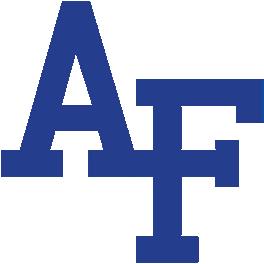
And in the end, Gao just wants to be a better person.
“I want to be someone people can depend on,” Gao said. “I want to be able to get the job done. I also want to be able to empathize with the average person. I want to understand your troubles and what you're going through. I want to be able to listen, but also have something worthy of listening to say.”
campus.
INTERVIEW Joseph Sun
While he started just as a music-loving student at school, Will McKinney-Raphelt ’05 has since transformed his hobby into a career at Sony Music Entertainment. See coverage, page 22
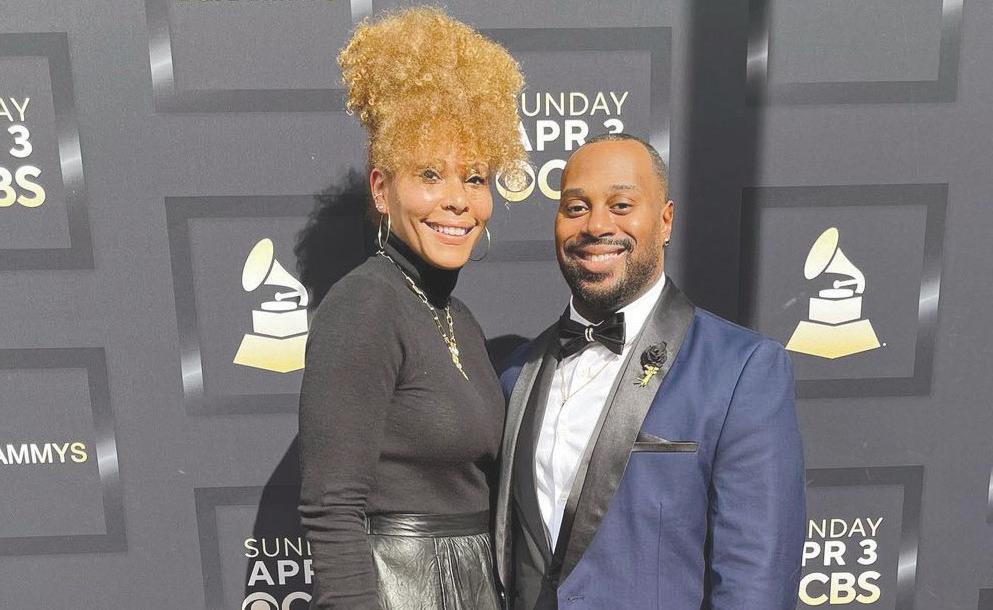

What’s going on here?
Benjamin Chen: In this painting, I think the pumpkin in the top left is the clear superstar. The intricate lines between light and dark bring out the depth and shape of the pumpkin. Even without the typical orange color of a pumpkin, it is pretty easy to recognize that it is a pumpkin, on a shelf in the piece. For the art piece as a whole, the sharp lines and clear edges bring out the unique perspective of the painting, which is why I believe this is one of my best art pieces to date.
SPRING BAND CONCERT The school’s band program will host its Spring Band Concert April 26 at 7 p.m. in Decherd Performance Hall. The concert program will feature works from performed by the Beginner, Middle School and Upper School Band classes. The pieces will showcase the talent of the band program through traditional, contemporary, pop and jazz genres including pieces like Mama Mia, Danger Zone and a composition written by senior Andrew Kogan. After the concert concludes, a potluck reception will take place in Nearburg Lobby.
2ND GRADE FINE ARTS EVENING
Second grade Marksmen will display their fine arts talents in a variety of artwork pieces and performances
What’s depicted here?
Carson Bosita: This piece is of a still life that was set up in the art studio. Since the technique here is about using value reduction, the total range of light and shadow was reduced to just black and white. The most challenging part of the design process was deciding where the cutoff between white and black would be on the rounded objects. This piece gave me a new perspective on everyday objects, and the ideas used in it have helped me create my other works.
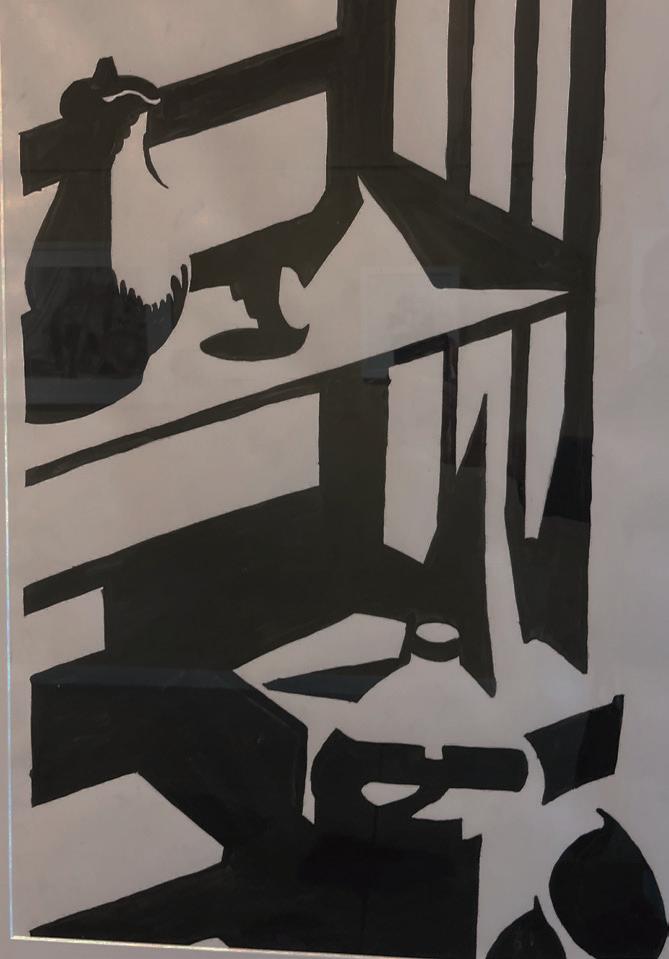

April 18 during the annual 2nd Grade Fine Arts Evening. The students will display pieces featuring art techniques from Mrs. Davis class, a variety of music instruments from Mr. Kheshtinejad's class, and selections of songs taught in Mr. Stroh's choir class. These various forms of fine arts will be displayed for the parents and senior buddies of the second graders.
ORCHESTRA RECITALS AND CONCERTS The Upper School orchestra recital took place Apr. 10 in Decherd Auditorium. The recital highlighted some of the solos and ensembles which will also be performed at the 53rd annual ISAS Fine Arts Festival in Fort Worth from April 13-15. Following ISAS, the Spring Orchestra Concert will
Upcoming events worth checking out.
WHEN April 21 @ 7 p.m. WHERE Granada Theater
take place on April 19 in Decherd Auditorium, with seniors Svanik Jaikumar, Akash Raghunathan, Aadi Khasgiwala, and Branden Song all performing concertos. The Middle School orchestra concert will be May 4th in Decherd. There is also an optional Middle School orchestra recital on April 25, which will be a chance for Middle School students to showcase their work.
APRIL CHOIR CONCERT The Upper School choir hosted a concert April 12 at 7 p.m., featuring pieces selected by choirmaster Glenn Stroh. Choir students also participated in the Independent Schools Association of the Southwest’s (ISAS) Fine Arts Festival, which took place the days after.
A preview of the first full-scale ISAS festival in four years.
Will McKinney-Raphelt’s journey since graduation.
A look at trending combinations in the best restaurants.
Octavio Medellín: Spirit and Form
WHEN Through May 14 WHERE Tower Gallery, Dallas Museum of Art

2023 Nasher Prize Laureate Senga Nengrudi
WHEN Through April 30 WHERE Nasher Sculpture Center
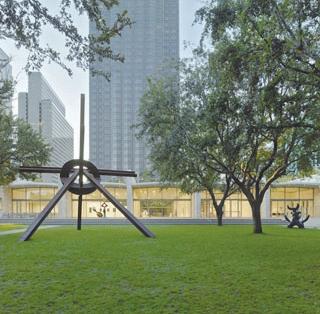
Whether photography, orchestra, drama, band, ceramics, choir or any of the other advanced fine arts programs offered on campus, more than 120 Upper School students spanning a variety of artistic skills will attend the first full-scale ISAS Fine Arts Festival since COVID-19 impacted the event.
Rooms packed with chairs, occupied by musicians of all genres. Displays upon platforms, showing off ceramics and woodworking. Prints upon easels, whether photographs or paintings. And so much more.
With the return of the Independent Schools Association of the Southwest’s (ISAS) Fine Arts Festival at All Saints’ Episcopal School April 13-15, Upper School students — from freshmen to seniors — are experiencing their first-ever full-scale ISAS festival after a string of canceled and modified events over the past few years. And whether it’s a senior finally sharing their work after finally exiting the “COVID-19 era” or the freshman experiencing their first advanced fine arts course, there’s so much Upper Schoolers have prepared to offer.
Though Marksmen have not attended a full-scale festival in over three years, Fine Arts Department Chair Marion Glorioso-Kirby says that students will still get to enjoy the same experiences offered before.
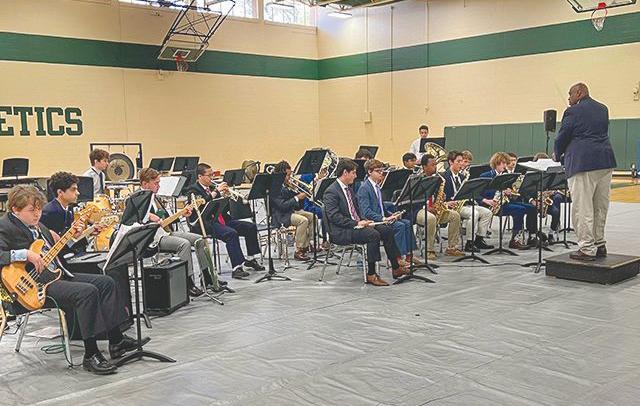
“Scheduling would not differ between grades,” Glorioso-Kirby said. “There is no difference in scheduling or programming, but there are new security and health measures for the festival.”
Over the course of the two-day event, students across a variety of fine arts disciplines will participate in 11 hours of critiques and performances, often in large ensembles or judging groups.
“Each artistic discipline has a performance or exhibit time,” GloriosoKirby said. “Performing arts and music ensemble students may have one to three events, visual arts students have a critique by a professional artist or university-level professor and our arts teachers arrange a second adjudication with a peer school.”
Between equally-demanding rehearsals and
additional workshops for the visual arts, students and faculty have a chance to enjoy performances and artwork from other schools. Glorioso-Kirby emphasizes a particular interest in art not present on campus.
“I enjoy them all and truly marvel at the diversity of performances and visual arts,” Glorioso-Kirby said. “Dance is a performing art that we do not offer at St Mark’s, so I enjoy watching the dance performances.”
Unlike performance halls or closed-off galleries, ISAS provides a much-needed communal aspect to the fine arts.
“The festival is an artistic sharing experience unlike anything else in the county,” GloriosoKirby said. “ISAS is the only school associate that supports an immersive arts experience to include visual, performing, and musical arts.”
ISAS is not only unique for its wide array of events — according to Glorioso-Kirby notes that although students intend to produce the best quality work they can, the event is much more than just a competition.
“50 schools and close to 3,000 students convene on one campus to share their artistic process, artwork, film and musical and acting talents,” Glorioso-Kirby said. “This is not a competition, but rather, a shared experience for high school students.”
Also part of the festival are an opening ceremony and occasional final event, one of which GloriosoKirby recalls as one of her favorite in her years of attending ISAS.
“I have so many [stories],” Glorioso-Kirby said. “My favorite would have been at the 50th anniversary of the festival at Cassidy. There was a huge party on their football field on Friday night of the festival. There were several bands and a DJ. Students and teachers from all the schools were dancing and jamming together under the stadium
lights!”
PHOTO / COURTESY MARION GLORIOSO-KIRBY
At its heart, ISAS is still an arts festival. Glorioso-Kirby says that the most meaningful experiences come from each and every performance, art piece, and critique.
“What surprises me year after year is the quality of work and commitment to the arts from students across ISAS,” Glorioso-Kirby said. “We learn much from each other by experiencing art together and talking to visual artists, musicians, actors, and filmmakers. I am amazed at the talent showcased at the festival and encouraged to keep pursuing excellence in arts education. The ISAS Fine Arts Festival inspires, elevates, and connects us.”
ISAS
BY THE NUMBERS
COMMUNAL EFFORT
Students and faculty attended last year's ISAS Arts Festival at Greenhill School and Parish Episcopal School. Though festivals were held in 2021 and 2022, the scale of the festival’s events were toned down due to COVID-19 restrictions.
3000+ 4
The Elevated Cooking club is making a push to restore their access to the school’s kitchens and cooking resources, a privilege that was lost due to COVID three years ago.
“We hit COVID and that put a wrench in everything,” club sponsor and history instructor Michele Santosuosso said. “Since we're pretty much back to normality, the one the one area that we haven't gotten back in is that partnership with SAGE and the cooking together.”
The idea for elevated cooking first started six years ago in one of Santosuosso’s history classes.
“The founder, Darius Ganji ’19, when he was a sophomore in 2017, sat right next to me,” Santosuosso said. “We just randomly started talking about cooking and food. It was one of
those lightbulb moments.”
Ganji and Santosuosso quickly realized that the club needed modifications in order to become a sustainable organization.
“We realized quite quickly that [the club] turned into him and I cooking for anyone who wanted to eat,” Santosuosso said. “That's not really a cooking club. We switched it the following year in the fall to tryouts. You didn’t have to be a good cook, it was just if you were interested. We did tryouts with SAGE in the kitchen after school. There were two days when you tried out, and it turned into a true cooking culinary club.”
As the club grew, they began planning more formal events.
“Darius held a cooking class with SAGE, we did a couple of bake sales where we prepped and cooked on the weekends, and we had a really good
partnership with [former Food Service Director] Erin Woods at the time,” Santosuosso said. “Darius graduated, and the club continued, but then [The club]cooks together on the weekends at [senior] George [Genender’s] house or [senior Stice Neuhoff]’s house, but having access to a real industrial kitchen was a really cool caveat.”

Santosuosso has started the arduous process of returning to the school’s kitchen, but she describes it as an uphill battle.
“First it was because of COVID and vaccinations, and we completely respected that,” she said. “Now, each avenue we go [down], there seems to be a bit of resistance. I’ll be brutally honest, I’m not sure where we go next. I’m not entirely sure if that’s even something the school will ever allow. I truly hope they do because it was such a rich experience.”
schools attending the festival total students at All Saints' Episcopal School this week
In Santosuosso’s mind, Elevated Cooking is more than just a club, which is why she continues to campaign for access to the school kitchens.
“It’s not just a bunch of dudes cooking,” she said. “It is a true passion of so many of our guys, so I do hope that we can have that place together.”
2017
50+ TIME
2018 2019
First club tryouts held Club founder Darius Ganji graduates
COVID restrictions force club to shut down 2020
A MERRY CHRISTMAS
McKinneyRaphelt worked with Mariah Carey on the 25th anniversary of her Christmas album.

THE CLAN
For the 25th anniversary of the album
Enter the Wu-Tang”, McKinneyRaphelt co-produced a documentary about them. RZA, Inspectah Deck, Raekwon and Masta Killa of Wu-Tang Clan, were there for the premiere.

CONTINUED FROM PAGE 20
From a young age, Will McKinney-Raphelt ’05 knew he wanted to do music. But he soon found out that the path to success in the industry would not be easy. After seven years of working as a music marketer, he landed a job at Sony Music Entertainment, where he started working with musicians like Mariah Carey, Kendrick Lamar and OutKast. We talked to him about his journey.
STORYPassion should take precedence over a paycheck. Will McKinney-Raphelt ‘05 has sought to live his life and focus his career around that very motto. In McKinney-Raphelt’s case, his passion is one that’s familiar to many others: music.
Receiving his first CDs from his dad at the age of four and a stereo to suit, his interest in music was sparked from a young age. But it wasn’t until he turned on the radio one day and heard Mary J. Blige’s “My Life” that he truly fell in love with the lyrics, the melody and the dynamics that every song has to offer.
From that moment on, he’d listen to thousands of songs and watch every single TV show related to music on MTV and BET.
When he began high school at St. Mark’s, that musical passion remained. But he didn’t want to sing. He didn’t want to play an instrument. He didn’t want to perform. No, his relationship with music needed to be something else, something he couldn’t quite lay his finger on just yet.
And it was the college counseling department that gave McKinney-Raphelt insight into the field of music marketing, pointing him in the direction of college fairs where he discovered universities like New York University, University of Puget Sound, Berklee College of Music and Belmont University — where he ultimately ended up.
“Growing up going to St. Mark’s, going to college was not a question,” McKinney-Raphelt said. “It was a matter of where and what I’d study. The college department definitely put things in perspective and helped set me on the right path for my career. Ultimately, turning to music business set my passion on fire.”
Since he was a kid, McKinney-Raphelt always thought he’d end up going to college in New York. After all, New York is the birthplace of hip-hop, his favorite genre of music. But even though it seemed like it was meant to be, McKinney-Raphelt would discover that life often unfolds in unexpected ways.
“I thought I wanted to go to New York University [NYU] because my parents took me to New York when I was 12, and then we would go every Christmas until I graduated high school,” McKinney-Raphelt said.
“I was absolutely in love with New York, but I wasn’t sure how I was going to get there. I thought NYU was the answer, but as it turned out, I ended up hating the campus because it’s literally in the middle of the city, and growing up at St. Mark’s got me used to a sense of community that you get with an actual campus. So I was really looking forward to finding something similar to that, and Belmont University was a perfect fit. The other thing that drew me there was Belmont University offered a program to intern in New York for a semester.”
During the fall semester of his senior year, McKinney-Raphelt took advantage of this opportunity and interned in New York, which helped him decide to move there after college.
“During the internship, I lived in New York for four or five months,” McKinney-Raphelt said. “I was commuting every day to my internship and really getting a feeling for what it was like to live in a big city, and I absolutely fell in love and knew that is where I wanted to be as soon as I graduated.”
Even though things were going well, McKinneyRaphelt wasn’t without his own set of challenges and hardships.
“My internship didn’t actually start until three or four months after I moved to New York,” McKinneyRaphelt said, “so I ended up getting a job waiting tables in Times Square. I was interning for around a year and a half before they offered me a full-time job. So I was waiting tables on nights and weekends while interning there during the day for a year and a half. I was trying not to get discouraged, but it was definitely not the easiest time of my life at all.”
However, his hard work and outright grit would soon pay off, as McKinney-Raphelt would find out.
HANGING OUT
McKinnneyRaphelt worked with Kendrick Lamar and Jay Rock in 2012.
“Once I ended up getting brought on full time,” McKinney-Raphelt said, “I worked with this record label by the name of [Razor & Tie], where I did my internship. I worked there as the radio and marketing coordinator for four and a half years. It was a small, independent record label, and I took on way too much that definitely exceeded my paycheck. But it gave me a
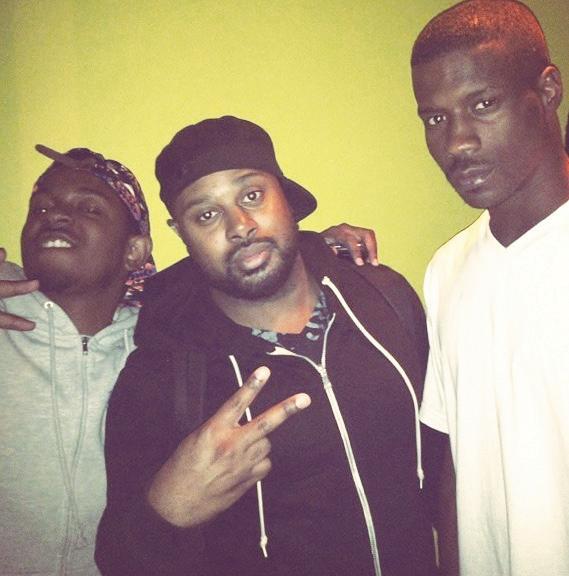
TWENTY YEARS McKinneyRaphelt helped out rapper Wyclef Jean for the 20th anniversary of Jean’s debut album, “The Carnival”
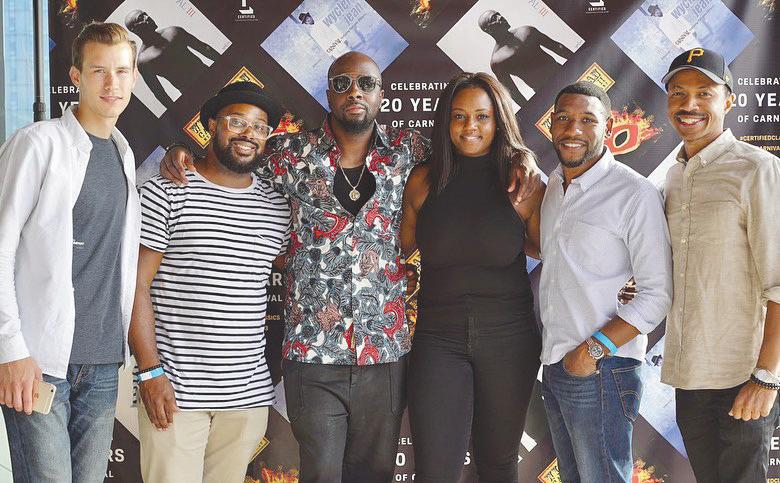
well-rounded perspective of what it’s like to work for a record label, and what all of the different departments are responsible for.”
His time working for Razor & Tie allowed him to realize his goals.
“From working there, I knew that I wanted to become a product manager,” McKinney-Raphelt said, “because I worked closely with the product managers and saw how influential they were in creating campaigns around albums, and I thought that was the coolest thing ever.”
Ultimately, living in New York showed McKinneyRalphelt there was more to music marketing than he thought.
“My eyes were opened up to the process of marketing and the fact that, in marketing, people do get to work directly with the artists because they help realize the vision,”
McKinney-Raphelt said.
Eventually, McKinneyRaphelt figured it was time to find something new.
“After four and a half years of working in New York,” McKinney-Raphelt said, “I was getting burned out, and I kind of saw the writing on the wall that said it was time to go. A former mentor of mine told me about a junior product manager role at Sony that was pretty much everything I was doing for [Razor & Tie], so I shot every shot that I could.”
Even though McKinney-Raphelt had applied for many jobs at Sony before to no avail, he was determined to make this one work.
“A couple of people that worked at [Razor & Tie] had recently moved over to Sony,” he said. “So I asked them if they could put in my resume, and I also asked my mentor who was also working at Sony if she could do the same. I cold emailed HR, doing everything I could to try to get in the door, and, luckily, I got a phone call. All in all, it took four interviews and a marketing campaign exercise in order for me to get the job.”
As such, McKinney-Raphelt has had to deal with the high-stakes nature of working with big-name artists.
“There is definitely pressure that comes with working with famous musicians,” McKinney-Raphelt said. “Obviously, you do want to step up to the plate to try to make sure that everything you’re doing and saying is going to impress those artists. Since they’ve been around for many years, they’ve already had a lot of great ideas and things happen to them, so you want to find ways to help them continue to succeed. It also helps that I’m on the outside looking in, so I know more about the artists than they do me. This way, they can’t really personally attack you if you don’t come up with a good idea, so that makes it a little easier to navigate. My job is really just an opportunity to show up and help the artists be even greater than they are, so ultimately it’s more of an opportunity and honor than it is a pressure to me.”
Focusing on his life-long passion for hip-hop, McKinney-Raphelt eventually created a separate division at Sony that was solely dedicated to promoting classic hip hop and R&B, which eventually became his full-time job.

“Naturally, a lot of these [hip-hop and R&B] albums mean something to those not just in the U.S,” McKinney-Raphelt said, “so I would often work with colleagues in different countries. I worked a lot with Italy, France, Japan, Australia and also Germany. So in 2017, I had the opportunity to work with Wyclef Jean on the 20th anniversary of his album ‘The Carnival.’ I ended up getting to go to Germany with him to do some promotion, and it was then that I saw first-hand how much Germany really loved hip hop. It amazed me that something so near and dear to me could be so near and dear to people in Germany despite the language barrier.”
As fate would have it, McKinney-Raphelt enjoyed Germany so much that he ended up moving to Berlin following Sony Music Entertainment Germany moving its headquarters there.
“I’ve been [in Berlin] since 2020, when I moved in the middle of the pandemic,” McKinney-Raphelt said.
Throughout his time in the field, McKinneyRaphelt has seen the music industry, especially the marketing side, undergo many changes. On the back of his experiences, he’s developed opinions about the current-state of the music world.
“When I first started,” McKinney-Raphelt said, “there were many more gatekeepers that artists had to prove themselves to in order to get the opportunity to become an artist at a high level. Nowadays, you just have to put out something on TikTok for it to catch fire and to possibly get a record contract out of it. The generation is changing because you look at artists like Drake, Kendrick Lamar and even Travis [Scott] and they’re becoming the OGs of hip hop now. There are a lot of younger artists coming up under them. What I do hope and wish for is that they take bit more consideration to the longevity of their career and find interesting ways to break the mold because I think there’s a lot of copy and paste right now. Rap is increasingly looked at as a hustle and a way to make quick money instead of an art form.”
McKinney-Raphelt has also developed a mindset that could be applicable to anyone interested in pursuing a career in music or the arts, or really anything there is to be passionate about — a mindset that has helped him get to where he is today.
“To anybody who is looking to pursue a career outside the normal threshold of what I feel is expected from kids who go to prestigious schools like St. Mark’s,” McKinney-Raphelt said, “Never let anyone defer you from your dreams. Not even your parents. If it’s something you believe in and something you’re passionate about, it is way more important to go after that than it is to go after money. I was taught at a young age to chase your passion, not a paycheck and the paycheck will catch up.”
“ Never let anyone defer you from your dreams. Not even your parents.
WILL MCKINNEY-RAPHELT Class of 2005
Across social media platforms, people have been sharing their own restaurant menu tips and tricks, creating a trend that has uncovered tons of mouthwatering orders. I’ve chosen and tried three offerings from popular restaurants around the city to see if the trends live up to their hype.
BY Hilton SampsonOrder and Instructions:
Grande Java Chip Frappuccino
Substitute heavy cream for milk as the base
Substitute three pumps mocha sauce for three pumps white chocolate mocha sauce
Add cookie crumble
This off-menu drink will certainly fulfill your craving for a sugary, caffeinated morning refreshment. The frappuccino is one of Starbucks’s most popular drinks, consisting of sugar, espresso and milk all blended together into one large, delicious treat.

As many are already accustomed to, the strong coffee flavor that comes with many drinks at Starbucks is minimized in a frappuccino, especially this one, masked mostly by the chocolatey flavor of java chips blended throughout.
In addition to the java chips, the addition of cookie crumble gives the drink texture and crunch, a nice contrast to the creamy components of the drink.
The substitution of heavy cream also adds to the smooth consistency and rich flavor of the frappe, making it almost taste like a milkshake.
It definitely lives up to its name, with each sip tasting just as flavorful as a serving of cookies and cream ice cream you would find at Baskin Robbins.
The price increases only nominally from the normal Java Chip Frappuccino with the addition and substitutions, so it is not a deterring factor.
If you usually don’t care for sugary foods and beverages in the morning, I wouldn’t recommend ordering this drink then.
But if you have an afternoon or evening sweet tooth, this cookies and cream frappuccino might just be for you.
When comparing this drink with others and Starbucks and beyond, though, there is really nothing too outstanding about it.
So unless you are just dying to try a cookies and cream frappuccino, I think you’ll be perfectly suited trying any other variation that you crave.
I chose to use the app to order, and it was surprisingly easy to do with convenient customizable tools right at my fingertips. So, if you aren’t looking to hold up the line in store, you can order this drink just as easily online.
Chick-fil-A Buffalo Chicken Mac & Cheese
Order and Instructions:
Six Chicken Nuggets
Medium Mac & Cheese
Zesty Buffalo Sauce, Garden Herb Ranch Sauce
Empty salad container
Add components to the container, mix well
While many believe Chick-fil-A’s menu only consists of limited options headlined by their trademark chicken sandwich, there is more than meets the eye.
Just a few years ago, Chick-fil-A added mac & cheese to their menu, and it instantly became a favorite. Now, social media goers are ready for something else new. But this time, they have taken it into their own hands.
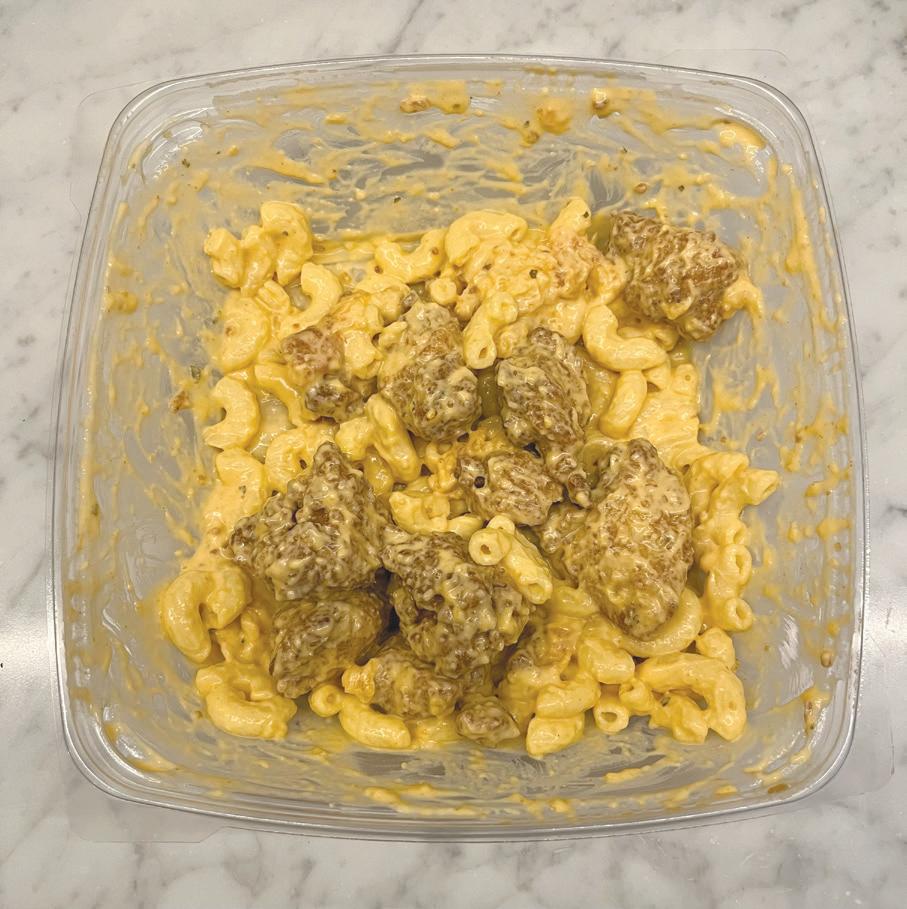
Combining some of Chick-fil-A’s most popular items has led to the creation of something entirely different: the buffalo chicken mac & cheese.
The restaurant has always been known for their fried chicken, and in this dish, their nuggets take center stage.
Mixed with the mac & cheese and two of Chick-fil-A’s most popular sauces, Zesty Buffalo and Garden Herb Ranch, the nuggets become a part of this viral new meal.
Unlike the other two items on this list, the buffalo chicken mac & cheese takes some effort to create, and that’s where the salad container comes into play.
I added each component to the box and mixed thoroughly, and after breaking up small chunks of the mac & cheese my mixture was ready to eat.
Taking my first bite, I could immediately taste the buffalo sauce which had combined smoothly with the ranch to create a refreshing, tangy taste, yet not overpowering in any way. The sauce covered the nuggets evenly, adding a refreshing dimension of flavor, and I could even taste the sauce with the already savory mac & cheese.
There is no added charge for this order beyond the cost of the items themselves, as you are required to mix the components yourself.
But overall, the dish felt disjointed, and the nuggets and mac & cheese didn’t combine as well as I expected, and the sauces themselves did not solely elevate the dish.
So the next time you find yourself at Chick-fil-A craving chicken and mac & cheese, I would recommend sticking to the basics and ordering them separately.
The new film 65 is the dullest movie of the year, making it incredibly interesting to discuss. This Adam Driver-led dinosaur blockbuster may leave audiences wishing for another asteroid impact to relieve them from watching, but analyzing why the film performed so terribly among audiences and critics alike reveals insight into the movie business’s next era.
The film starts on a floating beach resembling a second-rate bootleg of Pandora, the well-known planet home to James Camron’s Avatar franchise. The movie uses these first five minutes to hit its character development quota by giving Driver a family and killing them off.
The dialogue feels like it was written by ChatGPT, the VFX feels like it was made in one night, and the performances feel like the actors were reading off of cue
cards.
The movie has Oscar-nominated actor Adam Driver and $90 million at its disposal but works best as a future tax write-off for Sony.
For the rest of the runtime, 65 loses whatever footing it has, stumbling between imitations of The Last of Us, After Earth, and the directors’ own A Quiet Place. Although the movie barely reaches ninety minutes credits-inclusive, I felt stuck in the theater for 65 million years.
About that title. 65 gives no hints about the movie’s plot. The marketing team tried to fix this by adding the awkward subtitle, “million years ago prehistoric earth had a visitor,” but the damage was done.
It’s hard to recall a movie with this big of a budget where a decision like this wasn’t nipped in the bud by a higher-up. Anyone reading this can think of a better title, but 65 was somehow greenlit alongside a poster of Adam Driver holding a futuristic weapon, providing no further context to the name.
Although 65’s negative reviews could make it a hard sell, this horrible name fiasco only made the situation 10
PHOTOS / HILTON SAMPSONChipotle Quesarito
Order and Instructions:
Burrito
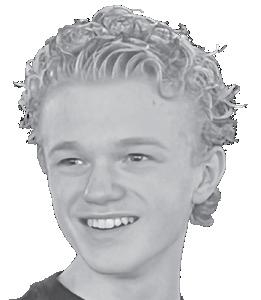
Substitute shell for a cheese quesadilla
Server will open the cooked quesadilla to add filling
Choose your favorite components
At first glance, this dish may not seem that different from any other burrito you would find at Chipotle. It might not be until you take the first bite that you do notice any difference.
But as soon as you do, your perception of a Chipotle burrito will change for the better.
The first difference that will be more easily noticed is the toasted shell of burrito, giving a comforting warmth to the dish and also an additional textural element, making each bite all the more enjoyable.
This toasted shell makes up the key component of this quesarito: the quesadilla.
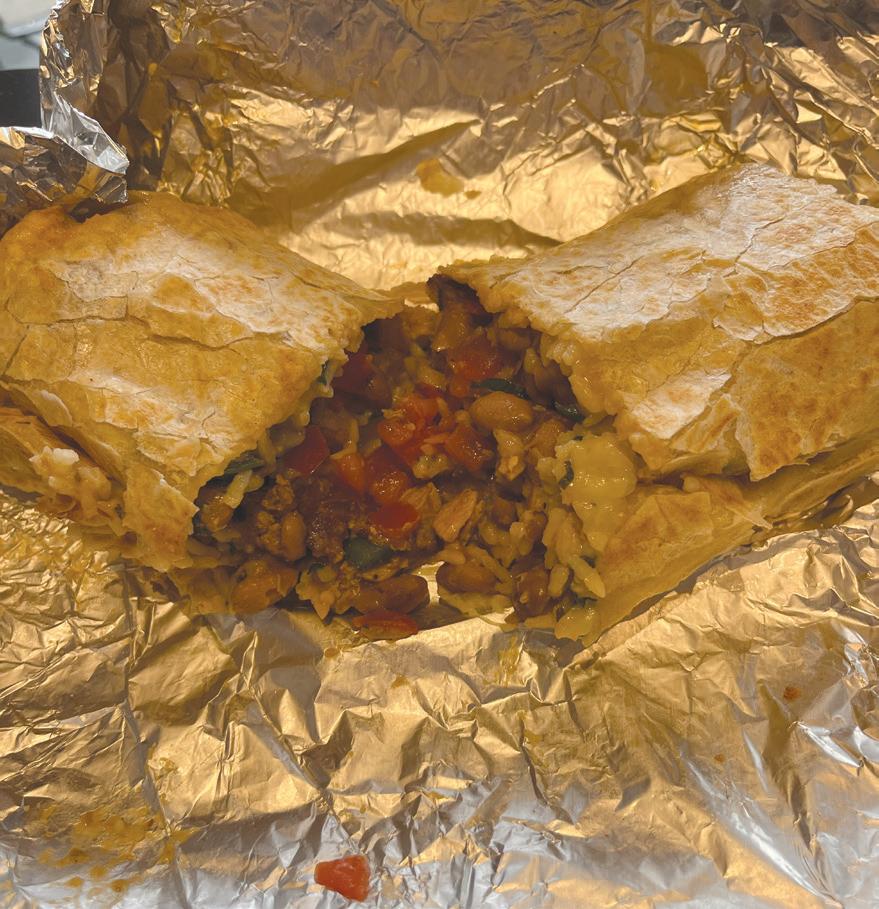
Once opened up and filled with your usual selection of rice, beans, meat and toppings, the melted cheese from the quesadilla totally changes the feel of the burrito by adding a whole new layer of mouthwatering taste and texture.
Just this simple addition of a quesadilla shell changes the burrito into something new and different.
By adding rich and savory flavor, the quesarito becomes a brand new dish that will only leave you wanting more, surely inspiring you to attend Chipotle more often than you already do.
If you desire comfort food and are looking to broaden your horizons, the Chipotle quesarito should do the trick.
Similar to the normal burritos, the quesarito is no light snack, so be prepared to chow down on a filling meal.
The components in the quesarito are just as flavorful and apparent as they are in the burrito, not masked in any way, ordering this dish will only elevate your existing order.
The quesarito is not available for purchase online or on the app, but the staff in the store knew exactly how to prepare the meal when I ordered it.
The quesarito costs $3.50 more than a normal burrito, but I think it is well worth the additional expense.
All in all, if you are looking to spice up your meal routine, I would definitely recommend trying the Chipotle quesarito.
times worse.
65 is only the latest in a long line of non-franchise big-budget science-fiction films that fail to make their money back. The list of biggest box-office bombs mainly comprises of big budget science-fiction films from the past decade and a half, offering a grim answer to the question of whether similar films will be made in the future.
Science-fiction films can be profitable, but contemporary examples such as “A Quiet Place” and “Ex Machina” are either low on budget or, with movies in successful franchises like Star Wars, continuations of a proven, profitable model.
Although “65” and the other mentioned bombs are nothing to write home about story-wise, their failure prevents future stories in the science-fiction genre from getting greenlit.
Audiences will soon forget about this movie, but studios will remember its financial failure and reaffirm that only microbudget indies and multi-million dollar franchises reliably make a profit.
NEIL SONG
TIGER YANG
ADVISER
JENNY DIAL CREECH
HEADMASTER
DAVID W. DINI
AUDIENCE
The ReMarker is intended for the students, faculty, staff and alumni community of St. Mark’s School of Texas. Press run is 4,000 copies, with more than 2,600 of those mailed out to alumni, courtesy of the school’s offices of External Affairs, Development and Alumni divisions.
OPINIONS AND EDITORIALS
Editorials represent the views of the Editorial Board and are not necessarily those of the Board of Trustees, administration, faculty or staff. All personal opinion columns, bylined with the writer’s name and photo, represent the views of that writer only and not necessarily those of The ReMarker, Board of Trustees, administration, faculty or staff.
SOCIAL MEDIA online viewing www.smtexas.org/remarker podcast
@focalpointpodcast instagram
@remarkernewspaper
READER INVOLVEMENT
The ReMarker encourages reader input through guest columns and story ideas. Contact the appropriate editor for suggestions.

LETTERS TO THE EDITOR
Letters to the editor are welcome and encouraged. They must be typed, signed and not exceed 300 words. Submissions are not accepted.
ADVERTISING
Contact the business staff at 214.346.8145. We reserve the right to refuse any advertisement.
Inclusion of an ad does not represent an endorsement by the school’s administration, faculty, or staff or The ReMarker staff members.
MEMBERSHIP
The ReMarker maintains membership in the Columbia Scholastic Press Association, New York City, NY; National Scholastic Press Association, Minneapolis, MN; and the Interscholastic League Press Conference, Austin.
Gifted and talented programs promote academic excellence and seek to inspire curosity into young minds, but with raising concerns about racial and economic equity, programs across the country are getting axed in favor of inclusive classes.
In classrooms across the country, there is a sharp divide.
While some elementary school classes spend time using paper airplanes to study air resistance, others monotonously spend hours on math worksheets.
Gifted and talented programs (GATE) have been a staple of the American education cycle for decades, but increasingly more schools are moving away from traditional specialization. Calls for racial and economic equity have led to a large pushback against GATE programs. Traditionally, children from lower economic backgrounds and from Black, Indigenous, People of Color (BIPOC) communities are heavily underrepresented. For instance, despite making up 15 percent of the national school population, Black students only make up 8 percent of students within GATE programs according to the U.S. Department of Education.
The problem lies in how the programs select students. Public schools receive a stipend to identify and promote gifted students but miss identifying. In Alaska, only 241 of their nearly 31,000 native students were identified as gifted. In addition, even when qualified for GATE programs, BIPOC students are more likely to opt-out.
While GATE programs are a clear indicator of the racial and economic divides, it is only a symptom of deeper
SIDE EDITORIAL
issues with the American education system. BIPOC communities are historically from lower socioeconomic backgrounds. Compared to eight percent of White Americans living in poverty, 27 percent of American Indian and Alaska Natives and 20 percent of Blacks currently living in poverty. The effects of poverty on both child development and education are well documented: poverty is typically accompanied by substandard housing, homelessness, inadequate childcare, hunger and under-resourced schools. These factors cause the 15 percent of children who live in poverty to underperform in both their academic and social lifes. In addition, the children of parents who did not attend GATE programs are more likely to not enroll, creating a spiral of inequality. Instead of scraping programs aimed at promoting academic excellence, policy should instead seek to address the deeper problems of poverty. Schools that do not face poverty problems perform significantly better on standardized testing and have much larger GATE programs. For example, most St. Mark’s students come from a highly privileged background and are supplied with the resources required to succeed. A culture of high expectations combined with ample resources and opportunities allows students the greatest chance of succeeding. While the school does not have explicit GATE courses, the level of difficulty
of the normal courses can be interpred as such.
However, even if problems of poverty and racial inequality are addressed, some problems still remain with current GATE programs. Fasttracked programs have the potential to create a stratified hierarchy within a student body. Students who catch the programs at the beginning become further and further ahead of their peers. As the divide between the students grows, students not on the fast-tracked program may find it increasingly difficult to keep up. Fast-track programs need to emphasize extra content, rather than quickly speeding through the regular coursework and creating this divide.
Students in GATE programs are also more likely to view themselves as gifted, serving as a placebo effect that boosts performance, while students not enrolled have the opposite effect. Cultural and economic change is required to solve the problems facing gifted and talented programs. More resources need to be provided to students from BIPOC and lower socioeconomic communities, and courses need to be designed in a way to prevent toxic hierarchies from forming within student bodies. Policy needs to be aimed at reducing the economic hardship facing students, and students from already disadvantaged communities need access to more resources to enable their academic success.
A cross campus, students are in a flurry of activity. Whether doing homework due next period or playing basketball with friends, students are given considerable amount of flexibility in how they can spent their free time. One of the primary benefits of the new schedule is the ability for students to choose how they want to organize their time. Which is why the sheer number of unnecessary meetings ranging from senior tuxedos to junior TIB talks are obnoxious. With the advent of email, one would expect the number of meetings concerning trivial things to go down. With the ability to message anyone
on campus, the amount of pointless meetings concerning the date and time of the next coffee house could easily be replaced by a nine-word email.
With the year coming to a close, academic pressure is ramping up. Finals, AP's and senior projects are taking up more and more of students time. When given the option between studying for a final or listening to a joke presentation for 25 minutes, several would choose the former. The simple ablity to be able to choose whether to attend or not would make the 'bonding' meetings more
enjoyable for those who choose to attend, and more productive for those who do not.
While it is important to gather as a class to encourage bonding, there are significantly better ways to do so. Class activities, when done right, can lead to more bonding and be quite fun, but when the activites are both required and uninspired, they are a simple waste of time.
As the year draws to a close, we hope the administration makes an effort to cut down on the superfluous meetings and give students the flexibility to choose what they can do during their free time.
There’s one request for advisors and the Upper School Office that constantly comes up when it is time to schedule classes: students wanting to take more than six classes, which is the official hard limit of how many of them one can take, no matter their difficulty or subject matter. Is this a justified rule that helps students not overload themselves or an arbitrary restraint on their freedom to study what they want? Front & Center Editor Will Spencer and Focus Magazine Editor-in-chief Myles Lowenberg give their takes.
At this school, there are countless opportunities, and the unfortunate truth is that no student will ever be able to take advantage of all of them. While such perfection is impossible, there’s something we could do to allow students to take advantage of more opportunities: removing the arbitrary limit of six classes per semester.
The limit unproductively restricts students from attending classes they would like to attend and establishes an artificially low ceiling for academic achievement. This limit has been especially painful for me and for many other journalism students. Those of us in the publications suite take four years of journalism classes that yield no required credits, and we are then forced to surrender an additional class our senior year so that we can fulfill the mandatory fine arts requirement for graduation in a year where options should be open for seniors.
The supposed goal of the limit is to force students not to take on an excessive workload, but why are we using the number of classes as a placeholder for difficulty? Any student who has attended more than a week at this school knows that a class is not a class is not a class. For example, AP Chemistry is dangerously close to killing me right now, while Acting 1 is — as I’m sure Mrs. Glorioso would be glad to hear — causing me less stress than wondering what I’m going to have for dinner. Pick six random classes at the school. Do it again, and you will have two astronomically different workloads. In other words, the number of classes is just about the poorest substitute for difficulty one could think of. Besides, I’m of the opinion that I should be able to take as difficult of a workload as I wish to. The school claims to possess a highly competitive academic environment, so why should I be prescribed a certain level of difficulty once I get here? If John Doe can take six AP classes in one year, then I should be able to take eight normal classes if I wish to do so.
I am one month away from graduating. While I, for the most part, don’t regret the classes I have taken in high school, I do regret that I could not take AP European History, nor Science Fiction, nor AP Computer Science nor Info Engineering. It doesn’t have to be this way for Marksmen of the future — if we can only get rid of the six-class limit.
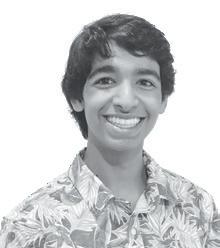

Isee them everywhere. I see them on the median near Preston and Belt Line on my way to school. I see them next to the underpass when I’m heading to get a dental checkup and on the corner of the road when I’m going to get a burrito from Chipotle. They wear tattered clothes and look like they haven’t showered in a few weeks, probably because they haven’t. I’m talking about the brave men and women who risked their lives to protect and fight for the freedom and liberty of one nation, under God, with liberty and justice for all.
So why isn’t there justice for these brave souls — the ones that fight the most for it? Most homeless veterans
Advocating for a hard limit of students being able to take only six classes is a weird position to take at a school like this, since I know fully that there are plenty of people throughout Upper School who can handle taking an extra class. Clearly, everyone has different abilities and interests, and no two classes are the same in the topics they cover and the amount of work they give. So why should the school simply mandate a number of classes without paying attention to these factors?
First of all, the difficulty almost doesn’t even need to be mentioned. I wish that class scheduling could be placed a little later in the school year — I bet when people are right in the middle of the last assignments of the year, they will be a little less inclined to try to stack yet another class on their workload. And once again, there are plenty of smarties at this school who can handle that, but that brings me to the crux of the issue.
Students here, especially ones who are very — one might even say unhealthily — competitive about getting great grades are not the best judges of whether they can handle their own workload. Telling your advisor you know you’ll do well in a seventh class and trudging through a school year’s worth of extra homework and tests are two very different things, and the time between those two seriously warps decision making.
Consider the upsides versus the downsides of taking a seventh class. Hopefully, everyone who takes that extra class will be comfortable with putting in extra effort and have a good time in the class, but the advantage for the person taking it is marginal at best. But the downside can be a total disaster. A time like junior year is hard enough already even for the most talented people in the school. I couldn’t imagine doing that without an extra free period and with even more tasks every day. It would seriously impact someone’s grades and enjoyment in every other class they are in, too.
Opening the floodgates on extra classes could even create some sort of nerd version of an arms race where people see their classmates taking more and being silent about the pressure they are facing, and so more and more people ruin their time at school. I love a lot of things about my classmates at St. Mark’s, but adding another class could exacerbate one of our worst tendencies.
come back from one of our wars in the Middle East with some combination of PTSD, physical disabilities, and substance abuse issues. The number of homeless veterans compared to the rest of the homeless population is extremely disproportionate to the number of veterans in the country. Despite being 7% of the total population, veterans, based on research from the Department of Housing and Urban Development, make up 13% of the homeless population. And to even get to 13% took hundreds of millions of dollars and years of effort. Seventeen years ago, veterans made up 24% of the homeless population. To add even more to the lengthy list of problems that they face, according to Veterans Affairs, they’re twice as likely to commit suicide compared to someone who never enlisted. And 43% of all veterans claim their mental health is worse than before they enlisted in the military.
All these statistics force me to ask myself, “Why should
I risk my life for my country if I’m steering towards a life spent under a bridge, asking random drivers for spare change at a stoplight?” And it’s why I don’t feel the need to jump at the opportunity to enlist myself in the army the day I turn 18.
But looking and interpreting those numbers the way I did misses the whole point of why veterans served in the army. They really took JFK’s “Ask not what your country can do for you” idea to heart.
When someone enlists in the U.S. military, they’re willingly risking their mental health, physical ability and financial stability.
They’re saying, “My country needs me more than I need myself.”
Regardless of whether or not their country truly needs them, they’re willing to dedicate every valuable aspect of their lives to a cause they believe in. And that’s something I’ll never be able to do.

We are happy to report it was shut down only once this year, and the seniors have kept it, uh, fine. In the words of Krusty the Clown, "It's not just good. It's good enough!"
We really do appreciate the hard work from sponsors and class officers that goes into planning some, but really: Some of them could have been emails!
Many here are grateful at this time of year for not having to worry about plusses or minuses on their transcript. We would give this an A+, but we'll be consistent.

The recent redesign of smtexas.org is a buttery-smooth three-point shot. We'll never give it up, let it down, run around or desert it.
Spring athletes have been winning games, filling bleachers and in one case, literally hitting the griddy. It's almost time for SPC!
We very much enjoyed the wisdom of our friends and classmates in recent chapel talks done by students!
Explore the constant daily struggle of balancing both club and school athletics. See coverage, page 30
Since 1958, the SPC has hosted tennis tournaments annually for athletes of conference schools to compete at. Individual titles and competitions for athletes independently representing themselves were never organized until this year.
Since the individual competitions are brand new, they are quite small with only a few competitors from each school.
“Each school can send up to two singles players and one doubles team to enter into a bracket with the other teams,” tennis coach Cameron Hillier 13’ said. “For singles, it would be a bracket of 16, while doubles would be a bracket of eight. The idea being a mixed bag of North Zone and South Zone all over.”

ON THE ROAD
The lacrosse team went on a trip to Arizona, where they faced off against two challenging opponents, Notre Dame Prep and Brophy Prep. Despite any fatigue from travel, the team had a dominant performance coming right off the plane. They won 13-4 against former state champions Notre Dame Prep. The powerful performance allowed for the younger members of the team to gain valuable experience on the field. The following day, the team took a well-deserved break to watch the San Diego Padres vs Oakland Athletics spring training game. Refreshed, the team returned to the field the next day to face the defending state champs, Brophy Prep. The team emerged victorious with an 11-7 win, thanks in part to stellar performances from senior captain Henry Boykin and senior Luke Stallings.
The Junior Basketball League, formerly known as the Sophomore Basketball League, is back for another season and is currently in the heat of the playoffs which opened with a play-in game between the No. 7 and No. 8 seeds March 20. Currently, the No. 1 seed, Teas and Threes, is set to play the No. 5 seed, The Dinner Club, after upsetting the No. 4 seed, The Dream Team winning the series 2-0. League Commissioners Juniors Alex Barrett and Bryan Graham plan to finish the playoff by the end of the month.
ALUMNI UPDATE As spring sports kick off for collegiate athletes around the nation, alumni athletes are proving they can keep up with the intensity. Evan McGowan ‘22, a rower for the Cornell Bears, had his first spring regatta with the team
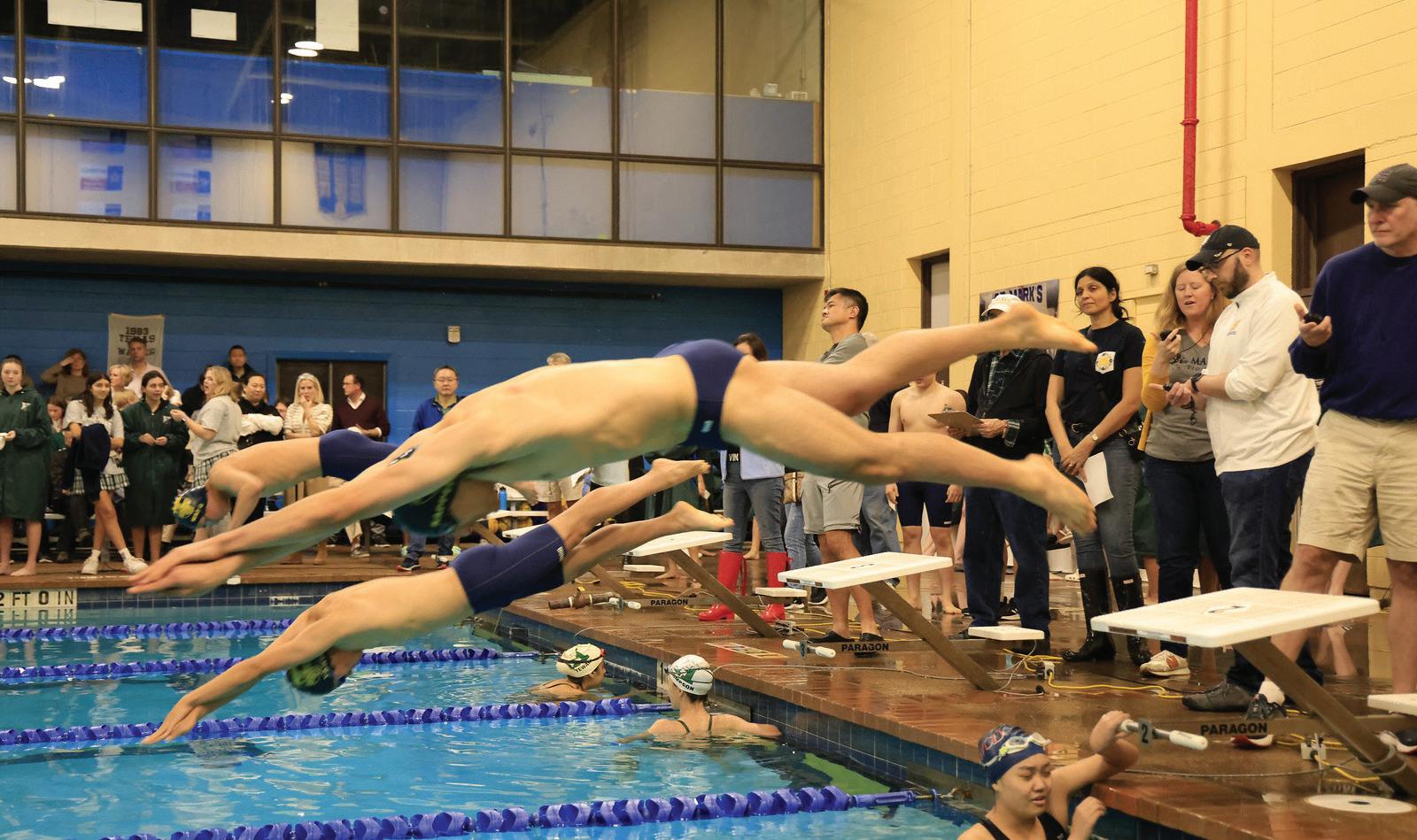
April 1. They went up against the Harvard Crimson and performed valiantly in a losing effort. Blake Hudspeth ‘20, a rower for the MIT Beavers, performed strongly with his boat at their most recent regatta, placing first against the Coast Guard and Army crews.

THE NEXT LEVEL Senior Brendan Kelly’s passion for rowing has led him to Bates College where he will continue competing at the next level. Despite visiting other colleges, he was drawn to Bates’ family-like community and the supportive culture of the team. Throughout the recruitment process, Kelly had a strong connection with the coaches and rowers, making it an easy decision to choose Bates as his home for the next four years. With his determination and dedication, Kelly is prepared to make a significant contribution to the team and pursue his goals both on and off the water.
How sports can change the culture of a community.
Hayden Meyers shares his experience playing airsoft.
Athletes describe their experiences and struggles balancing school and club sports.
sets won by the tennis team this season distance senior Julian Carlson threw in shot put games in a row won by the lacrosse team
Although the main goal for the individual tournament is to increase competition within the conference and provide a new challenge for the players, Hillier still plans to prioritize the team over the individual aspirations.
“My hope is in the future this tournament grows, but I still want to emphasize the team aspect,” Hillier said.
“If these guys have plans to play in college, it’s still a team sport. I feel like a lot of guys that travel around and play singles all the time, get a little burned out. It’s nice to have the energy of a team during an individual competition.”
Even though this new addition to tennis is one of the biggest changes to SPC tennis since its start, Hillier believes that it won’t affect the team aspect much at all.
“The guys that go into this tournament are going to be the most competitive players on every team,” Hillier said.
“The most competative players on every tennis team are playing year-round. They’re doing clinics, they have a coach, they’re traveling around Texas playing and maybe even the nation if they’re really good.”
In the future, if the competition grows, Hillier’s opinions may change but as of now, he wants to emphasize the importance of the team aspect in SPC tennis.
“If taking these guys down there in the future would mean missing time with the team or missing team matches, I’m not interested because they’re probably playing year-round already,” Hillier said. ”Now, that tournament is not a big enough deal that you think, ‘Hey, you gotta go get into it so that scouts and recruiting coaches will look at you. Those already exist completely apart from SPC.”
Younger athletes often idolize professional athletes without realizing a potential negative influence.
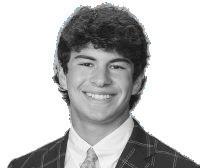
Half-court 3s, mind-boggling one-handed catches and flashy dribble moves — all maneuvers thousands of athletes of all ages emulate after seeing their professional sports heroes pull off flawlessly. And just as they command attention on the playing field or court, they also do when they are off of it. Because of that, no group has a bigger impact on nation-wide culture than athletes.
Philanthropy, community service and leadership can be found ubiquitous in sports figures. However, for every great athlete it feels like there’s an equally prominent figure doing everything but the right thing.
Athletes who abuse women and promote the usage of firearms are often spotlighted because they draw more eyes on talk shows or bring in more readers for a publication. General managers and coaches will frequently deny and turn the other cheek to star players breaking laws and running away from morality to avoid suspending athletes who can help the team win games. Reporters and General Managers who don’t treat situations properly only encourage public opinion toward unconditional love and support for a fan’s favorite athlete regardless of any crime he or she has committed.
The same kid who shoots logo 3s sees the wild fires burning down morality, and instead of trying to put it out, pour gas on the fire. It’s not his fault. He just feels like it is the right thing to do because everyone around him is doing it too.
I know how hard it is to alienate myself from my favorite public figures. Kanye West was my favorite artist of all time and pulling myself away from his music has been and still is a mountainous ordeal. I know I
shouldn’t listen to his music because he has shown time and time again how ugly he is on the inside, but I can’t just unlove his music at the drop of a dime.
No matter what he has done to destroy his reputation, I can’t change how much I have listened to him over the years and how much his words have made impacts on my world perspective. I have listened to his albums over and over and over again and those experiences and memories I made while playing his music don’t go away.
At the same time, I have to dissociate myself from Kanye because I can’t support him no matter what I thought of him before based on how he presents himself to the world now. I have to try to accept that he’s changed for the worse until he has given me enough evidence that he’s improved his character to a satisfactory level. I don’t know what that level is or when that will happen, I think it’s just going to be something that I realize when the time comes.
Similarly, I am the biggest Cowboys fan I know and the Dallas Cowboys are notorious for employing athletes regardless of background good or bad. I also know that I have had to stop supporting certain players on my favorite team because of what they have done and it’s hard, but it needs to be done because we as sports fans cannot treat athletes any differently just because they play for our favorite team.
Even beyond the Cowboys, I have grown up watching and admiring icons like Tyreek Hill and Alvin Kamara who have both committed physical and violent crimes and I have had to work to stop supporting them because what would it say about me if I wore their jersey promoting their brand. It doesn’t matter that they are pro-bowl and all-pro calliber players if they refuse to adhere to the same social standards non-professional athletes demand out of each other.
As fans we have the right and bear the responsibility to hold our favorite teams and athletes accountable for their actions. Without fans paying for tickets, merchandise or drawing in views, sports notoriety would dwindle exponentially.
We have the power and obligation to do that. Fans have to keep the same standard for everyone and hold those standards dearly.
The only way we can stop the spread of destructive sports culture is by fully committing to stopping it with no exceptions.
At school, all athletes in every program are constantly reminded they are standing on a hill with nothing to hide behind and everyone in the community is looking up. We are always aware that everyone is watching even when we think no one is, so that we always think twice before acting.

Being an athlete here is very similar to wearing the blue shirt. The blue shirt sets each senior apart from the rest of the student body and it highlights their every move. Good or bad. Right or wrong. Athletics should be the same.
I am not demanding perfection – that would be impossible to achieve and it would ruin all aspects of life if perfection was the standard. I am just asking for accountability for actions and a fair response to those actions. If an athlete needs people in their corner helping them make better choices then they should be encouraged to get all the help they need so that way the athletes we look up to will fully deserve our admiration. But still, being in the spotlight does not mean you are invincible. In fact, because of the spotlight athletes should be extremely aware and expected to do the right thing. That is something the world of sports seems to have strayed away from, and its time to get back on track.
S
ince the NCAA’s NIL deal began allowing studentathletes to profit off their name, image and likeness, athlete entitlement has become a growing issue.
For Athletic Director Sean Lissemore, the problem has been ongoing for years, including throughout his time in the NFL, where athletes are exposed to fame and millions of dollars at an early age. Lissemore believes they need to surround themselves with the right people to avoid becoming entitled.

“Oftentimes, the people that are around them don’t always tell them ‘Hey, this is not something you should be doing,” Lissemore said. “A
lot of times that athlete doesn’t want to hear that. They want to be surrounded with people that are just going to continue to support them.”
Most recently, Ja Morant’s situation that has showed up in the news is a prime example of an athlete who competes professionally and receives millions of dollars every year acting entitled.
“He was obviously out with friends and that’s not a good idea with weapons, let alone bringing a weapon out,” Lissemore said. “Then also the attention-seeking part. To do what he was doing is bad enough, but then to do it while live streaming is unfathomable. I would say looking at that situation as a whole, there are obviously things to be concerned about from a character perspective.”
Even while it spreads so rapidly, Lissemore believes that it is a problem that can be solved one athlete at a
time.
“In some cases, athletes have been the best at a sport for a very long time and people are always are very supportive of that person. That allows them to do things that they shouldn’t get away with, which builds entitlement over time in certain athletes. It really comes back to who you surround yourself with.”
The most prominently seen entitlement has always been with professional athletes, but it can also be seen in high school sports as well. The fight that broke out between two athletes after the SPC Soccer 4A Championship is an example of entitlement happening at Norma & Lamar Hunt Family Stadium.
“That was really a back and forth between both teams and something that just unfortunately occurred,” Lissemore said. “It spiraled out of control. That’s something that we obviously discourage.”
AIRSOFT
Junior Hayden Meyers found the game of airsoft during the pandemic over Youtube. And, though some see it as a more niche and hardcore version of paintball, Meyers and his friends play with one goal in mind: to have fun.
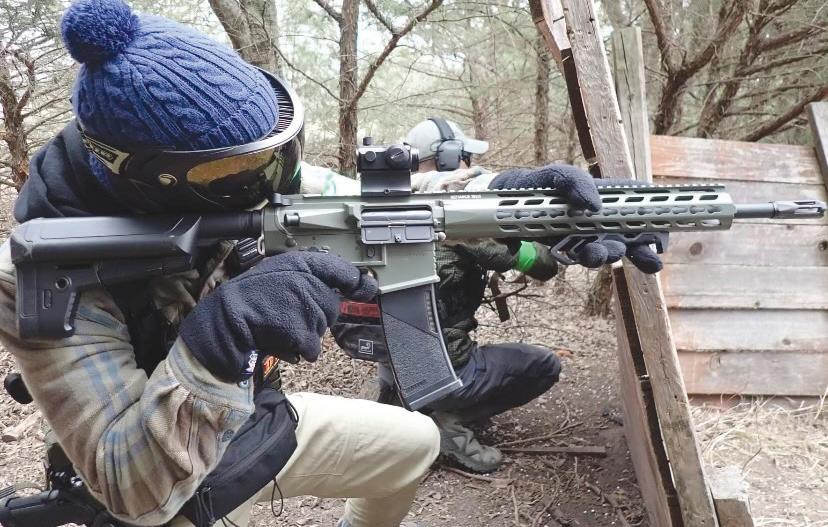
The unforgiving heat bore down on him as he lay flat on his stomach, baking in his tactical gear and trying to avoid the heavy crossfire. His gun felt 20 pounds heavier than when the day started. After hours and hours of intense warfare, he was ready for it to end. Suddenly, he heard footsteps approaching. As he spun around, he stared down the barrel of a rifle.
Within three shots, he went down. And then, he popped back up. A whistle blew, and he high-fived his attacker.
They walked off the field, arm in arm.
Junior Hayden Meyers cites this camaraderie around the game of airsoft, which is a game where players go out to a field with realistic-looking BB guns, as one of the primary reasons he plays.
“It’s very inviting, especially at the fields in Texas, maybe because of the Southern hospitality,” Meyers said. “Nobody makes fun of you for not knowing about it because it’s a hobby, and it’s a pretty niche thing.”
Meyers first found the game through clips online, which opened his eyes to the world of airsoft.
“I saw a lot of YouTube videos [of airsoft], and then the summer that COVID hit, one of my friends was like ‘We should buy airsoft guns and play’, he said. “I bought my first gun, and from there it just got bigger and bigger.”
Another part of the game that appealed to Meyers was the uniqueness and competitiveness involved.
“It’s just a hobby that isn’t really like anything else, and it’s something active that you have to set aside time to do,” Meyers said. “It’s a lot more realistic than paintball, with replicas of guns. Also, a lot of it is skill-based, because as silly as it sounds, you get better every time you go.”
Meyers finds that the lighthearted attitude of the game has helped keep it fun for a wide variety of people.
“I really don’t think that a lot of the guys take it very seriously,” Meyers said. “There’s a group of airsofters who call themselves Milsimmers who act like they’re in the military and go on big long events, and there’s also those guys that just run around and blast music and crack jokes. I think it’s mainly a destressor and nobody I know takes it that seriously.”
And, Meyers thinks that, despite the militaristic exterior to the game, this lighthearted attitude reigns supreme out on the battlefield.
“I don’t think [airsoft] is a violent sport,” Meyers said. “The shots leave little welts and stuff, but your adrenaline is pumping, so it doesn’t hurt that bad.”
In airsoft, there are many options available to players to customize their guns and gear before they go out to play.
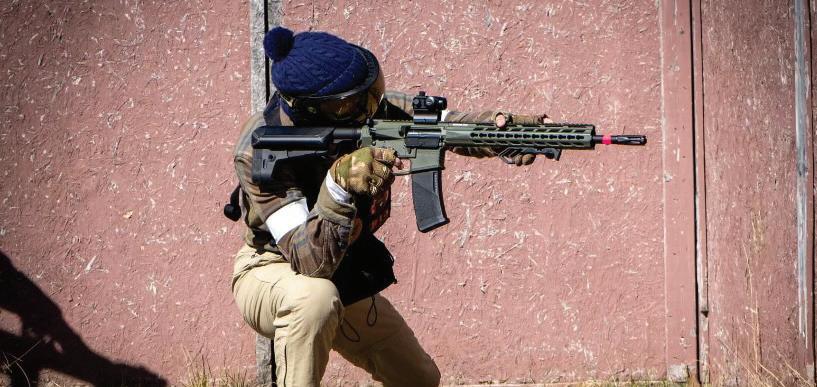
“It’s also cool taking apart and upgrading the guns,” Meyers said. “I’ve gotten into that more recently. Just
> Eye protection/face covering must be on at all times while on the field.
> Measure the force of your gun in feet per second (fps)
> Obey minimum engagement distance rules; these allow softer guns to shoot closer and harder ones to shoot from further away
> No fully automatic fire inside buildings or within 20 feet
figuring out how stuff works and being able to make it better – there’s a portion of engineering to it as well.”
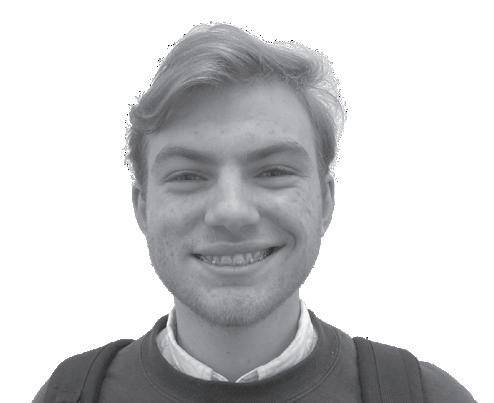
And, as Meyers has gotten more involved, he’s noticed a wider range of ages playing the game.
“There’s guys in their mid-40s, and some people are around 60,” Meyers said, “and then there’s kids that are 12 that you’re also playing with. It’s a good mix, and everyone’s super helpful. They’re just trying to make it as fun as possible for everybody as it can be.”
Meyers has even tried to get his friends involved in the sport, consistently inviting them out to a field some 40 minutes away in Sanger, Texas.
“I always tell my friends and family members about it, because I think it’s a great thing and everyone should be able to have the opportunity to do it,” Meyers said. “I try to go at least once a month with one of my friends. I took my brother out there for the first time this past weekend, and he enjoyed it.”
As the game of airsoft grows, there are many obstacles it has to overcome to become part of the mainstream, like paintball. One of those challenges is that of concerned parents, for which Meyers has some suggestions to combat.
“I would say call one of your local fields, and watch
some videos online,” Meyers said. “As you watch, it gets simpler. It really is just a bunch of guys going out there to pretend that they’re big and strong. But at the end of the day, they’re just guys going out and playing with toy guns.”
And, Meyers wants to reverse the negative media stereotype perpetuated by bad actors in the airsoft world.
“My biggest gripe about the sport is when people promote so much of the negativity, like cheating in airsoft, when that’s maybe 1% of what actually happens.”
Overall, Meyers highlights the importance of the community and the variety of experiences available to airsoft players as a driving force behind why people should play.
“The people in the community realize ‘Hey, we need to be inviting to other people to grow’,” Meyers said. “It’s very make-your-own experience, and it’s a lot of fun.”
Practice, practice and more practice — all in preparation for constant games and tournaments. Waking up at 7 a.m. on a Saturday for a weekend tournament after just playing under the lights the night before is nothing new to club sport athletes. They commit to both their school and club, and the two often coincide, quickly constructing a life of sports, sports and more sports. However, not all club sports are the same. Club swimming does not operate the way club soccer may operate nor does water polo like lacrosse. Each is different, but the commitment, high level of competition and drive to succeed is the common thread that runs through every sport — school or club.
Unlike many other sports, college recruiting in soccer is done solely through club soccer. This leads club soccer to become a competitive, intense environment, whereas school soccer is known as a lower, more relaxed level.
Head varsity soccer coach Corindo Martin has coached the varsity team here for 27 years; additionally, he coached club soccer for various teams in Dallas –both girls and boys – for 27 years.
“I started coaching club in 1986 when Solar went from having dads that ran the team to hiring real coaches,” Martin said. “After establishing the boys’ side, I went and started the girls’ side there and once I got going at St. Mark’s, I coached mainly girls so no one would ever accuse me of having a conflict of interest at St. Mark’s.”
Martin finds club soccer to be very different from school soccer. And, while he acknowledges each has its advantages, he prefers coaching here.
“The wonderful thing about St. Mark’s is that I am coaching kids that I teach, that I advise, that I’ve had on the Pecos, that I’ve worked with in so many different aspects,” Martin said. “The second thing is that I’ve never been under the pressure of if I don’t win, I lose my job.”
Another aspect Martin enjoys about school soccer is the lack of parent interference; in club soccer, though, he didn’t enjoy the same privacy.
“The whole idea that these parents sit in their lawn
chairs and watch this training session is so ludicrous,” Martin said. “But it happens in club soccer, and I used to go out to the fields and see them.”
Sophomore Alden Reagins plays club soccer as well as varsity soccer, and he believes there are advantages and disadvantages to each.
“I would say that club soccer is usually a higher level than school soccer,” Reagins said. “But what comes with school soccer is that you get to play every day during the season and it’s with your close friends. The energy around school soccer is more relaxed than the energy of club soccer, which can help relieve the stress that comes from the season of club soccer.”
Reagins has already begun the college recruiting process through club soccer, where the college showcases club teams attend and connections to college coaches help players tremendously.
“I think the majority of recruiting comes through showcases and reaching out to coaches,” Reagins said. “At the showcases, there are college scouts but they’re not necessarily the coaches that you want. Being able to identify which coaches you wish to approach and then being persistent and showing your interest is very important.”
Martin has tried in the past with mixed success to get college coaches to watch the varsity team play, but he understands that any college recruiting that occurs happens through the club.
"At the end of the year, you look at all these clubs
now and you go to their websites and they’re talking about here’s how many players we have playing in college,” Martin said. “I personally don’t think that college soccer is a very good thing for the development of American soccer, so I’m not a big college fan, but that’s what they do. Nobody cares where you played high school.”
Reagins wants to and most likely will play college soccer, but he acknowledges attending this school allows him other opportunities that other club soccer players may not have.
“I’m not aiming to go to St Mark’s just so I can go play collegiate soccer at a mid-level academic college,” Reagins said. “I would say going to St. Mark’s allowed me less time to play soccer, but it also helps me with coaches because most coaches know St. Mark’s is a highly academic school.”
While Martin appreciates the talent and experience club players that simutaneously play for the varsity program here bring to the team, he is disappointed that club players often miss the pre-Christmas part of the team’s schedule due to club commitments – which leads to a lack of team togetherness.
“In those early games, part of that is the opportunity to bring the unit together and to unify our team,” Martin said. “And if you’re missing a lot of those games because you’re off doing club stuff, it’s difficult and the chemistry isn’t there.”
Swimming is a unique sport with school and club both being extremely similar in almost every possible way from meets to practices.

The only primary difference that affects athletes here are the rules limiting off-season provided provided by the school.
“Swimming is more like most sports in SPC,” head varsity swimming and water polo coach Trenton Calder said. “We have our restrictions where we can’t coach out of season which is fine because we have a number of great clubs in the area. Swimming is an interesting sport. It is quite literally about 99% endurance, with 1% being technique and having the right mentality to do the work.”
Swimmers have the opportunity at any club they choose to join to get as many repetitions in the water as possible outside of school. Another notable aspect of club swimming is the potential for longer practices. Practices at school are much more limited in time whereas club practices can last up to two and a half to three hours.
“In an endurance-type sport, repetition and conditioning are everything,” Calder said.
The only issue with year-round swimming is sometimes swim season can hinder a one’s progression.
“The swim season almost gets in the way of itself,” Calder said. “If you think about something like the Olympics, you have athletes training year round for two races, hoping to shave 1000ths of a second of his or her best time. Now we are asking our swimmers to taper at some point earlier than they may want to, which can have an effect on their bigger national needs which is where they get recognized for college.”
However, water polo, Calder’s supplementary sport, is a different ball game altogether when contrasting club and school.
“Water polo is different,” Calder said. “We are not restricted by SPC rules, meaning I can coach my kids for club. However, I don’t always coach all of them, it just depends on the team I am coaching.”
Even so, there will always be similarities across the basics of improvement regardless of sport.
“The most important thing is that these kids are getting reps and getting to play year-round,” Calder said. “When I see them in the fall I know that they are ready to go.”
While participating in club water polo is not a team requirement, it is highly encouraged for players who want to make a substantial impact on the team’s success during the school season.

“If you look at who is starting for the last, however many years of the program, no one who’s not doing club is starting over the guys that do,” senior captain Sammy Larkin said. “If you are practicing all year round you are going to be a better player than the guy who only plays one season out of the year.”
In addition to improvement for individual athletes, club polo also offers a chance to majorly enhance team chemistry.
“[Club] is a great way to hang out with the same guys all year round,” Larkin said. “I know especially when I was younger, being able to be on the same team all year round with some of the older guys was a great experience. I really looked up to them so it definitely makes club and school polo that much better.”
Another added bonus to playing club and school water polo is the difference in styles of players and coaches.
“They are playing with their friends and having fun, but they are also learning and trying new things,” Calder said. “They get different coaches which is great because our boys hear other coaches say the same thing I say and they go ‘maybe if I’m hearing this from all my coaches, it is something I need to focus on’.”
For lacrosse, the recruitment story is similar to the soccer recruitment process, as it heavily revolves around the club season. As a recruited athlete himself, Head Coach Trey Whitty is very familiar with the recruiting process and its intricacies.
“A huge piece of club lacrosse is the recruiting piece,” Whitty said. “I think when you're at the youth levels, you're not thinking about that yet, and it is about player development, but once a player hits high school, the focus shifts to recruiting.”
This holds true for senior and varsity captain Henry Boykin, a recruited midfielder committed to Bucknell University, whose recruitment heavily revolved around his club play.
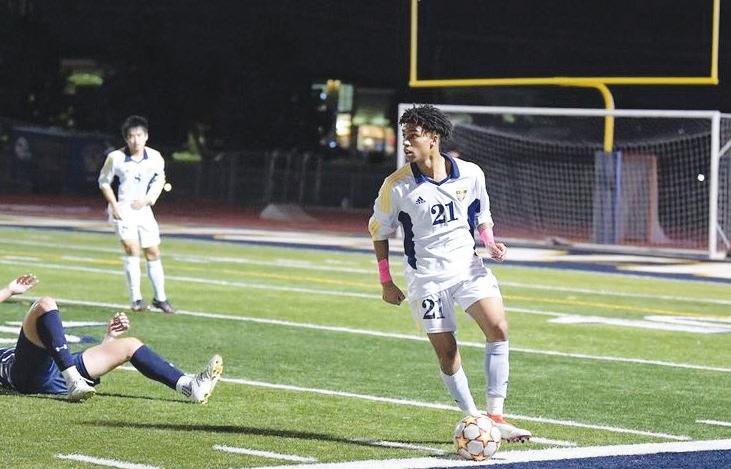
“In terms of just sheer playing, no coach is going to come down to Texas to watch a game, so the club circuit is more beneficial,” Boykin said. “You end up playing much closer to a lot of the strong lacrosse schools, so it is easier to get looks during the club season.”
During the off-season for college programs as well, the summer and fall months of junior and senior years are the crucial windows for recruitment. However, there is recruitment value to be found in high school lacrosse as well.
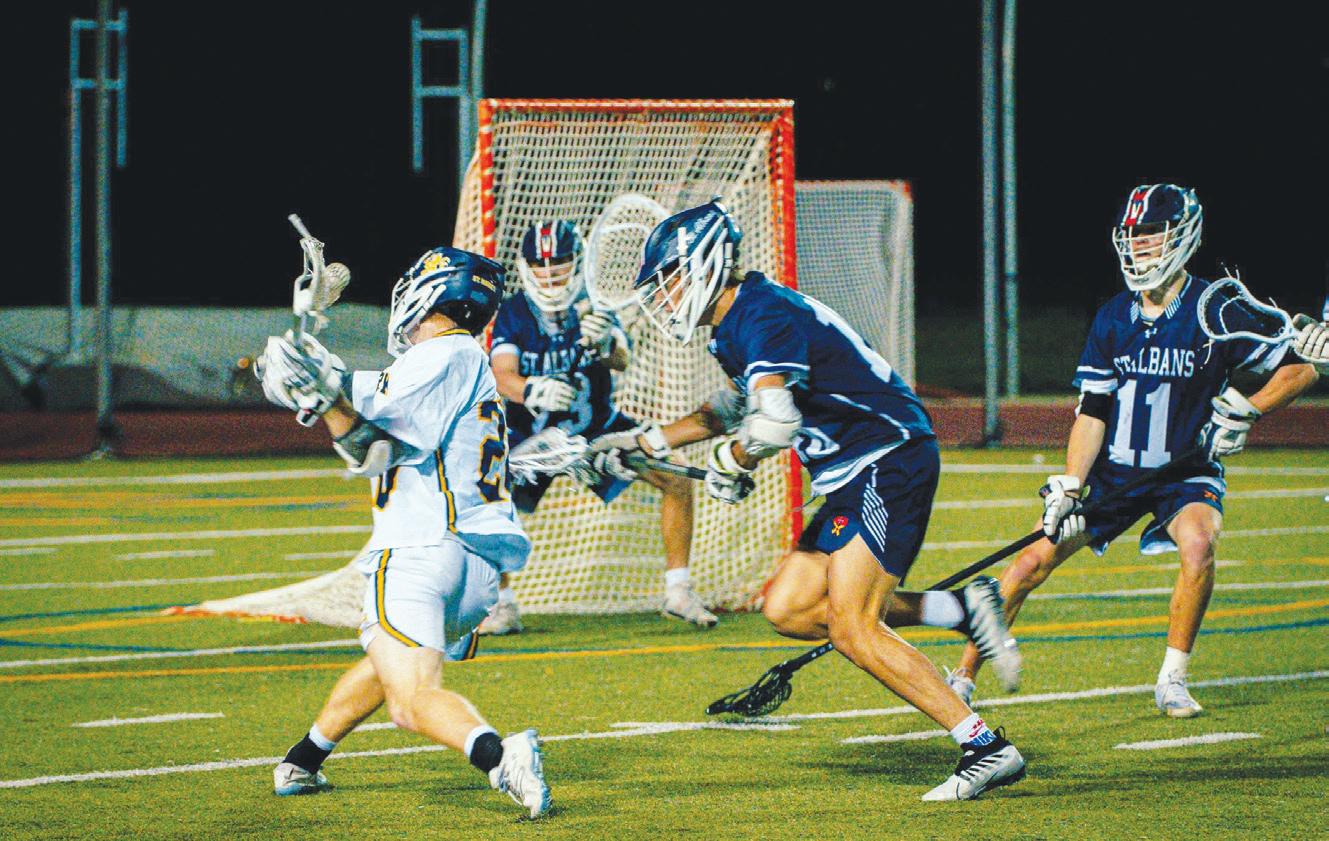
“Obviously, it’s beneficial to have a good high school coach that’s willing to vouch for you,” Boykin said. “High school coaches are an important contact that can
get you looks over the summer or fall.”
For high school athletes who do not prioritize recruitment for lacrosse, the added time commitment that club lacrosse demands is not necessary, something that senior Luke Noack has experience with.

“I started club lacrosse in eighth grade, but I quit the summer before my senior year,” Noack said. “Between summer jobs and football summer workouts, I no longer had the time. I also came to realize that club lacrosse was mainly a tool to get recruited by college coaches. I decided playing in college wasn’t really something I was after, so I changed my focus.”
Continually, the strenuous workouts for both of his sports placed an immense pressure on Noack physically, and this conflict led to the danger of injury.
“I had one summer of doing both Iron Horse [club] practices and morning football workouts with coach Dilworth,” Noack said. “It was very challenging but it was somewhat manageable. I could not participate in the fall season and practices because of football season though.”
Whitty also recognizes that the wrong club is usually detrimental to the lacrosse experience.
“I think if you’re with the wrong club that has poor leadership, there can be conflict with tournaments,” Whitty said. “Some high schools do stuff in the summer and so you can see overlap there.”
For Noack, the biggest benefit that he missed out was the consistent practices over the summer and fall in preparation for the season.
“The biggest benefit was getting live one on one and six on six reps and experience,” he said. “You can do wallball all summer, but to go out and play real defense and practice working with a team is something you cannot do without a club team.”
Whitty also highlights the benefit of engagement with different teammates – something that club lacrosse offers that school cannot.
“It’s always good to play with different kids – I think that helps you grow as a player,” Whitty said. “The competitive level of a solid club program can also be pretty high. A lot of times you’re getting the best kids from around the area so that will raise your level of play.”
Along with the benefits of interactions with other students from other schools, Boykin has taken away many lessons from his experience in club lacrosse and from his experience as a varsity player, showing the impact that the two seasons have had.
“I think that the biggest thing I learned was to not take any game or tournament for granted because you never know who’s watching,” Boykin said. “Coaches pick up the smallest of details, so it is important to always have your best foot forward.”



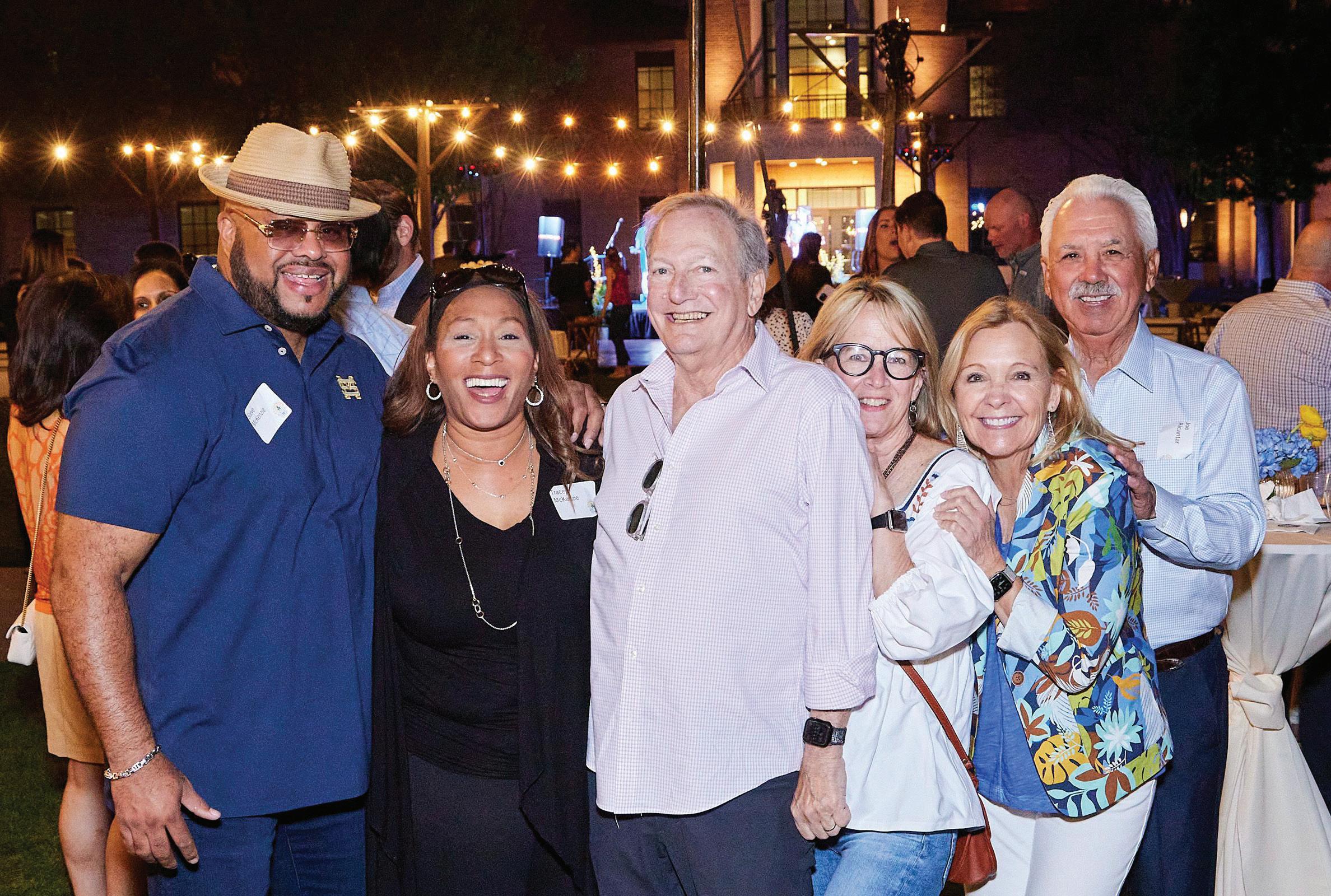
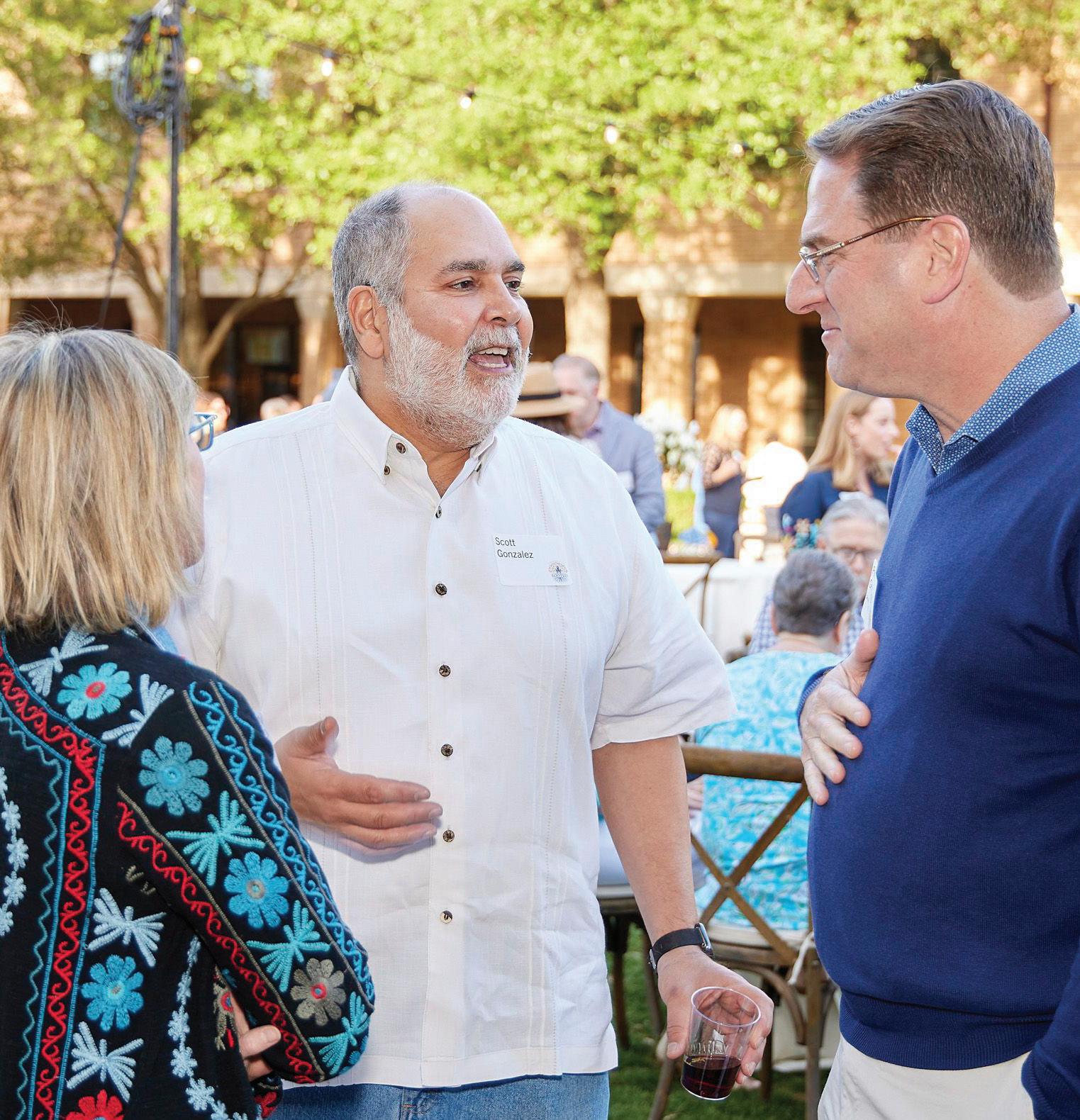
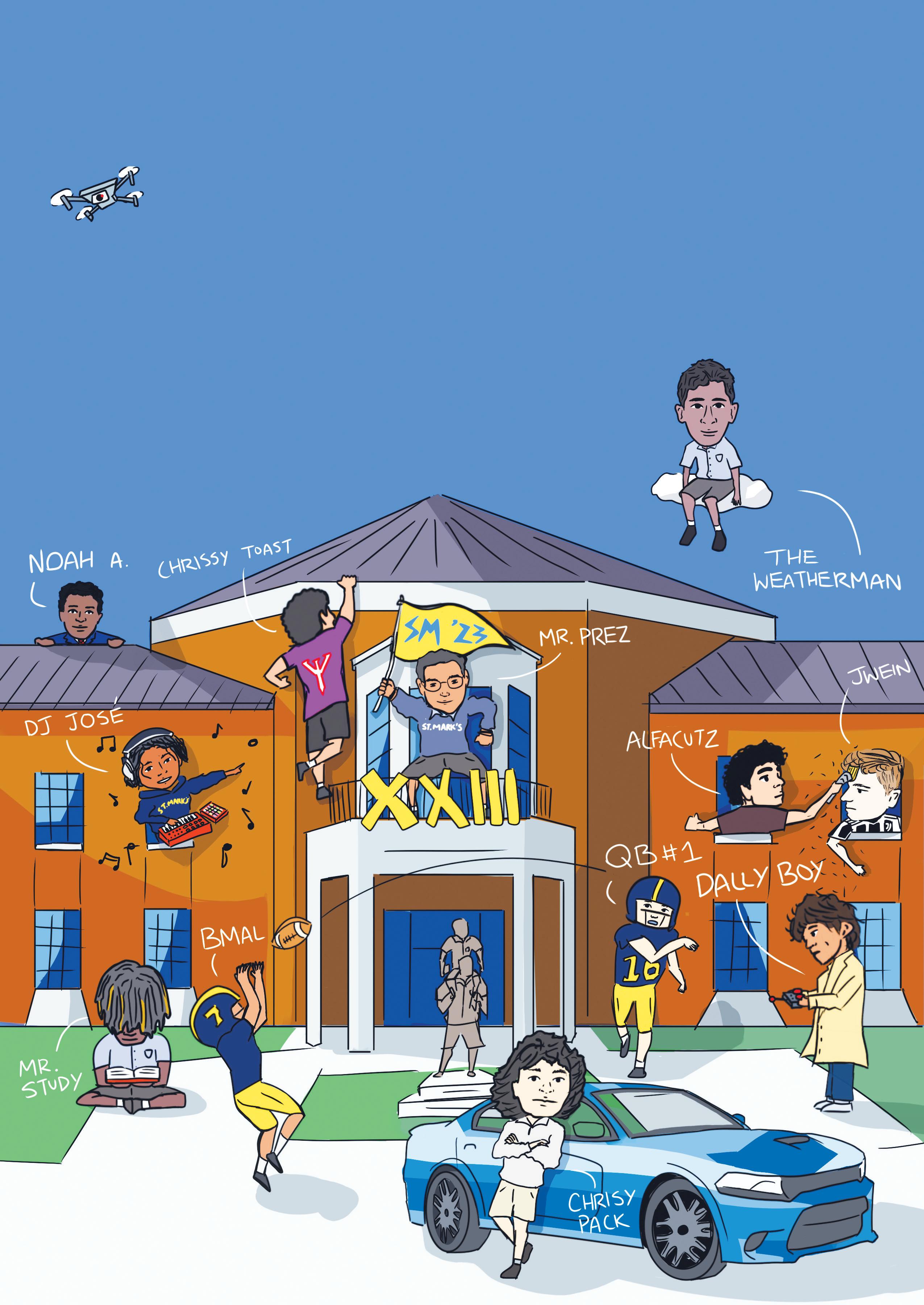
They came in first grade and stayed all the way to the end. Now, as the 24 remaining 12-year Marksmen prepare to leave their longtime home, we asked some to reminisce about their experiences at 10600 Preston Road.

What will you miss most about St. Mark's?
Murphy Paul: I’ll probably miss seeing random people around campus. I know every person around campus, and that small community has really shaped who I am and made every day new and surprising. Going off to a college with a lot more people is going to be a little weird, and I’m going to miss the home that I’ve built here.
What was your favorite memory from St. Mark's?
Thomas Goglia: I was skeptical about Pecos at first. It's like, "Oh, this trip's going to change your life." Okay, buddy. But then you get going–and it's hard–but it gets easier. You're going through it together with people. Some of my friends that I have now, even though they had been going to St. Mark's for a while, are my friends because of that trip.
What was your favorite memory during your time at St. Mark’s?
Grant Evans: I was on the court when we won the SPC volleyball championship in 2021 and that was a really special moment. I’ve never been more hyped up for anything.
What was your favorite memory during your time at St. Mark’s?
Sam Menendez: One of my memories that I look back on very fondly was going to the zoo as a first grader with my buddy. And I’m sure that all the other 12 year Marksmen can say the same.

What advice would you give to your first grade self?
Svanik Jaikumar: Get to know the other 31 people around you because you’ll be seeing their faces a lot. You’ll want to know 31 people like that for the rest of your life. Those connections last for a long time.
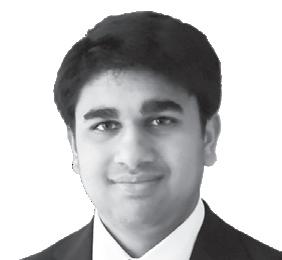
What advice would you give to the upcoming senior class?
Jack Jackson: I’d say enjoy your time and don’t stress about the college admissions process so much. It is a lot easier than what it gets made out to be.


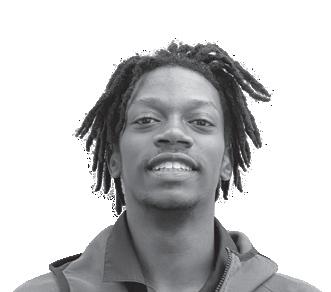
What was your favorite memory from St. Mark's?
Henry Baxter: My favorite St Mark's memory was going to ISAS during junior year and bringing my ceramics pieces. I liked seeing all the other artwork that St Mark's students had done, and it was really amazing.
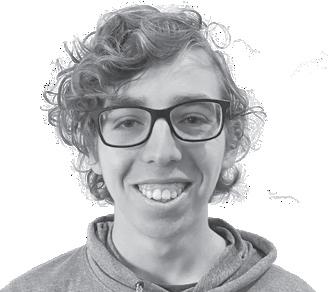
What’s one way St. Mark’s was different from what you expected?
Winston Lee: It’s hard to put into words, but when I was first grade, I looked up to my senior buddy Kellen Nesbitt and the other guys in that class. Those guys were so tall and put together, and that seemed so far away. I didn’t expect it to be like me, and I guess a realization now is that we’ve come full circle. I was surprised that it didn’t take some enormous feat of excellence to get to that point. It was just a process year after year.

What will you miss most about St. Mark's?
Zach Nivica: I'll miss the underclassmen. I've had the pleasure of playing basketball and volleyball with them when I'm free, and it's been really great for me to have a friendship with younger guys and to be a leader and person they can follow.
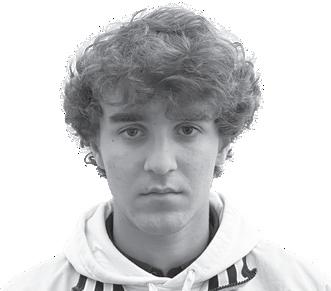
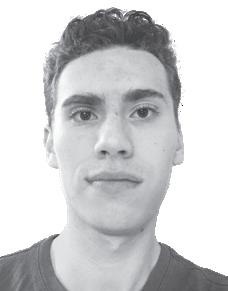
What was your favorite memory from St. Mark’s?
Ross Cunningham: Step up chapel at the end of fourth grade. There was a contest to write a little speech about what you’ve learned through Lower School and what you’re going to take with you to make the most out of your Middle School career. And while Middle School and Lower School are not nearly as important as high school, it was still a really big moment because the people I got to know over those four years were all going through the same thing at the same time. I felt that I was one of the four people to voice what we stood for as a class. That was really fun.
What will you miss most about St. Mark's?
Luke Stallings: I’m going to miss the people the most. After spending 12 years at SM, it’s hard to think about leaving it. Everyone on campus is like a brother to me. I will also miss the relationships that I’ve forged with my teachers and advisors.


What advice would you give to your first grade self?
Aadi Khasgiwala: Find something that you love to do earlier, and do it. Put everything into it. Like don’t try to become a jack of all trades–unless that’s what you want to do–but find one thing and just pursue that and try to become excellent at it.
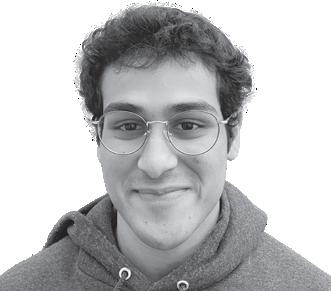
What’s one way St. Mark’s was different from what you expected?
Jack Gordy: I didn’t have much knowledge of what St. Mark’s was at first. Coming into it the first day of school, I just remember wearing a uniform which is new to me. I think it was very organized and very structured, which is really awesome. And we were all super tight as a class.
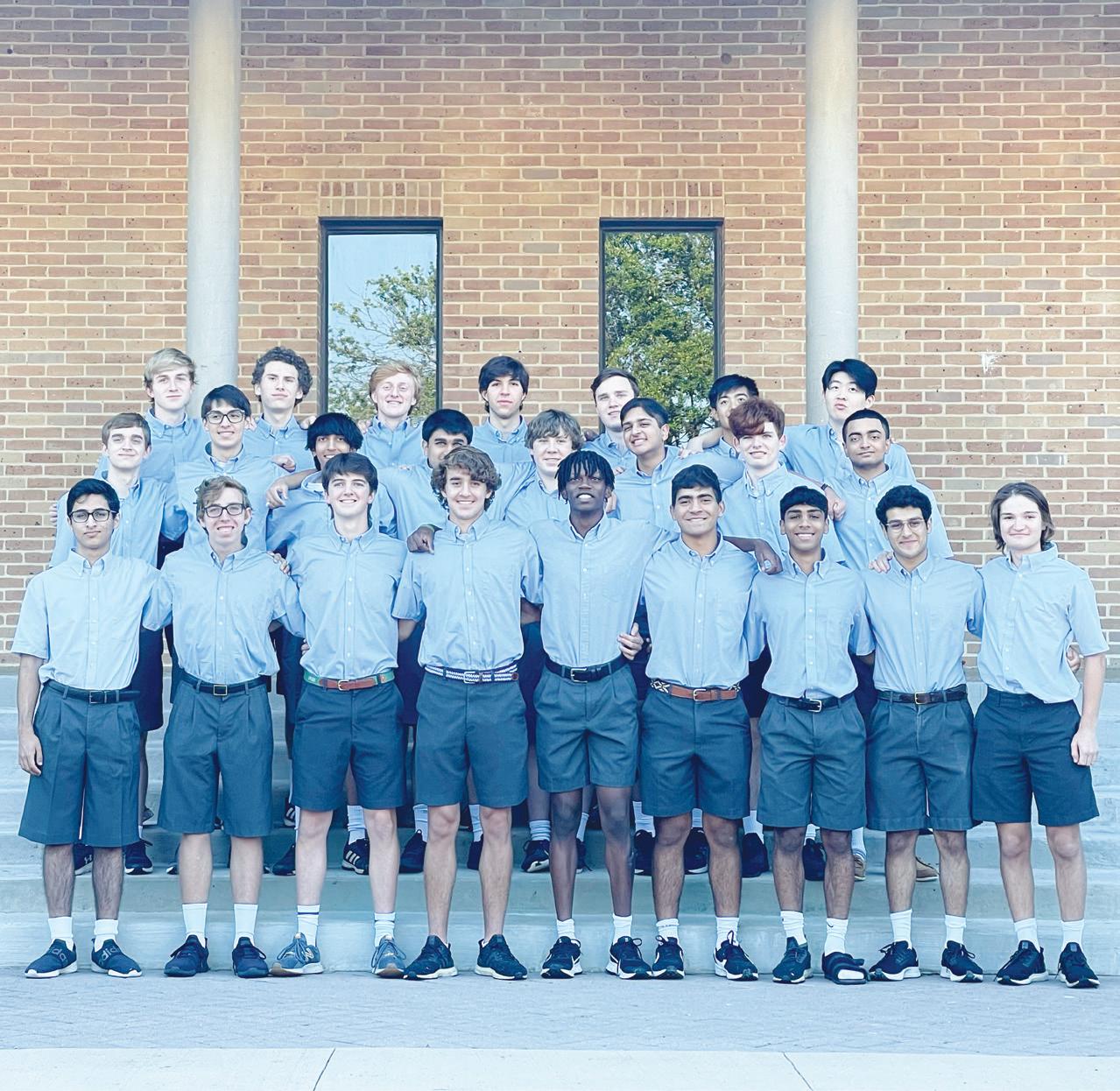
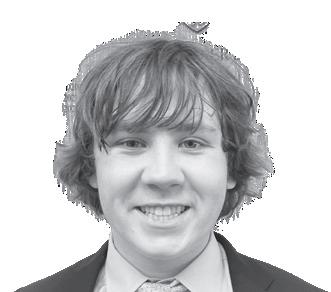
A glance at the most powerful pairs in the Class of 2023.
Shreyan Daulat: How did y'all become friends?
Stice Neuhoff: We met through [senior Jack Cohen’s] baseball team in middle school. Keats came over to my house one day after practice. Keats was best friends with [former Class of 2023 Marksman] Ian Ussery. After Ian left, he needed a new friend, so I stepped up.

SD: How is it being teammates for so many years?
SN: We’re on the baseball and football teams together. But we play completely different positions, so I don’t interact with him often. Keats decided to play linebacker, for some reason, and I played center. When the offense is on the field, the defense is on the sideline, and vice versa, so we’d never practice or play together. In baseball, outfield and infield practice completely differently too. Keats Leffel: That’s kind of like in school.
We’ve never had a class together in our entire St. Mark’s career.
SD: What do y’all do for fun when hanging out?
KL: We play FIFA or Super Smash Bros. A lot of video games.
SN: We also watch movies. What was the movie again with Bradley Cooper and Jenifer Lawrence?
KL: Oh, yeah. I remember. Silver Linings Playbook. Great film.
SN: Also, every time we sleep over, in the morning we’d walk to Snuffer’s. That’s a little tradition of ours.
KL: Yeah we generally just vibe and also play a lot of basketball. We’d play the game ‘21’ for literal hours.
SD: What’s your favorite memory with each other?
SN: Costa Rica was pretty cool. We went there Sophomore year during spring
break. Keats came with my family, and we just chilled. We played a lot of pickle ball on the beach.
KL: For me, I switched to running back sometime this year, so we, in fact, were on the same side of the ball for a period of time. Stice helped me with my new position, and being able to be coached by my best friend was awesome.
SD: What’s the silliest thing you’ve done together?
SN: In Middle School when we’d hang out, we’d just be sitting on the couch. I’d start kicking Keats, and we’d just wrestle.
KL: I remember that. Yeah. Stice actually does wrestling too.
SN: It sounds kind of off when talking about it now, but we liked to wrestle. Like brothers. I never had a brother, and so we’d just be vibing on the couch. And I’d put him in a leg lock or something like that.
Arjun Khatti: How did you two meet?
Silas Hosler: We were on a Park Cities baseball team together in second grade. Murphy just stood out. I knew he was someone I wanted to surround myself with — I could really relate to him.
Murphy Paul: I’d just like to say that I was the better baseball player than Silas back in the day. I could’ve gone really far, but I wanted to give him a chance to be good at something for once.
AK: Who’s the better Fortnite player?
MP: [To Silas] If you say you, you know you’re wrong.
SH: Listen, I have a little saying: WWTD (What Would Tfue Do). Whenever in times of doubt, I think about that. Tfue has fathered me more than my own dad.
MP: The correct answer is me by the way.
AK: Rumor has it that you are two of the most truthful people on campus. Can you explain the backstory behind this?
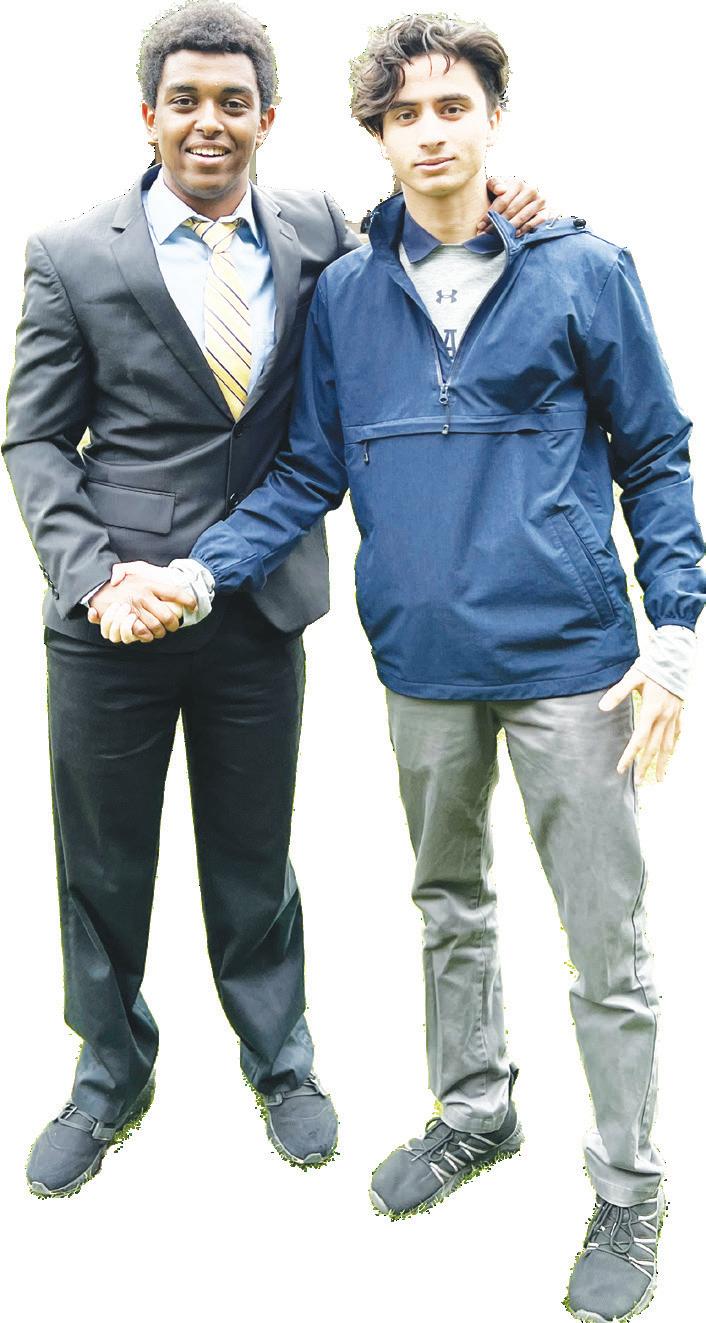
SH: I was in an Xbox party with some friends one time. I said a random hot take and one of my friends just said, “Silas, you don’t miss. I’ve seriously
never heard you cap in your entire life.
MP: See, Silas likes to choose his own nicknames. He just started calling himself the “No Cap King.” Then he started recruiting other guys to join his group. Apparently, I’m the “No Cap Elder.”
SH: I’ll just be presenting in Telos and all the kids are like, “No way! It’s the No Cap King.”
MP: On the record, they have never said that.
AK: Who has the better “drip” (swagger)?
MP: Let’s just say Silas grew up in a household of only boys. And combined they have no drip together. I grew up in a household with women. My mom and sister — they know drip.
SH: It’s funny you say that. As a Baltimore native, having a little swag was necessary growing up. I learned what it’s like to wear a fanny pack. Oh, and the white Vans slip-ons? Dude, I was the one who started wearing those. And all of a sudden, I started seeing them all over the place. I don’t know, correct me if I’m wrong… maybe my drip isn’t that good. But there’s something in me that’s setting the trends. I can’t explain it.
AK: What buddy movie do you think best reflects your relationship?
MP: I think “Good Will Hunting” is a solid one. I feel like I’m Ben Affleck’s character [Chuckie Sullivan,] always looking out for my boy. Silas has a bright future ahead of him, but he’s fiddling around with Fortnite and Snapchat for 17 hours a week. I try to get him engaged in real life. But “Napoleon Dynamite” also comes to mind.
SH: Totally. Murphy reminds me of Kip Dynamite, Napoleon’s older brother. I’m definitely Napoleon because I’m just a lay-low kind of guy, I have fun skills and I whip out a few dance moves here and there.
AK: What are your predictions for each other’s futures after high school?
MP: In three years, Silas is going to drop out of college and pursue a career in education in Montana. He’s basically going to turn into Mr. Adame.
SH: Murphy, let me read your palm real quick. Hmmm… I think you will graduate from Dartmouth and instead of being an engineer, you will fall in love with economics. You’ll end up being a “finance bro.”
Morgan Chow: What’s it like working with each other?
Sal Hussain: It’s fun having Noah around. In our meetings, he brings a balance of humor, but he also brings good ideas, and he will remind the underclassmen when they need to step up. He’s also very helpful for assemblies if I ever need any ideas, or if I need little gestures to make the crowd laugh.
Noah Asmerom: Well, Sal’s the man with the plan, right? He’s really good at thinking long term and macro. I think my role is getting those minor details as he said, like a gesture here or there that can make the assemblies or even our meetings better. Thank you, Sal, for those compliments, but he’s also good in his own right. That’s why he was elected.
MC: What’s your most memorable moment together?
SH: I remember once I got really mad at him and started hitting him. He was like, “Calm down, Habibi.” Then we didn’t talk for like two weeks.
NA: Yeah, he was angry. Last year, when we were running for officers, I remember hearing him play Lil Uzi Vert through
his headphones even though I was 10 feet away. I tried to get him to turn down his headphones, but he wouldn’t.
MC: Which President/VP duo do you compare yourselves with?

NA: I’m going to be provocative: Trump and Pence. That’s what I would compare ourselves to. Sal’s loud, brash, you know. He has the grand ideas and then there’s little Mike Pence just quiet. I’ll throw a detail here or there, but it’s really Sal who does the planning and is the face of it all.
SH: I’d say that Noah reminds me a lot about Kamala Harris.
NA: Don’t do that, come on.
SH: No, just kidding. Definitely Reagan and George H.W. Bush.
NA: Yea, that’s another one. There was one that was clearly more visible. Sal’s a lot more visible than me just at student events.
MC: Red or blue?
NA: Red is a nice color, but I like blue better myself. What about you, Sal?
SH: Oh, red for sure. I like red cars. Ferraris are red and that's cool. Sunsets are red. That’s also cool.
NA: Are sunsets red? I don’t think they are.
SH: They’re reddish-orange, I swear.
MC: What do you dislike about each other?
SH: I don’t mind how sometimes, Noah A. will act foolish in stressful moments, and then it just makes it even more stressful.
NA: That’s actually the opposite of what I think. I think Sal’s worried way too much about things. I’ll give him an idea, and he’s like, “No, no, we're gonna get in trouble.” I’ll just tell him, “It’s just not that deep.”
MC: Give each other a “Most Likely To.”
SH: Noah A. is most likely to steal milk from a homeless person.
NA: What? Fine. Sal is most likely to have an assembly on something really dumb. Just for the fun of it. He’ll find an open assembly in the calendar and decide to do something random from the ninth grade. Like a car show as an assembly.
SH: Oh, yeah.
NA: Oh no, he actually wants to do it now.
LAST RIDE On the last day of junior year, the Class of 2023 finally put down the white shirts and threw on their new uniform for Blue Shirt Day.
From sports to campouts to dances, the Class of 2023 has bonded through all aspects of the Marksman experience. Now as they prepare to say their goodbyes, we take a retrospective glance at the 12 years of memories they’ve made.
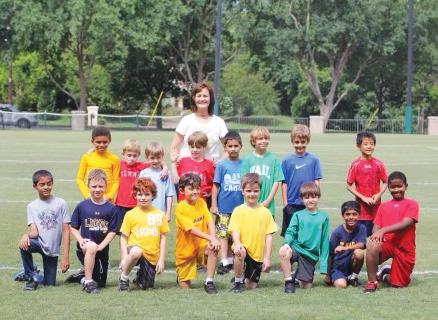
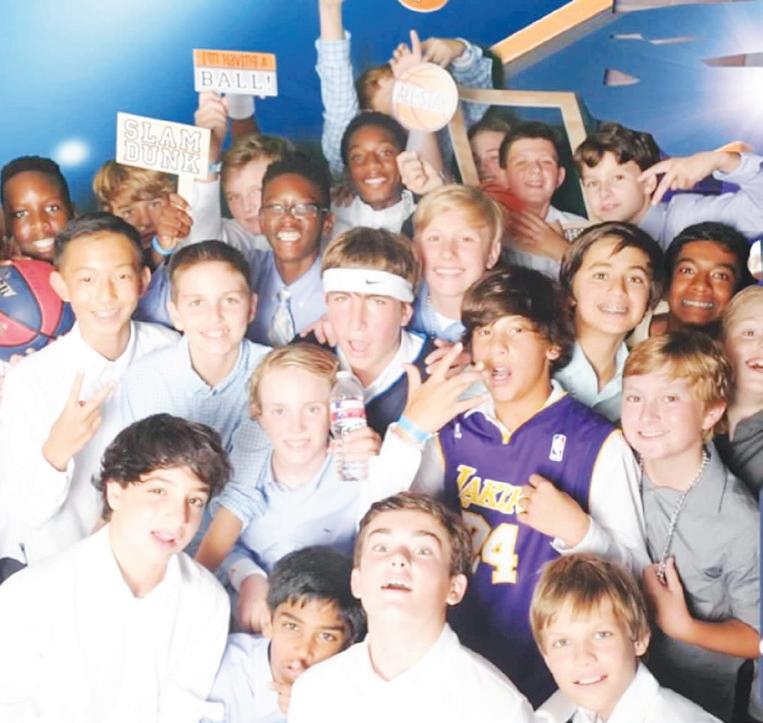

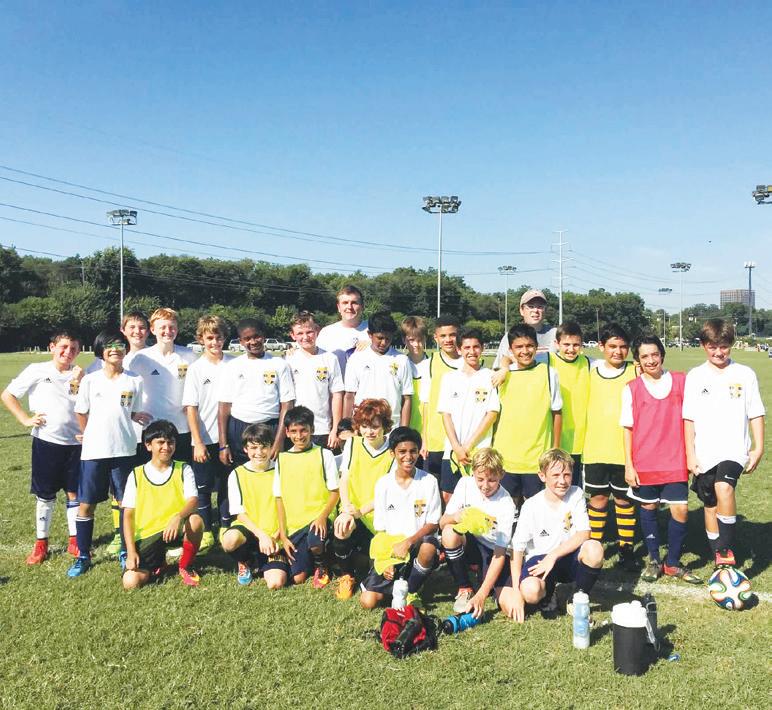
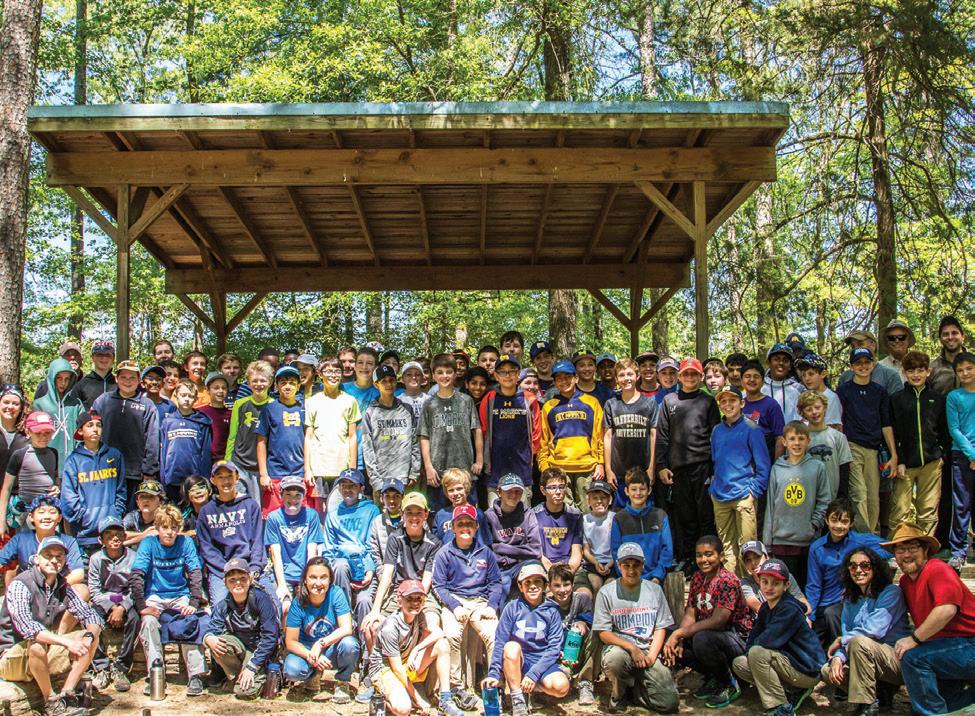
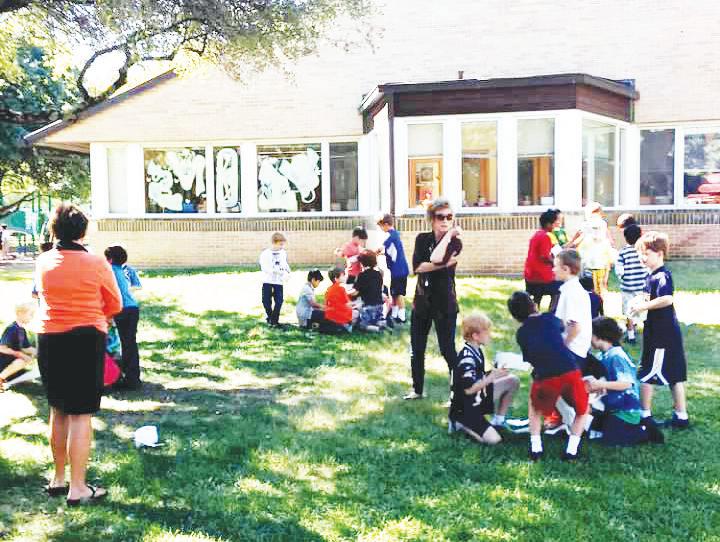
2011: The beginning After a memorable first year as Marksmen, the Class of 2023 took part in Blue and Gold Day. The end-of-year event involved games for the entire Lower School, in which color-coordinated teams competed against each other.
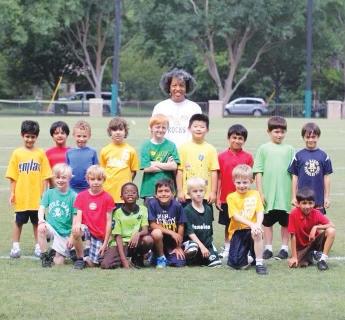

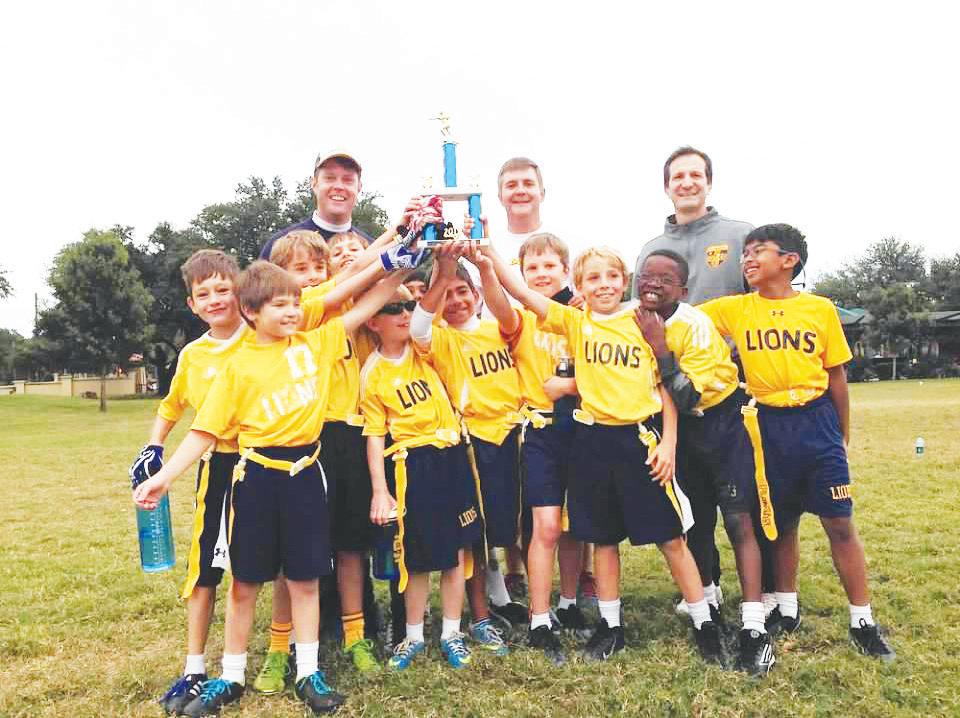
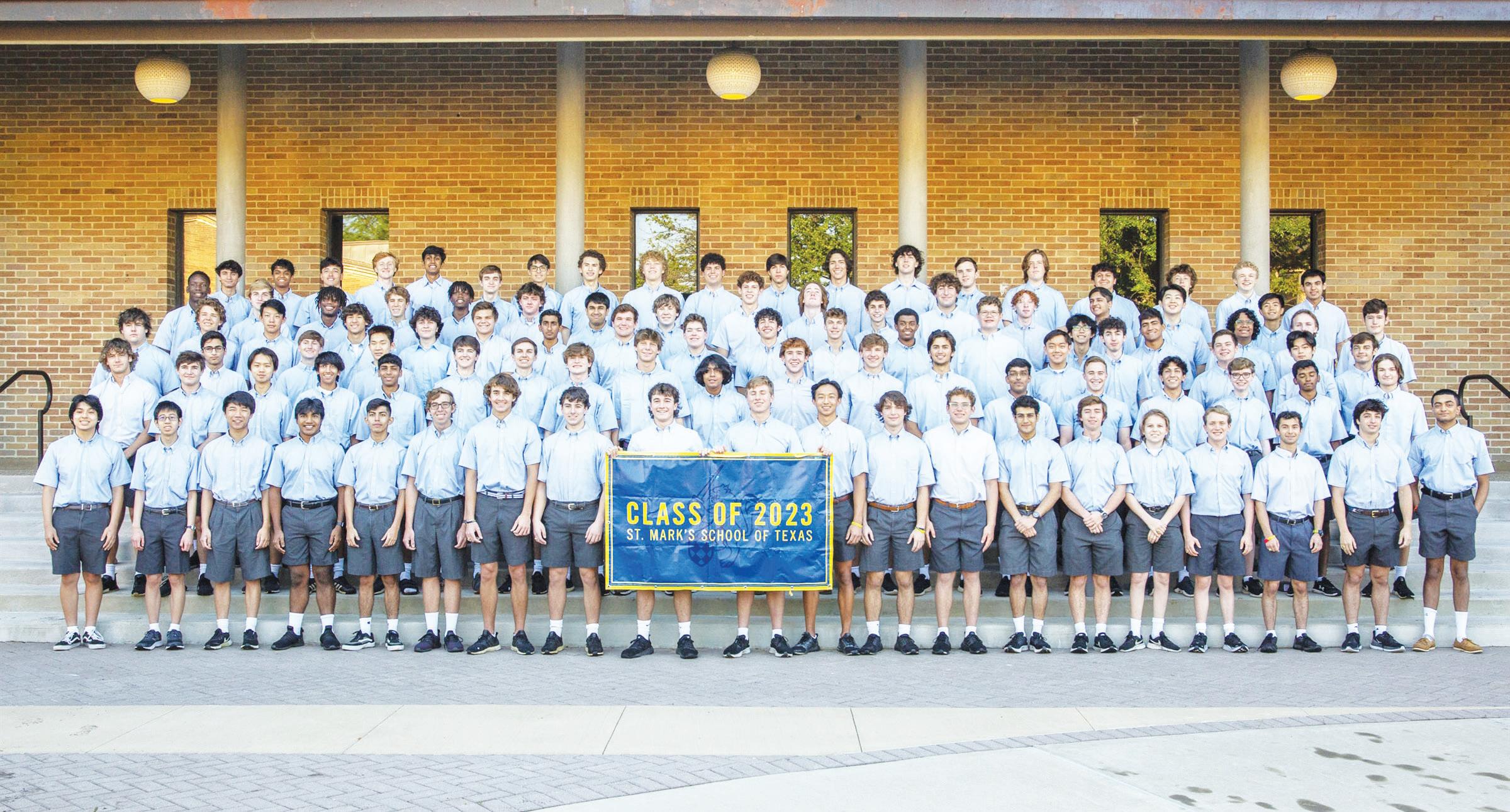
party On Halloween, the class had a festive mummy
2012:
2019: Pecos trip Now Upper Schoolers, the class went into the Pecos wildnerness for a 10-day camping trip.
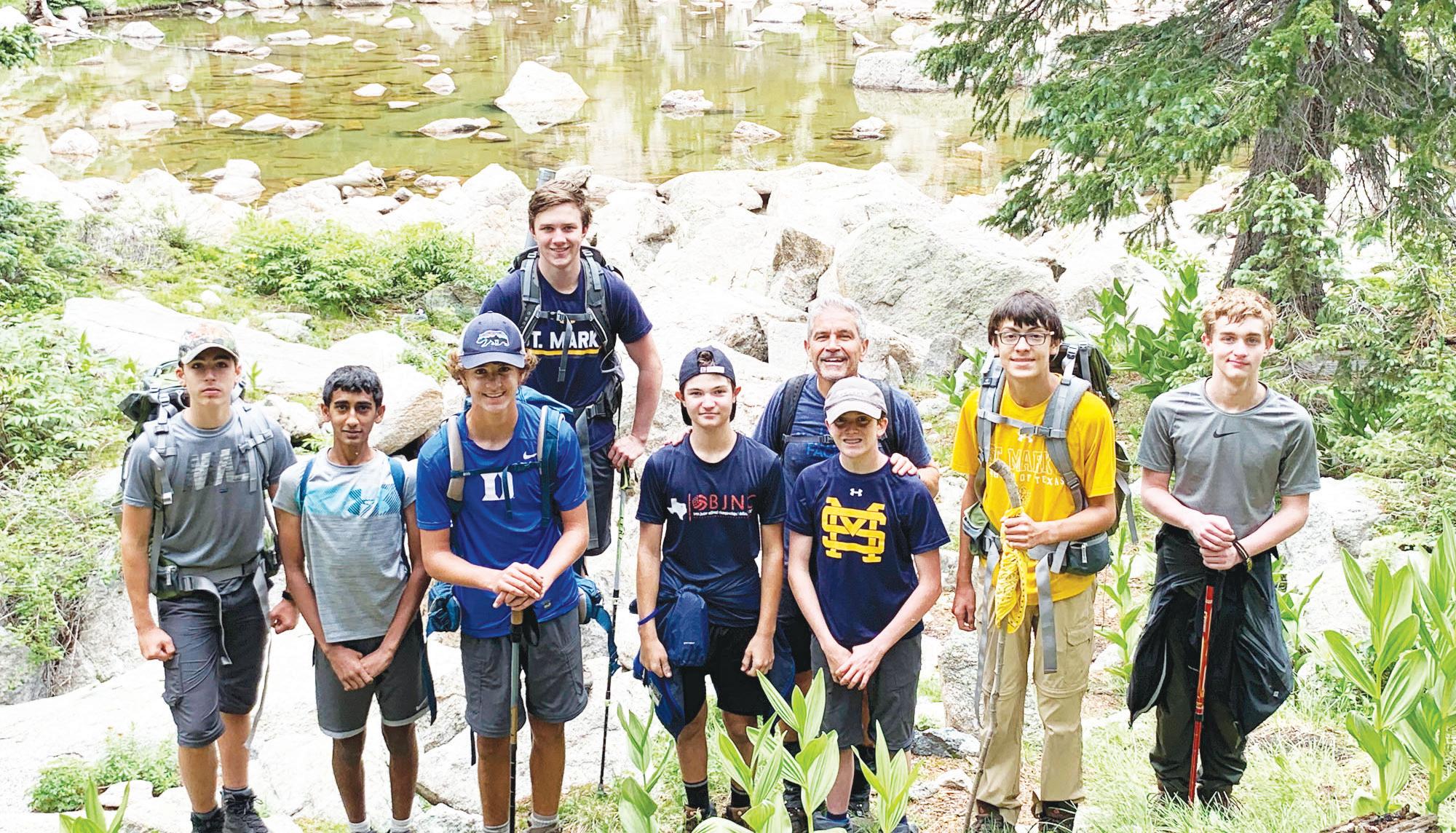
Sept. 2022: Friday night lights
Seniors kick off the year strong as they cheer on the Lions in their first game of the year.
Oct. 2022: Animal blessing
Seniors and their buddies brought their furry companions to this ceremony.
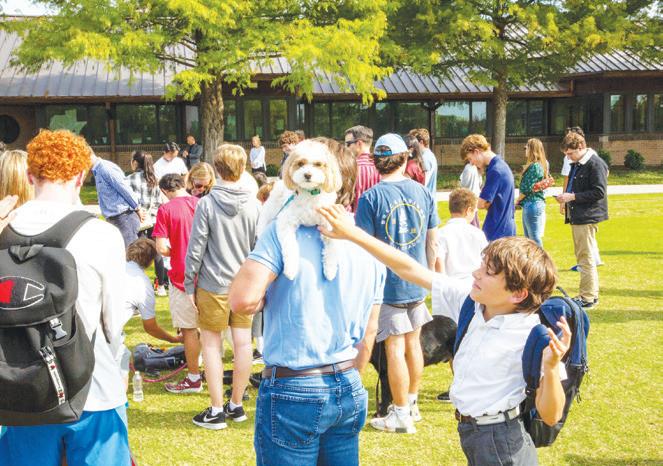
2021: Grandparent’s Day Even during COVID-19, the class still celebrated this tradition with their families.
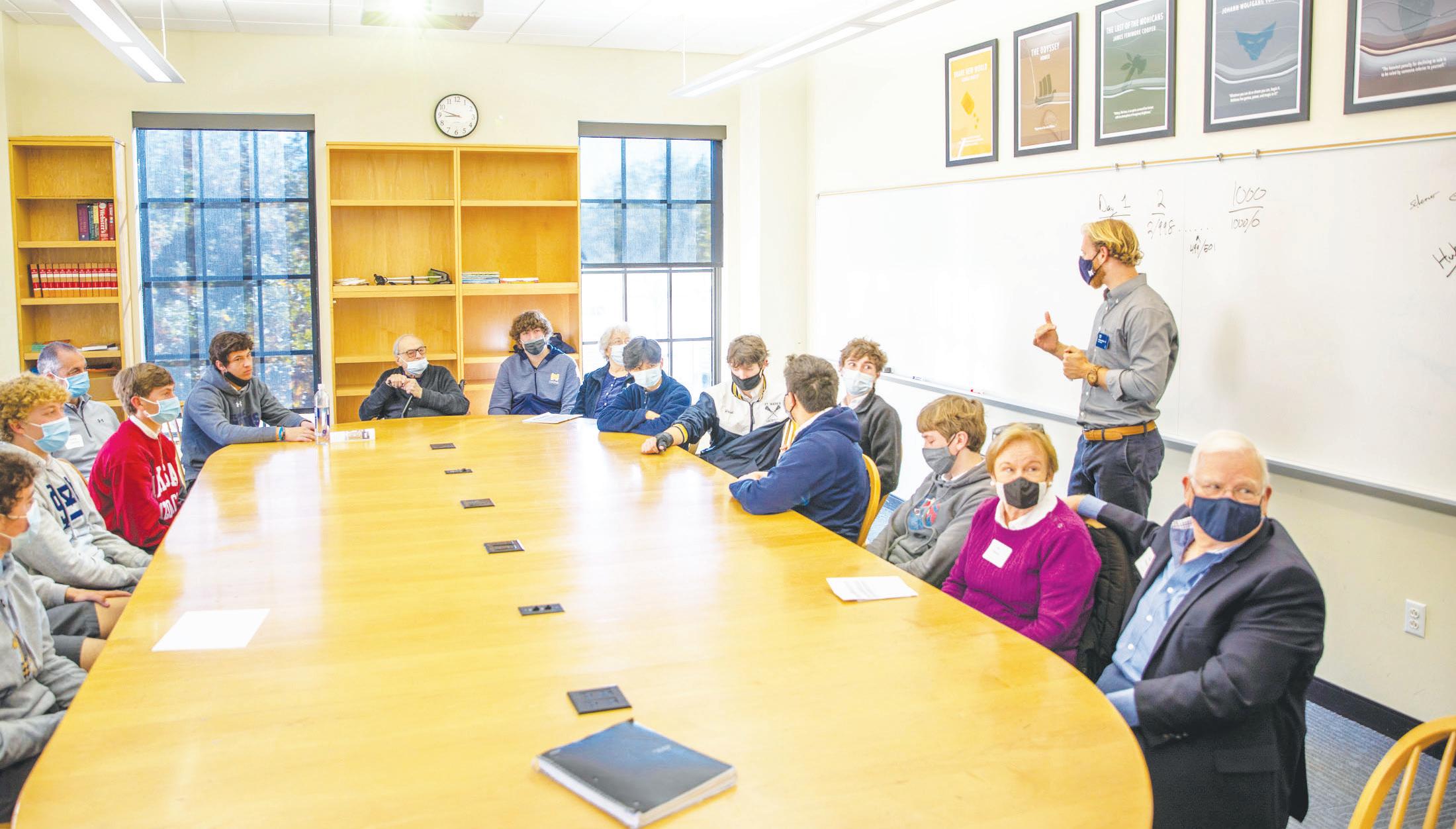
Oct. 2022: Homecoming Seniors roared during the Homecoming pep rally, hyping up the Lions for their Friday night game.

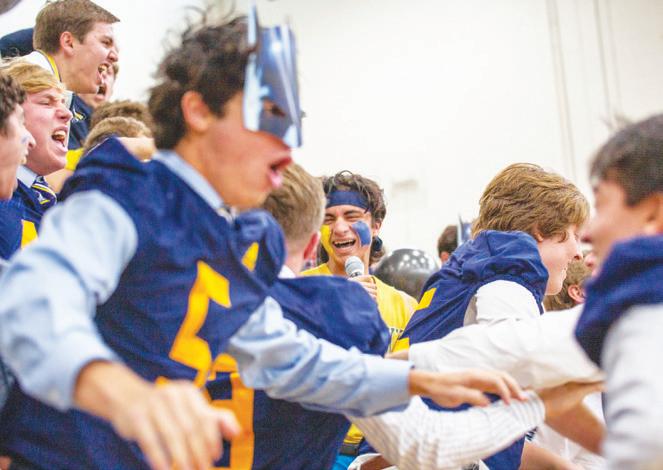
2021: McDonald’s Week The class organized the annual McDonald’s Week to raise money for Austin Street Center.


Nov. 2022: Decorations During Thanksgiving break, seniors put up Christmas decorations to prepare for the holiday season.
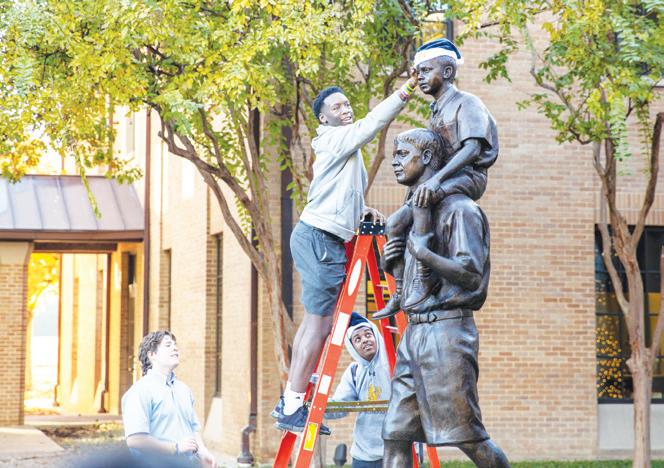
Dec. 2022: Holidays Seniors carried their Lower School buddies across the Great Hall as part of the All-School Christmas Party.
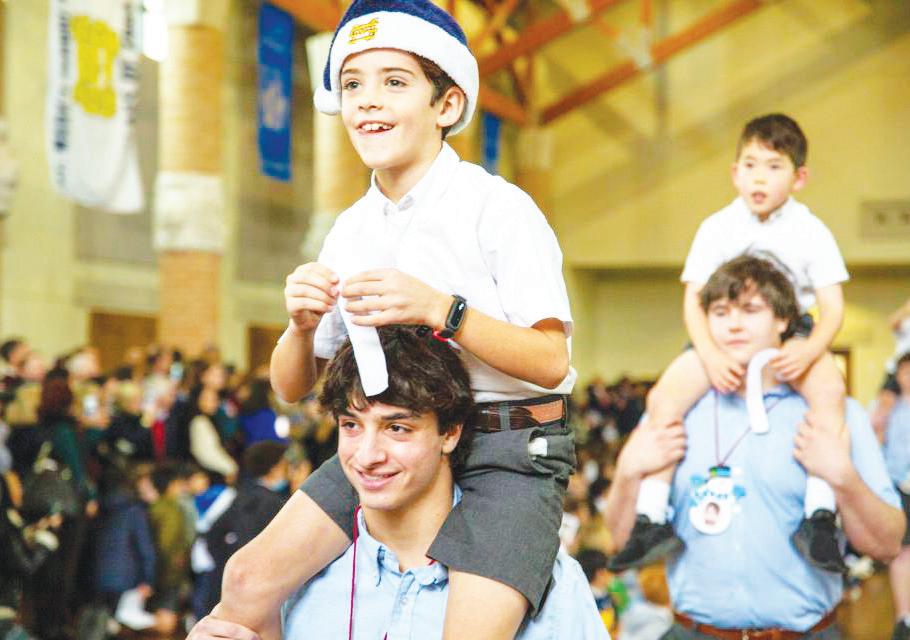
LOCKED
Teachers watch students come and go, but some strike quite the impression. Over time, they get to know Marksmen more as men and not just students. Teachers even have ideas on where these students will end up.

Do you hear that? It’s thunderous applause…and it’s for José Jiménez as he accepts his second Emmy Award of the night. This one is for music supervision; the first was for Music Composition for A Limited Or Anthology Series, Movie Or Special (Original Dramatic Score).
Since his first speech had a lot of heartfelt thanks and deeply touching personal stories, he’s opting for a few well-placed jokes in this one. He sticks the landing by supervising the end of his acceptance saying, “I’d like some exit music please.”
Then he thrusts his hands into the air like Tár to cue the orchestra and walks off.
Mic drop. Boom is out of the shot.
It may seem like a meteoric rise for a big sound guy who has both the E and the G of the elusive EGOT, but he’s been grinding.
His good friend and dentist, Dr. Martin, says he grinds in his sleep. After graduating near the top of his class in RTF at UTAustin, he sound-mixed and boom operated before he decided to develop game that rivaled 12 time all-star Hakeem Olajuwon. That’s right he opened a post-production studio.
He built a yurt-shaped building with audio facilities with his own bare hands right
in his back yard so he could be closer to his gecko, Dude, and his poodle-mix, Geek. In that studio he dominated the indie space, scoring and designing beats for darn near every SxSW darling.
How he had time to develop his hobby of Bonsai-shaping and become a world-class curler…I have no idea. That’s to say nothing of starting his charity sending hearing aids to the needy.
Ultimately, José decided to take his talents to Santa Monica Beach. From there he has been riding audio waves higher and higher. The next step…his own clothing line ‘Big Sound Guy’ launching fall of 2038.
T

he force is strong with this one. Not only is he an academic weapon, but his chicken fried rice is also FIRE and FORCE.
While slaying academics at George Washington, Master George also makes time to fine-tune his culinary skills.
After graduation, George is casually recruited into foreign policy due to his finesse and emotional IQ.
Of course, his culinary skills win the recruiters over as well. Pushing aside the opportunity to pursue a James Beard Award, George focuses on improving the world.

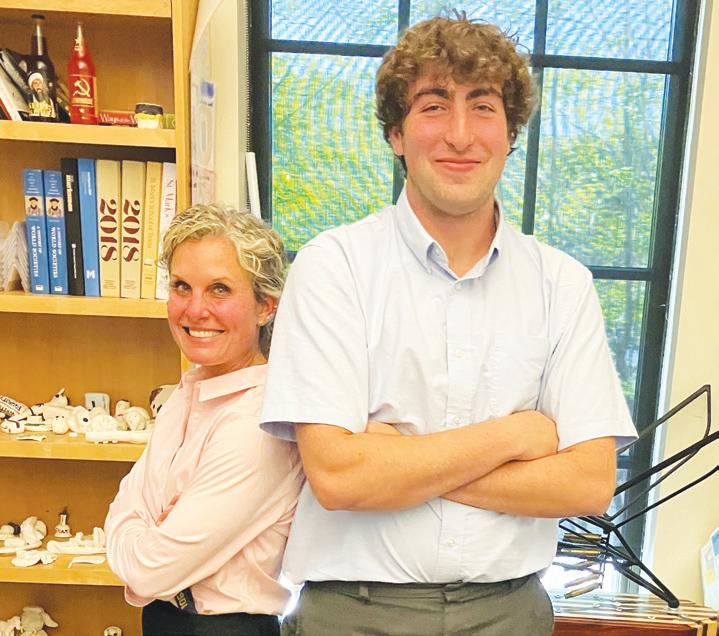
Naturally, he makes this decision hunched over a drawer of LEGOs, creating endless shapes. Within hours of meeting with the top dawgs of NATO, the UN, and all other major letter organizations, George unanimously is chosen as Master George of Earth. He graciously accepts this title, but with one caveat, he accepts this title as an advisor role.
Master George views the international world order wisely and knows he can mediate significant issues.
And guess what?
Putin compliments Master George’s
chicken fried rice after a long meal together and removes the Russian troops from Ukraine.
Jinping high-fives Master George and proclaims that Taiwan should be independent. Turning inwards and focusing on domestic issues, Master George ends violence within America’s borders.
And just like that, the guy who plays with LEGOs loves soccer and basketball and loves to cook world peace. He is him.
He is Master George.
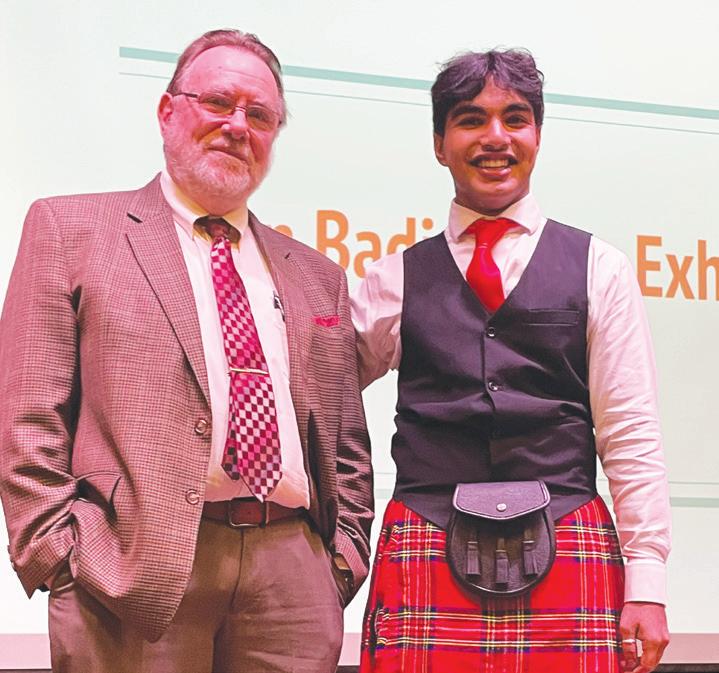
The title says it all, excepting the subject’s perverse determination to become involved in politics at some point in the future.
STUDENT AND MENTOR Westrate introduces Badi at his senior exhibition.
But as his history teacher as well as his advisor, I try to dissuade Arjun from that course. For while it’s true that he checks all the requisite boxes: articulate, deeply read, intrinsically honest, keenly analytical and relentlessly honest, I would argue that such a clutch of virtues disqualifies him as a politician. For politicians shrink from all such encomia, content in their dishonest, prevaricating, jargon-addicted, illiterate, innumerate, thick-headed venality.
So, while Arjun is eminently suited to achieve the summit of any field to which he aspires, following that pathway will provide the additional advantage of not having to chance either his integrity or his good name in the process.
For my money, I hope to rendezvous with Arjun at my office years from now, to hear about the books he has authored, the myriad religions he has catalogued, the treaties he has negotiated, the children he has raised, not to speak of the royal funerals he has honored with his bagpipes. Few politicians aspire to such things or would be remotely capable to
Perhaps appropriately so, Nat will attend university in the shadow of our nation’s capitol.
There he will thrive and acquire an education that extends far beyond the classroom. He will use a diverse work experience that already varies from food services to the automotive industry to acquire knowledge that he will readily apply to all facets of his life. He will extend his schooling so that he can refine his abilities and sharpen his mind, rather than as a means for certification to a more lucrative vocation.
Curious, intelligent and resilient, Nat will be an adept problem-solver who develops contacts and establishes the resources necessary for personal and professional growth.
His tact and diplomacy will be assets in the political arena and his proficiency and pragmatism will make him accomplished in the private sectoxr.
His powers of assimilation will allow him to blend seamlessly into a more traditional corporate setting; however, the quality of his work and the gentleman that he is will stand
out should he venture into the realm of think tanks or start-ups.
The force of his personality and the degree of his conviction will make him a coveted ally and a formidable adversary.
As if from a Graham Greene or Tom Clancy novel, Nat will be the protagonist of his own making; however, unlike those fictitious characters, his theatre of choice will be the virtuous and altruistic, rather than the nebulous and nefarious.
Our St. Mark’s Everyman will be so much more.
doing any of them, the availability of ghost writers notwithstanding.
Arjun’s father, a very successful and very wise man, once encapsulated his astonishing son to himself: “You are a better version of me who will live long after I die. You will go on to wonderful achievements that I will never be able to imagine. That is why I take care of you.” And while Arjun and I are not related, as his teacher, I most assuredly conclude that I couldn’t have said it any better myself. So, I harbor little doubt that one day (were I so inclined) I will be tempted to brag that I knew him when.
GOODBYES
In their final cycle on The ReMarker, the seniors on staff say their farewells to each other and to the program. Memories and inside jokes abound. Prepare the tissues.
Position: Editor-in-Chief
From the staff: The head baka of our newspaper has spent his nights and days toiling to create the most rigid and strict publication in history. Although we sometimes crack under the pressure of the extremely structured, work-oriented and food-free classes you oversee everyday, we still appreciate your constant texts to Will and various other side characters of this newspaper over whether they have finished their spreads yet. You have kept the sussiest Pubs Suite in history completely free of outside invaders and established our dominance over the yearbook so completely that they refuse to even play us in the Ice Bowl while we have you at QB. Shreyan, thank you for your late nights, dedication and constant hard work in creating our favorite Volume 69 of The ReMarker ever!
Response: Thanks, bakas. I hope I haven’t been too hard on y’all. It’s incredible how invested everyone is in leaving our mark on this paper and making it our own, and for that I couldn’t be more grateful. I’ve thoroughly loved all the late nights in Pubs with Morganius and with Rondo on aux, trolling with Dillon and Myles and the sports goons Ben and Nolan in class and — indeed — spamming Spencer with texts to turn in his stuff. This has been the most memorable year of my life, and I owe that to you all. Thanks for everything, you guys, and good luck on the next four. Zack, keep the paper remarkable.
Position: Managing Editor
From the staff: Arbón Arbón. It’s no surprise the most wellbehaved student in the history of Acting 1 made such a great managing editor. You would never reh-wahd George and destroy Chah-lie because you don’t have an AMPUTATED SPIRIT!
True to the name of Rondo, you kept an amazing sports section in junior year and in your senior year moved on to the higher art of minion-corralling and making sure there will actually be an existing newspaper when the print date comes around. We’re just going to sit back and let you cook when it’s time for Endzone, but we’re sure, with your experience of being an incredible writer and leader, that it won’t be a peanut butter and jelly sandwich.
Response: I’ll admit, my acting skills may have been a little outta ordah at times. I just wanted to see if Mr. Trask knew who the hell he thought he was talking to! But I’ll move on — thank you for those kind words. Whenever my efforts had to shift to managing the wayward younglings on staff, you seniors stepped up and did some much-needed heavylifting, which I greatly appreciated. And don’t worry guys, I’m almost done with my recipe for Endzone, and with y’all as my sous chefs, it’ll be a 5 star meal.
Position: Managing Editor
From the staff: Morganius. Morgani(s)us. We are so happy you decided to be good at art however many years ago. Without you, we’d be constantly scrambling for graphics and creative visuals every cycle. But with you, we can sit back and relax knowing you’ve got it covered. We’re also glad you returned to the newspaper after taking a break last year to focus on some other things. But seriously, your contributions this year have been nothing short of brilliant. We’re excited to see you continue your Lion Pride at Columbia, and we really hope you use your God-given talents in your profession — they are one-of-a-kind.
Response: Thanks guys I really appreciate it, especially that pun. I’m so happy y’all have made me sleep-deprived and dangerously dependent on caffeine this past year. But for real,
it’s been a joy. I can’t believe it’s all coming to an end. Even though I left the newspaper hanging last year, I’ve grown closer much closer to y’all as a senior. Super excited to see ONLY photographs appear in the upcoming issues. Seriously, don’t call my line when I’m living it up in NYC. I will not respond. Peace boys.

Position: Executive Content Editor
From the staff: We’ll always find our content editor sitting right in Jenny’s chair when we need enlightening sports info or up-to-date college decisions. Thanks for holding down the podcast and a social media presence for the newspaper (we’ll call @smseniors23 a ReMarker-affiliated account). We’re not sure how the newspaper could ever even function without your totally punctual attendance in first period classes and dedicated cultivation of Endzone. Dillon, thank you for always being such a friendly presence in class and having a great playlist. We hope Keshav fixes your toothache.
Response: Not sure what I’m going to do knowing someone else is going to sit in Jenny’s chair next year. Maybe I’ll just take it down to Austin with me. But in all seriousness, boys, it has been an honor working with y’all. I’ll never forget the memories I made around the Harkness table, or the conversations we had in the Editor’s Office. Still waiting for us to finally settle the trash talk and win the Ice Bowl, though.
Position: Assignments Editor
From the staff: The king of the minions. “B-ian.” All sophomores tremble and quake in fear when they hear the highest-dumbbell-bench-pressing man on staff coming their way on the story due date. But your completely rigid enforcement of deadlines with absolutely zero exceptions ever just might overshadow some of your other contributions to the paper. Your dedication all around the newspaper and especially on Focus last year carried us through our toughest moments, and you’re always willing to lend a hand and be a great friend to everyone on staff. We know you’ll be just as smart, friendly and hardworking in New Hampshire next year!
Response: Thanks fellas, y’all are too kind. Don’t mistake my hard-line policy about your grades for animosity, I love this newspaper and every staff member on it. Shreyan too, even when he doesn’t turn in beats on time. True, I may not be as artistic as Morgan, as expeditious as Aaron, or as ginger as Will, but I’ve always been committed to delivering quality production schedules exactly on time for almost the entire year. Journalism was hard work (especially Focus, I feel your pain Myles), but you guys always lifted my spirits on the darkest of work Saturdays. Can’t wait to see y’all again later on down the line.
Position: Front & Center Editor
From the staff: Red! It’s the color of passion. Rage. Immaculately designed centerspreads. We can always count on you having your spread ready, uh, sometime in the future, although we’re concerned about where you are going to sleep from now on, now that you can’t use the Pubs Suite next year. Your refined taste in picking out the absolute worst French electronic music we have ever heard in our lives has strengthened our ears so that no terrible EDM will ever phase us again. But, really, Will: You are the most distinctive personality on the paper. Your arguments, contributions and fantastic work on our most important stories all add up, and The ReMarker would never be the same without you.


Let me tell you about Mortimer Mouse. In 1928, Walt Disney needed a new star cartoon character, and eventually ‘Mortimer Mouse’ was created. Lillian Disney, Walt’s wife, suggested a more catchy name, ‘Mickey Mouse,’ and the rest is history.
Eight years later, two writers wrote a film called “Mickey’s Rival,” in which Mickey competes with the antagonist, Mortimer, for Minnie Mouse’s hand in marriage. Mortimer’s character had come to life after all.
Though he was secretly conniving and arrogant, he was known for his huge, boisterous personality.


Seventy-five years later, Mortimer Mouse was revitalized again — this time in the form of a St. Mark’s first grader. Tasked
Response: I think it will surprise nobody to learn that I paused designing centerspread for a moment to write this response. Thanks for the compliments on past centerspreads; some have been better than others, but each was hard-fought. You all don’t need to worry about where I’m going to sleep from now on. With the power of Bang™ by my side, I don’t think I’ll need to sleep for at least the next four years. And yes, red might be the color of rage, but — with the Hibernian power vested in me from on high — I declare that today red is the color of goodbyes, the color of old friends and the color of GREAT electronic music. Journalism has been a lot of things, and I’m not quite sure how to process all of it, but I do know one thing: It’s been real. Back to designing center I go.
Position: Focus Magazine Editor
From the staff: Myles — our faithful Focus foreman and crafty columnist. Your very serious political commentary wows us every cycle, and your contributions to the Opinions Section have revealed all your greatest strengths. We bet you’re super bummed to say goodbye to all your favorite American politicians next year — maybe you’ll find some new friendly faces to admire up in England. Aside from your obsession with politics, you’re a joy to be around. Your whimsy in and around the Pubs Suite is paralleled in the Black Box, where you carry our Acting I class as the only guy who actually knows what he’s doing. We’d love to see you continue acting in the future — we think you have the makings of a star.
Response: When I joined The ReMarker, I was just a guy with terrible political opinions, an inability to turn in columns on time and no access to the server on my falling-apart laptop with InDesign on Essentials mode. But nearly three years later, I’m now…uh, actually let’s skip this part. Thank you all for becoming some of my best friends through all our time on staff — the good thing about working on a newspaper is that we can always look back in the future and see everything we accomplished in our time together. I swear on my Texas flag I will never, ever get a British accent!
Position: Head Photographer From the staff: Charlie, you really know how to capture a moment. A paper is only as good as the visuals it has. Your photos are always top quality, and we appreciate all the times you responded to our crazy assignments. It is no surprise you were nominated to YoungArts. While we had our fair share of miscommunications over the year, we’re glad that you stuck with us. Wherever you head off to next year, make sure you bring your camera!
Response: Thank you guys for the opportunity to be a part of the staff this year. After learning how stressful the deadlines can be, I’m honestly pretty impressed that y’all were able to stick with it for all four. Despite the occasional miscommunication, I always had a great time running downtown for a classic traffic shot after practice and awkwardly standing up for a photo during assembly and chapel. Thank all of you again for the work you put in, and I’m honored to have been a part of the leadership this past year.
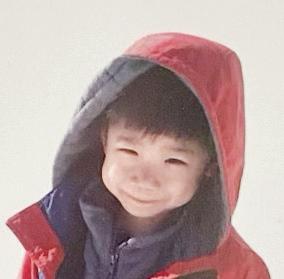
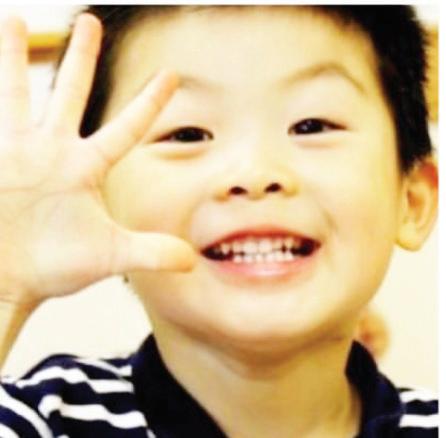
Position: 10600/Culture Editor
From the staff: Aaron. GOAT. Liu. Shreyan’s favorite. You may be the most Non Playable Character on staff, but your reliability and kindness easily makes you one of the most wellliked. The Pubs Suite has turned into your second home — you
with documenting the life of Walt Disney for a year-end project in my first grade teacher, Ms. Yarbrough’s class, I — with significant urging from my parents — put on a mouse onesie and a black fedora hat.
“Hi, everyone. My name is Mortimer Mouse, and I’m here to tell you about Walt Disney, my creator.”
I mean, what better way to tell Disney’s story than through the original character that would ultimately bring Disney unprecedented fame?
After my presentation, I distinctly remember Ms. Yarbrough asked me a compelling question: “Where has ‘Mortimer Mouse’ been all year?”
Just a few months earlier when I first started St. Mark’s, no matter how much my parents pressured me, my timid self could’ve never imagined standing in front of a class for a few minutes and presenting, let alone dressed up as a cartoon character.
I experienced that transformation into a more confident self in just my first year at St. Mark’s. The past 12 years have brought about similar transformations in me.
Attending Telos meetings as a fourth grader, I found role

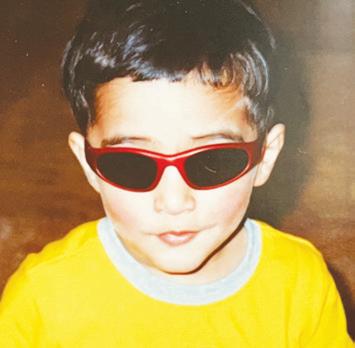
practically live there, taking breaks from journalism to host group calculus study sessions. We can’t help but overhear the excessive “Troll this. Troll that.” back-and-forths. But, we bear it because we know that when it’s time to get stuff done, you’re consistently the first up to bat. We still don’t know why or how you turn in pages two days early every cycle — that kind of psychotic behavior is simply unheard of on The ReMarker. For real though, thank you for always being there when we need you, and for producing top-tier work every single deadline. You truly are an editor’s dream.
Response: I would’ve gotten a rookie to write this but Nik said he was busy so I guess I’ll have to manage this solo :P. It’s pretty hard to summarize my three brief years in just a blurb. Whether it’s sitting through 14 pitch days, CMYK-ing fifty-some pages, or speedrunning spreads in half a free period, I’ve had so many memories I don’t want to forget. I’m truly grateful to have taken my chance on The Remarker, and while you may not see my name in the paper again anytime soon, I’ll be sure to stick around. After all, there’s no better place to troll than the Pubs Suite.
Position: Staff writer
From the staff: Dr. Nik — our second most Non Playable Character on staff. Your vast knowledge in the science world has done wonders for the paper, and we’re not quite sure what our Environment & STEM coverage would look like without your abilities of inting, trolling, ulting and everything else that you and Augustine do in that phone game. But we all know your role extends far beyond just one section. We like to think of you as the staff’s 6th man — any time a section editor sells the bag, you’re always there to sub in and get the job done. You definitely remind of us of a Manu Ginobili or a Jamal Crawford — sorry if you don’t know who those people are, but trust us, it’s a compliment. Anyways, we will dearly miss your presence and wish you the best of luck in medical school.
Response: It has been an honor as the resident degenerate Wild Rift player on staff. Thank you for all of the midgame phone calls, naps in pubs and so-called “trolling” from behind the monitor in the back. I don’t know how I’ll survive without Keshav’s out of pocket conversation starters, Morgan’s annoyance after he gets mencolek’d for the third time in a day or Aaron’s insistence that I get off League and write the column that’s due tomorrow, but I think I’ll manage. Wherever we find ourselves next year, just remember we’re the group that put this together. Through all the scuffed extensions and last-minute page edits, we did it. Stay strong gentlemen, and no matter what it is, keep doing it.
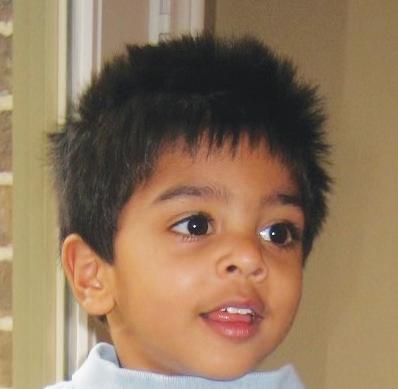
Position: Staff writer
From the staff: Keshav. Keshav? Keshav! You there? We hope you’re doing well. No — really. If you ever get around to reading this, we want to let you know that you’re still on staff. Thank you for leading all the editorial meetings that you scheduled — they were very productive, just like you on Work Saturday. All jokes aside, many of us have known you for over a decade, and we know you will accomplish great things in the future. Now turn off the soccer game and respond to this.
Response: Thanks, fellas. And let me tell you, it’s been a blast, unlike my viewing experience as a Leicester City fan this season. It’s been a sinking ship all year, but with our horrible manager fired, I look forward to better performance under better leadership. Even if we’re in the English Championship next year, I’ll find solace in the amazing work of The ReMarker, which I’m sure will continue to accomplish great things in the future. Well, I’m signing off and turning on the match again. Peace.
models in older Marksmen. I learned what’s expected as you mature.
Middle School was a time for experimentation. I tried different clubs, various electives. I went on the choir’s tour in England with some of my closest friends. The Pecos before ninth grade bonded the class of 2023 together.
In Upper School, the journalism program has allowed me to have conversations with people across campus and to learn intricate things about the school and those who comprise it.
No one transformation has been more important than the other. Every aspect of this institution challenges its students to strive for discovery and excellence, and there are many things I have yet to learn.
But there’s one thing I know for sure: my time at 10600 Preston Road will be the most formative years of my life.


To answer your question, Ms. Yarbrough: There’s always been a ‘Mortimer Mouse’ inside of me, deep down. I’ve always had that confident side. This school brought out that part of me, just as it’s brought out the best in me over the past 12 years.
For that, all I can say is thank you, St. Mark’s.
Shreyan Daulat — signing off.
A look at where the Class of 2023 will be headed next year. Scattering all across the country and beyond, these Marksmen are ready to embark on the next phase of their education.
Sam Adams
Adam Alfalahi
Noah Asmerom
Blake Backes
Arjun Badi
Casey Bajec
Henry Baxter
Roome Becker
Rowan Belvin
Hudson Bloom
Jake Bond
Henry Boykin
Matthias Canon
Julian Carlson
John Charest
Morgan Chow
Jack Cohen
Ross Cunningham
Ian Dalrymple
Nikhil Dattetreya
Shreyan Daulat
Ishaan Devalla
Henry Dobbs
Charlie Estess
Grant Evans
Chase Fisher
Nat Fisher
Ethan Gaertner
Michael Gao
George Genender
Aditya Goel
Thomas Goglia
Jack Gordy
Will Grable
Radford Green
Aaron Greenberg
Jacob Grossfeld
Renil Gupta
Spiros Hallax
Silas Hosler
Sal Hussain
Jack Jackson
Svanik Jaikumar
*List subject to change. Waitlist decisions not included.
Johns Hopkins
Tulsa UT Austin
Cornell UT Austin
Babson
Northeastern
Brown
Cornell
Vanderbilt
UT Austin
Baylor
Dartmouth
UPenn
UT Austin
José Jiménez
Logan Johnson
Brendan Kelly
Aadi Khasgiwala
Arjun Khatti
Andrew Kogan
Keshav Krishna
Oliver Lambert
Sammy Larkin
Harrison Lee
Winston Lee
Keats Leffel
Aaron Liu
Myles Lowenberg
Blake Malouf
Anthony Martinez
Pierre Martinez
Sam Menendez
Hayward Metcalf
Rapha Mitterer-Claudet
Akash Munshi
Stice Neuhoff
Henry Nichols
Zach Nivica
Luke Noack
Bijaan Noormohamed
Noah Norton
Jake Park
UT Austin
Sewanee
Bates College
UChicago
Northwestern
Emerson College
UC Berkeley
UT Austin
Southwestern
UT Austin
Purdue
Brown
Rhodes College
Vanderbilt
Williams College
U of Oxford
UNG
Ohio State
Texas A&M
SMU
Embry Riddle
Navy
West Point
Florida
Wake Forest
Cornell
Notre Dame
SMU
Arizona State
Florida State
W&L
Vanderbilt
Princeton
Texas A&M
Air Force
Sky Park
Murphy Paul
Aidan Peck
Jonah Perez
Akash Raghunathan
Matthew Reed
Rishab Siddamshetty
Bowden Slates
Branden Song
Neil Song
Will Spencer
Trey Stager
Luke Stallings
John Tagtmeier
James Thomson
Miles Thornburg
Christian Tsvetanov
Zane Wallace
Alex Wang
Anthony Wang
Grant Warnecke
Jacob Weinstein
Sewanu Whenu
Jackson Whittaker
Asher Wilburn
Ian Williams
Dillon Wyatt
Christian Youst
Tommy Zheng
Northwestern Brown
Notre Dame
Richmond
SMU
Texas A&M
Brown
Texas Tech
UC Berkeley
Michigan
USC
Dartmouth Columbia
Yale
Amherst
UT Austin
Miami
Lehigh
Villanova
U of Bristol
Notre Dame
UT Austin
Indiana
Harvard
U of Cambridge
UT Austin UVA
WashU
Arizona State
SMU
SMU
Rhodes College
UT Austin
Rice
UPenn